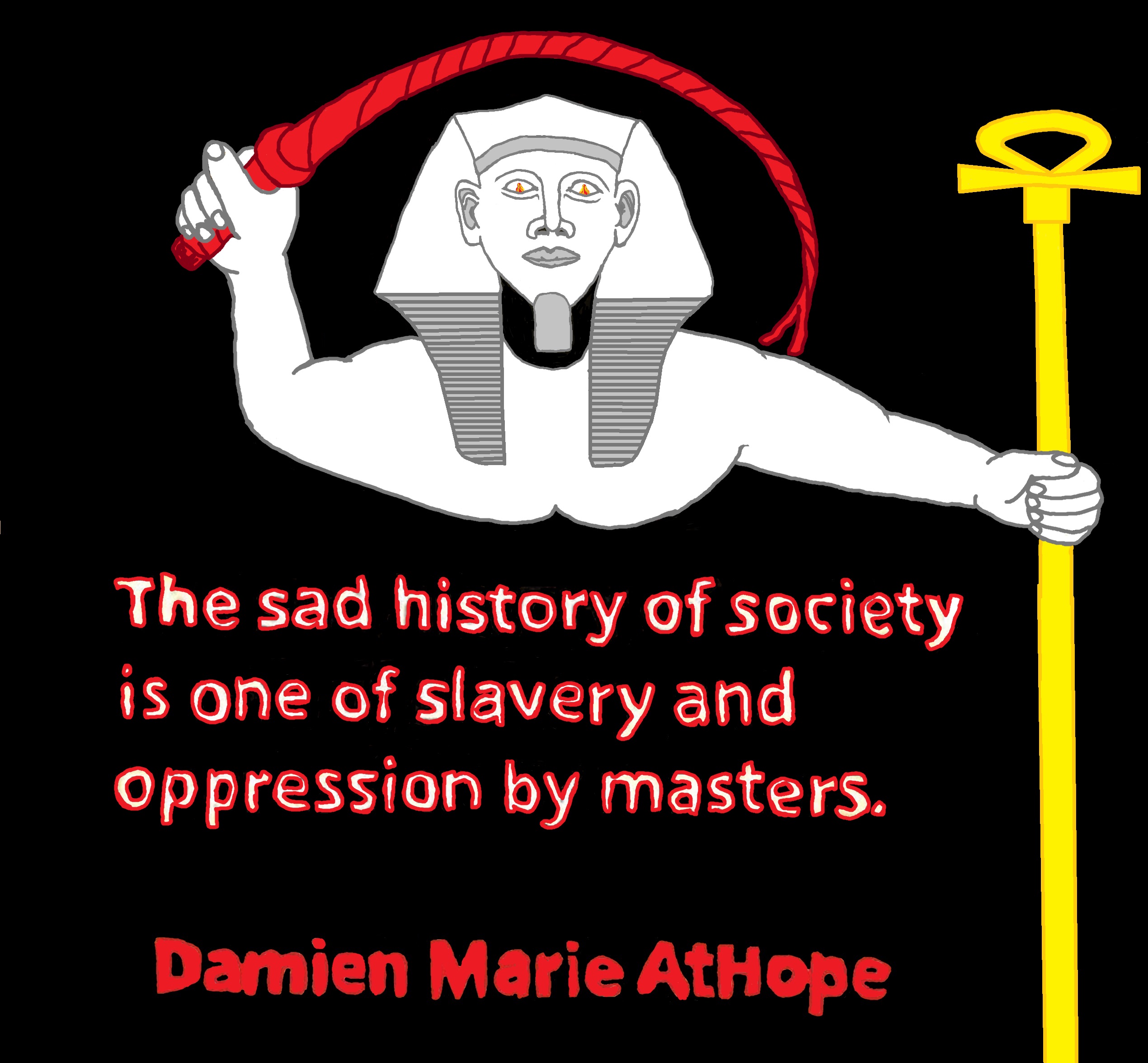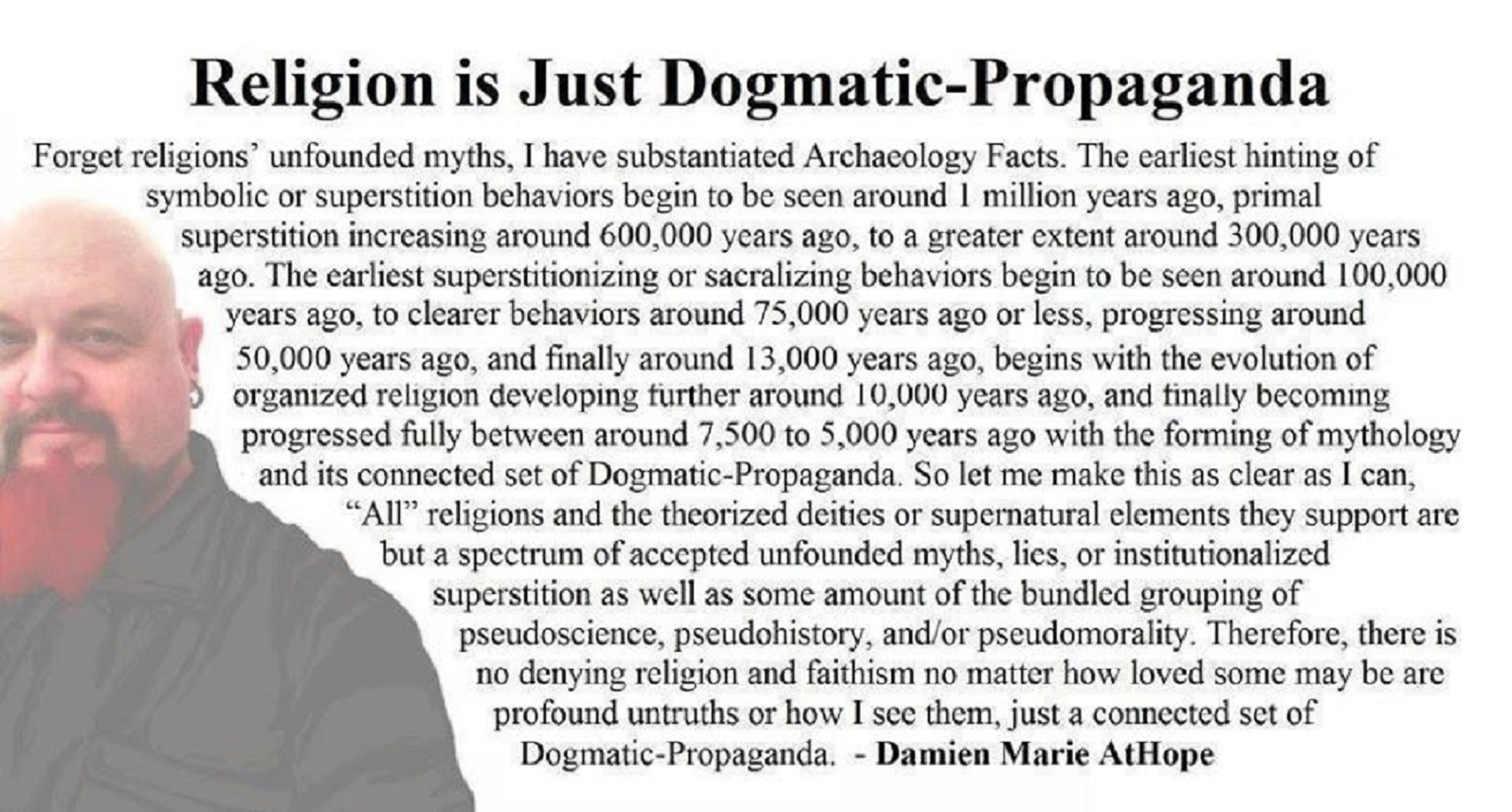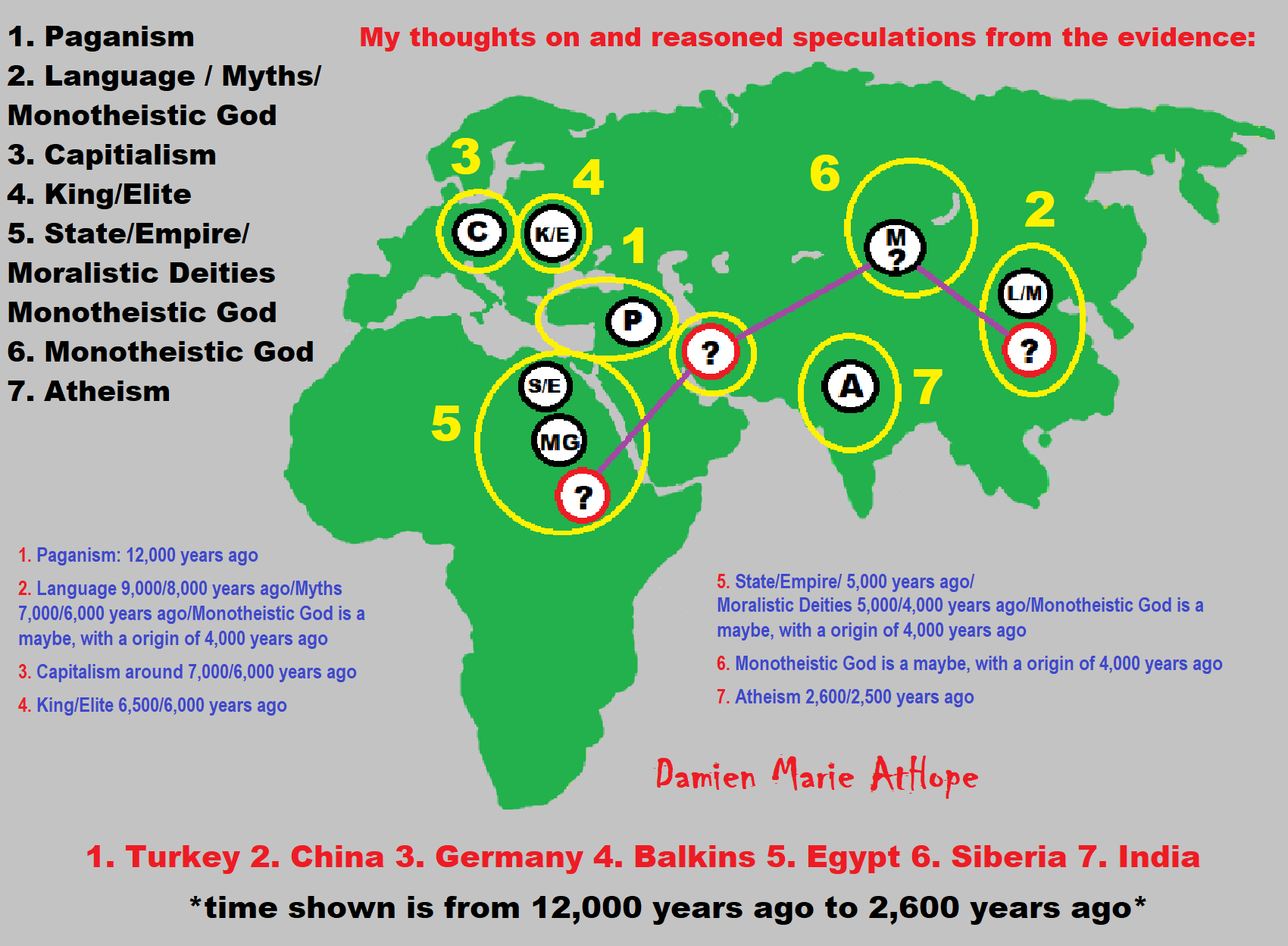
I am for listening to whatever the FACTS best explain.
I am inspired by philosophy, enlightened by archaeology, and grounded by science that religion claims, on the whole, along with their magical gods, are but dogmatic propaganda, myths, and lies. To me, religions can be summed up as conspiracy theories about reality, a reality mind you is only natural and devoid of magic anything. And to me, when people talk as if Atlantis is anything real, I stop taking them seriously. Like asking about the reality of Superman or Batman just because they seem to involve metropolitan cities in their stores. Or if Mother Goose actually lived in a shoe? You got to be kidding.
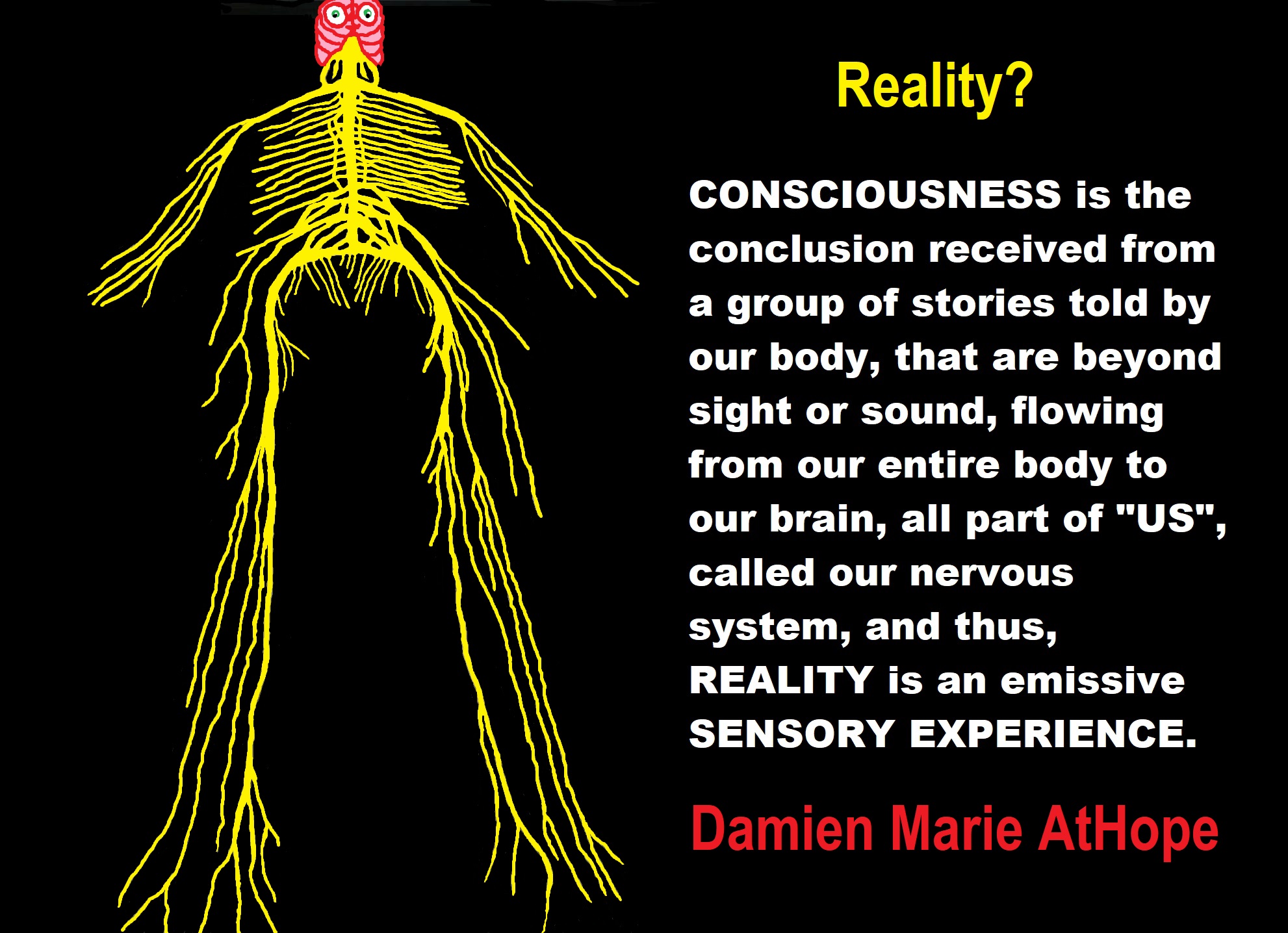

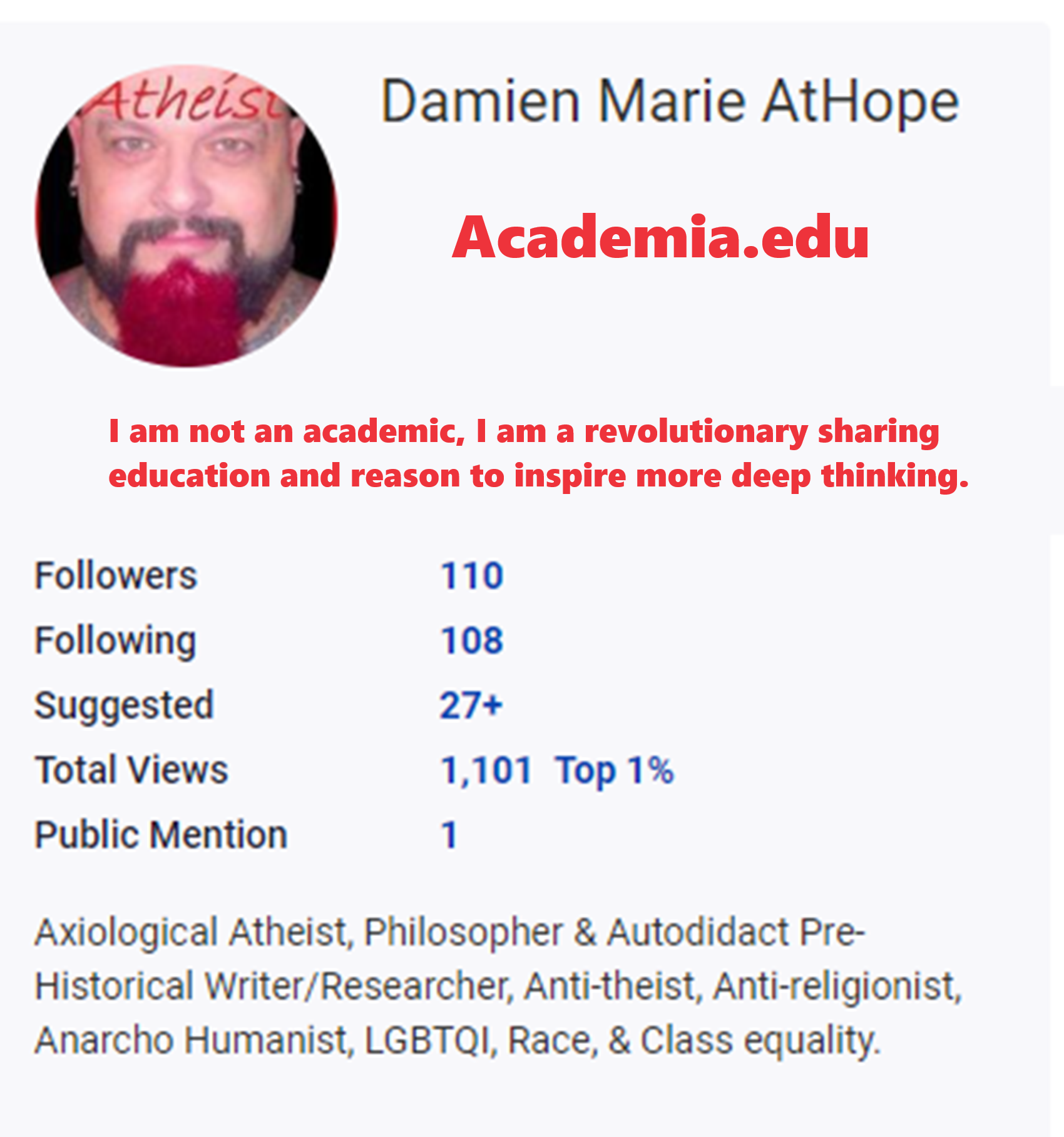
My Academia.edu Profile and Links to my several uploaded articles:
-
Shapeshifters: found among Totemists, Shamanists, and Paganists?
- Lake Baikal and Myths of Creation: Primordial waters, Supernatural Creatures of water, and the Mounds of creation
- Olmecs, Mayans, Aztecs, Isthmo-Colombians, and Incas: their differences and similarities, Origins, DNA, Languages, Cultures, Religions, and Gods
- Addressing Graham Hancock the Pseudoarchaeological Theorist, as well as Flaws in his Ancient Apocalypse, Great flood, and Seafaring R1b
- Prehistoric Egypt 40,000 years ago to The First Dynasty 5,150 years ago
- My Atheism: “Axiological/axiology (value theory/value science) Atheism”
- Haplogroup N from China to Fennoscandia: Migrations and Relationship of Language (Dene-Yeniseian and Uralic), DNA, and Cultures
- The Rise of Power and the 6000-year-old Shared Idea of the Solid Wheel as well as the Spoked Wheel-Shaped Ritual Motif
- Evolution of human skin color, White-Skin is really under 10,000 years old? Yet, Racism is something Terrible and New, under 7,000 years ago!
- Swing of the Mace: the rise of Elite, Forced Authority, and Inequality begin to Emerge 8,500 years ago?
- The Center of the World “Axis Mundi” and/or “Sacred Mountains” Mythology Could Relate to the Altai Mountains, Heart of the Steppe, as well as a hub for Shamanism
- Shamanism and the Peopling of the Americas: Pre-Paleoindians/Paleoamericans around 30,000 to 12,000 years ago and beyond.
- Nordic Paganism/Shamanism, Vikings, White Supremacists Imaginary, Viking Past, Neo-paganism/Neo-Shamanism, and Far-right Religio-Nationalism Bigotry
- Pottery before the Pre-Pottery Neolithic? Pre-Pottery Neolithic (10000 – 6500 BCE) and Pottery Neolithic (7000–5000 BCE)
- (Decolonize Russia/Siberian Land Back) Russian Conquest of Siberia and the spread of Russian Imperialism/Colonialism
- Ritual, Religion, Elites, Language, and Civilization relating to Neolithic and Ancient China
- Japan’s population Origins and Religious Beliefs from around 35,000 to 500 years ago
- Investigating Asian Shamanism: “Wu” (Chinese shaman) and (Chinese shamanism) “Wuism” or “Wu” religion as well as Others to Understand
- Advocating Anarchism: Morality, Non-coercion, Anti-hierarchy, Solidarity, Internationalism, Mutualism, Cooperationism, Empowermentism, etc.
- Philosophy to the Rescue: explaining Reason, Logic, Evidence, Truth, Certainty, Reality, and Science
- African Back Migrations and the Status of Shamanism Origins as well as its Spreading
- The Beginning origins of Atheistic Doubt at least by around 2,500 years ago
- When was the beginning: TIMELINE OF CURRENT RELIGIONS? Around 4,000 years ago
- Progressed organized Pagan religion starts, an approximately 5,000-year-old belief system
- Sky Father/Sky Mother “High Gods” or similar gods/goddesses of the sky more loosely connected, seeming arcane mythology across the earth seen in Siberia, China, Europe, Native Americans/First Nations People and Mesopotamia, etc.
- Pre-contact: distribution of North, Central, and South American language families and their Deities/Paganism or Religious/Spiritual beliefs like Shamanism/or “medicine people”
- Paganism: an approximately 12,000-year-old belief system
- Catal Huyuk “first religious designed city” around 9,500 to 7,700 years ago (Turkey)
- Totemism: an approximately 50,000-year-old belief system?
- Shamanism: an approximately 30,000-year-old belief system
- Animism: an approximately 100,000-year-old belief system?
- Pre-Animism: Portable Rock Art at least 300,000-year-old
- Over 100,000 years ago or so, Southern Africa, in the Land before and the beginning Time of Animism?
- Aurignacian Period female ‘Venus’ carvings start at 35,000 years ago, then Transfer on to Other Cultures?
- Gobekli Tepe: “First Temple” with (Early Paganism Themes) Sky Burial, Skull Cult, T-pillar Site Similarities, Obsidian Trade, Agriculture Revolution, and Megalith Cultures
- Proto-Indo-European (PIE), ancestor of Indo-European languages: DNA, Society, Language, and Mythology
- Sacred Mounds, Mountains, Kurgans, and Pyramids may hold deep Mythology connections?
- Seeming Connections: Totem poles, Ceremonial poles, Spirit poles, Sacred poles, Deity poles, Deities with poles, Pole star, Axis Mundi, Sacred trees, World tree, Maypole, Sun Dance with poles, etc
- Isthmo Colombian Area mainly by Chibchan languages and Seats of Power
- Shell Mounds, Earth Mounds, Raised Platforms, and Pyramids: which I think are somewhat related in mythology thinking and culture beliefs
- Understanding Religion Evolution
- My thoughts on the Evolution of Religion from Animism 100,000 years ago to Paganism 12,000 years ago
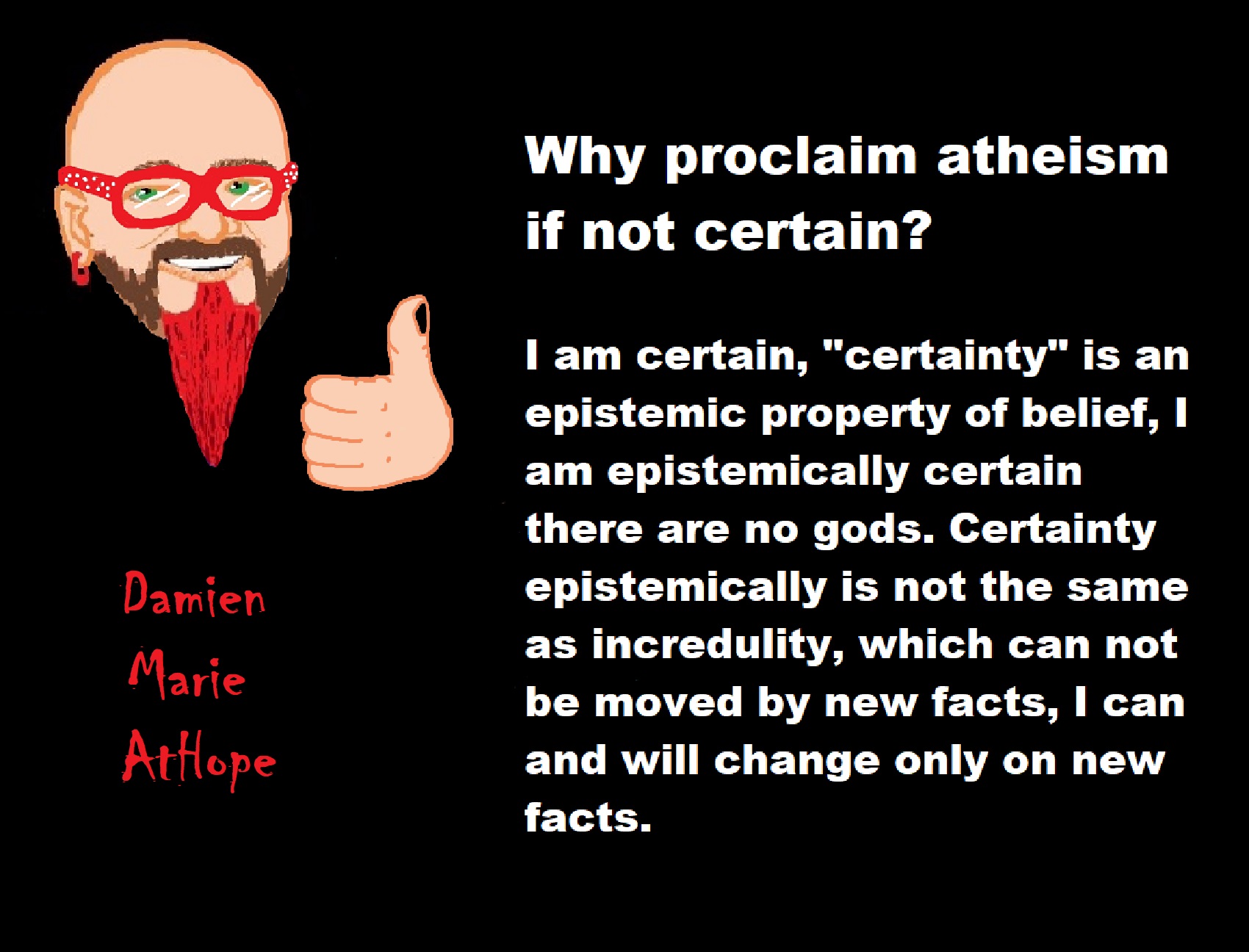
Anarchist Teaching as Free Public Education or Free Education in the Public: VIDEO
I am a servant leader, as I serve the people, not myself, not my ego, and not some desire for money, but rather a caring teacher’s heart to help all I can with all I am.
From such thoughtfulness may we all see the need for humanism and secularism, respecting all as helpful servant leaders assisting others as often as we can to navigate truth and the beauty of reality.
“Reason” is not from a mind devoid of “unreason” but rather demonstrates the potential ability to overcome bad thinking. An honest mind, enjoys just correction.
We are made great in our many acts of kindness because we rise by helping each other.
I fully enjoy the value (axiology) of archaeology (empirical evidence from fact or artifacts at a site) is knowledge (epistemology) of the past, adding to our anthropology (evidence from cultures both the present and past) intellectual (rational) assumptions of the likely reality of actual events from time past.
Religion is Unwarranted Faith and Belief. The problem with religion is unwarranted faith and belief. The problem of faith is as an invalid justification and the belief problem is holding unjustified false belief believing it is justified true belief. I use the Animism term as a definition of spirit-beliefs or a kind of Supernatural-Spiritism thinking, that to me, are in all spiritual or religious type beliefs, not primitive but core. I see Animism as the original religion (religious non-naturalism/supernatural persuasion or spiritual/magical thinking) of all humanity and is still in all the religions of the world.
I am mainly a prehistorian, 1 million to around 5,000/4,000 years ago. So while I may understand the past most don’t I don’t know a lot of history many seem to commonly know. I am not reading any more books, maybe ever again as I am tired from a life devoted to deep study. lol
Nothing is a justified true belief without valid or reliable reason and evidence; just as everything believed must be open to question, leaving nothing above challenge.
I don’t see religious terms Animism, Totemism, Shamanism, or Paganism as primitive but original or core elements that are different parts of world views and their supernatural/non-natural beliefs or thinking.
In the past or even lingering today, are beliefs often ripe with religious bigotry, seen in how religious/spiritual thinking not Abrahamic (Judaism, Christianity, or Islam) religious thinking are often believed to be primitive, unequal, or less than monotheism (preserved as the only real or not the correct religion beliefs if not monotheism).
I see all religions as having shared or similar features or core elements that relate to religious terms Animism, Totemism, Shamanism, or Paganism including Abrahamic (Judaism, Christianity, or Islam) religious thinking.
I don’t class any religious thinking as primitive but in error to what I see as a natural-only world, that religious thinking then makes up a myriad of non-natural/non-empirical themes/beings, stories, and myths about which group together are called religions.
I do anarchist teaching of prehistory, in that I don’t just make a blog, expecting people to come to me. No, I take all my knowledge and like a gorilla soldier, I force-feed to the world my knowledge, one piece at a time, that is just what is needed. So, I heed that call and teach in public…
All of our ancestors we once only animists, anarchists, and socialists then some asshole wanted power, thus it has all gone down from there. “Are you a good person” and how would others know without you telling them, “I am a good person” because words need justification… Be more mentally dangerous to hate, thus freely love and support kindness.
The sad history of the world has often been little more than oppression by masters, ones that we now call great. You have to make all kinds of choices in life and I chose kindness.
Don’t strive to make others wither under your gaze. No, BE a humanity hero, an inspiration of positive change all can become empowered by and become their best, even if only at one kind or thoughtful action at a time.
Train your brain to think ethically. We are responsible for the future, we are the future, living in the present, soon to be passed, so we must act with passion because life is over just like that. I am just another fellow dignity being. May I be a good human.
May I use all of whatever “Will” I have to be the best me I can be, may I be a good human. To me, we are responsible to do what is of value. Not ego, not pride, not self-dealing, but genuinely embody a heart of kindness, one that breathes deep a care for humanity.
What truly gives my life meaning is the depth of my emotional support and connectedness, in conjunction with my hope, love, care, empathy, compassion, kindness, altruism, etc. for both myself and others.
Religion is power over your mind. With faithism, in general, one is giving into not knowing belief as proof of some claimed knowing. Religious people are commonly influenced to not look but just believe on the will to believe things not known. Most “Religious people” claim a Full-faith before even reading half of the holy book they claim is completely true even if they don’t know all its claims as truth. Well, sadly, too often there is little difference between an obvious delusion we may reject, a cult we fear, and a religion we accept or support, then it’s currently in flavor, and the number of people involved…
(UPDATE 2024) Here are some of my latest blog posts on history/prehistory:
Shapeshifters: found among Totemists, Shamanists, and Paganists? Mar 7, 2024
Isthmo-Colombian Area (portions of Central and South America) mainly by Chibchan languages and Seats of Power Jan 19, 2024
(UPDATE 2023) Here are some of my latest blog posts on history/prehistory:
My thoughts on the Evolution of Religion: from Animism to Paganism Dec 27, 2023
The War Crimes of Israel: acting like a terrorist state would Dec 22, 2023
Talking about “Religion and Deity Evolution” on Twitter (X) Questions and Answers Dec 11, 2023
Two Anarchists: Cory Johnston and Damien Marie AtHope, address the Israel and Palestine conflict Oct 12, 2023
The History of Abortion as well as Religion and Abortion Oct 10, 2023
Totemism as seen in Europe: 50,000 years ago, mainly the Aurignacian culture Sep 20, 2023
Culture Wars: What is this Stupidity you call Masculinity? Jul 16, 2023
Bigotry Related to and with Religious or Nonreligious Terms? May 15, 2023
Alice Beck Kehoe: Feminist Anthropologist and Archaeologist, Addressing Sexism, Racism, Ethnocentrism, and Shamanism May 11, 2023
African Bantu Languages and Peoples: Their Migrations, Culture, Beliefs, and Mythology May 10, 2023
Sami Shamanism: Religio-Sociocultural Identity, Phenomenon, and System Apr 27, 2023
(Decolonize Russia/Siberian Land Back) Russian Conquest of Siberia and the spread of Russian Imperialism/Colonialism Apr 24, 2023
Addressing Pseudoarchaeology, Pseudohistory, Pseudojournalism, Pseudoscholarship, and Pseudoscience Apr 12, 2023
Venus of Willendorf: Shamanism Headdresses that Cover the Eyes? Apr 6, 2023
Intentionally committed fallacies: “What are your credentials” Apr 3, 2023
African Back Migrations and the Status of Shamanism Origins as well as its Spreading Mar 28, 2023
Jeffrey (JT) Lewis is a southeastern archaeologist and Ph.D. Grad Student who makes archaeology YouTube videos Mar 22, 2023
I heard people say, “Slav Ukraine” but who are the Slavs? Feb 22, 2023
Addressing Religious violence, belief in Gods as a motivation for harm? Feb 14, 2023
I hear Over and Over again that there is NO “scientific proof”, only “science evidence or facts” Feb 9, 2023
Ritual, Religion, Elites, Language, and Civilization relating to Neolithic and Ancient China Feb 7, 2023
Brent Lee: Recovering Conspiracist and host of “Some Dare Call It Conspiracy” Jan 27, 2023
C-M217 Na-Dene and Yeniseian Languages and Religion relatedness from Asia connecting to the Americas Jan 26, 2023
Atheist Activism Training, Debate/Discussion Tactics, and Presuppositional Apologetics Jan 17, 2023
Belief Etiquette: new Evidence supports one Speculation and Discredits another, but One must follow facts Dec 25, 2022
Thoughts on the Evolution of Religion: Animism, Totemism, Shamanism, Paganism, and Progressed Organized Religion Oct 31, 2022
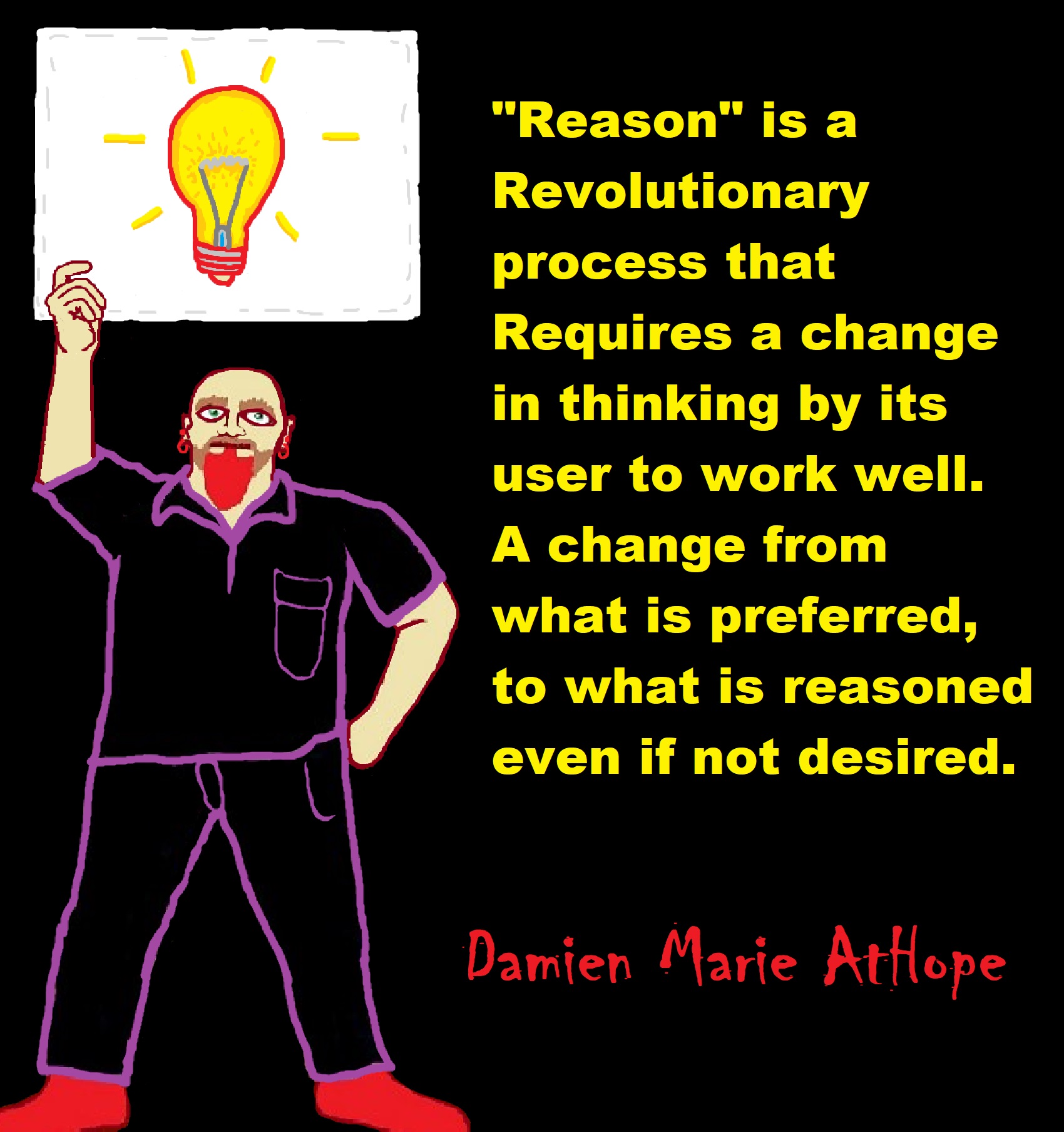
If the Christian God was somehow real, would you worship him?
My response, Never as that being portrayed in the Bible’s mythology is an evil earth-wide murdering monster.
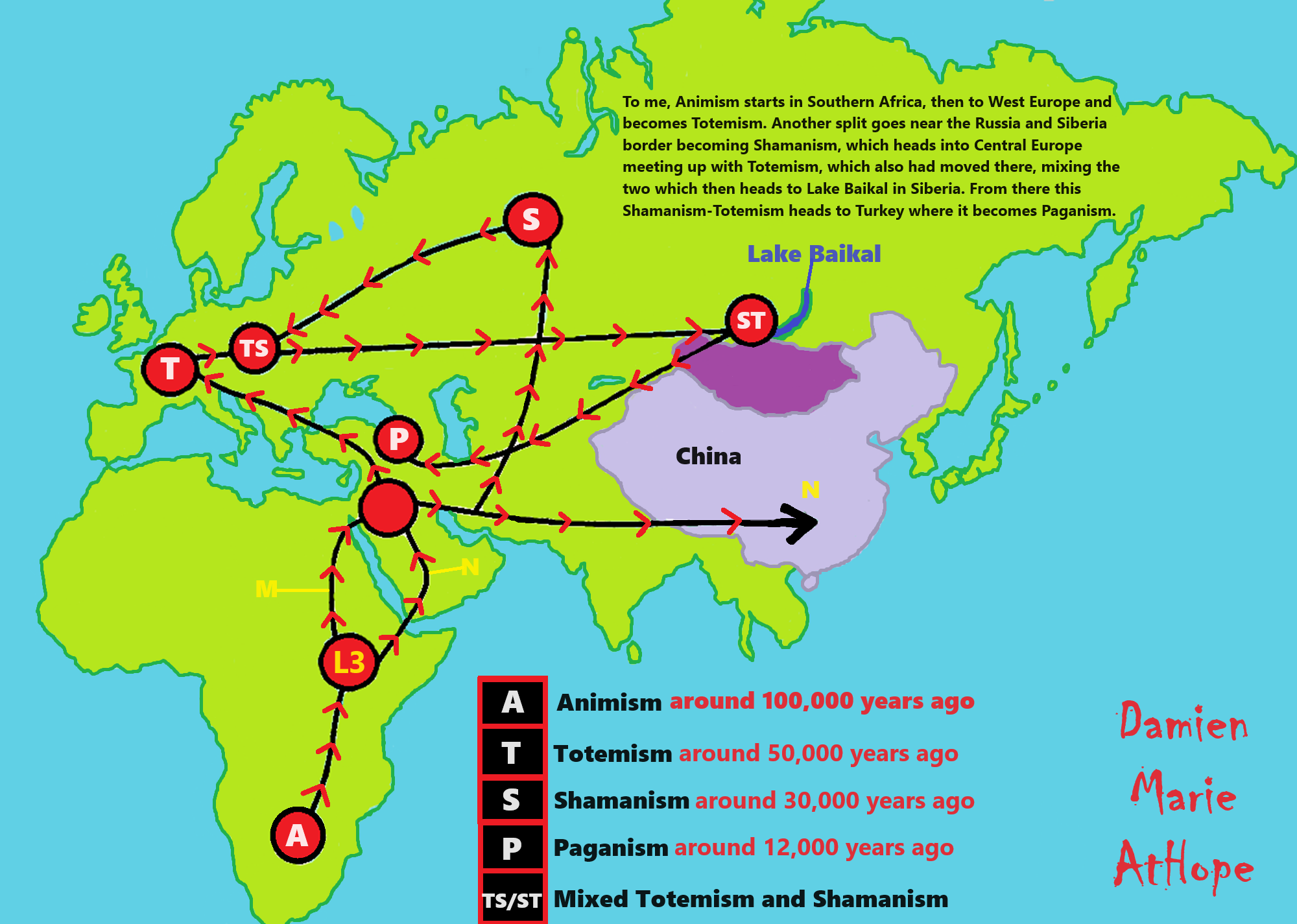
To me, Animism starts in Southern Africa, then to West Europe, and becomes Totemism. Another split goes near the Russia and Siberia border becoming Shamanism, which heads into Central Europe meeting up with Totemism, which also had moved there, mixing the two which then heads to Lake Baikal in Siberia. From there this Shamanism-Totemism heads to Turkey where it becomes Paganism.

Who should win? The Truth or one of Our EGO’s?
Just think of the wealth plundered from Africa by the evil colonialism of humanity’s dark past. These same “piece of shit” countries, now there are some of their citizens who look down or feel no need to help people, their country plunder like madmen, and murder like evil fiends.
To me, the clear fundamental issue in anarchism is “self sovereignty/responsibility freedom,” so when I hear it limited to anti-statism, I don’t see this as grasping anarchism as it is about values not lack of group unity or rules but freedom from rulers.
I do anarchist teaching of prehistory, in that I don’t just make a blog, expecting people to come to me. No, I take all my knowledge and like a gorilla soldier, I force-feed to the world my knowledge, one piece at a time, that is just what is needed. So, I heed that call and teach in public…
I wish people fought as hard for the actual values as they fight for the group/clan names political or otherwise they think support values. Every amount spent on war is theft to children in need of food or the homeless kept from shelter. In very dark times, Solidarity always. I am a socialist anarchist and I welcome all good humans.
In times of struggle or strife we humans can be most out of shape mentally so be patient as you can with others as we all are going through hell right now and desperately need each other. I just strive to live in the wonder of the moment. I value each experience as much as possible. I welcome life. I hope to live a life of value.
I am an anti-nationalist and anti-capitalist to my core. I stand in solidarity with humanity, not borders or nations, rather it is the humans from every single plot of dirt they happen to currently live on. We are all one. Don’t let imaginary borders tell you who to love or hate.
We need to value the humanity expressed or exchanged in and by people, not the job title, claim of education level, or political power, nor how cool you might be. We rise by helping each other. Is a fellow human being harmed? Then, hell yes, to me it is personal. A person of honor is not the same as a person who is never mad.
Imagine a world with enough excess to support all humanity yet we choose to change for everything even that found for free in or on the land. And a sociopath society more move to want killing in war spending almost like an addicted mind bent on killing itself rather than change.
Capitalism is followed like a religion, in that no matter how much harm it contains or can produce will not matter much to the “sacred profits” placed far above being ethical caretakers of the Earth or ethical profit distribution. As always the privileges of the powerful always come at the expense of the most valuable/vulnerable.
So often your apathy at the injustices of others is just you with your vile rotten humanity, flaunting your support for not carrying up until and if it could/would happen to you, just like an evil selfish mind would… Capitalism is unethical. Capitalist im-moral wage theft is always sold as a-moral “Sacred” Profits.
A few important anarchist themes to me: No one owns the Earth, so it must be shared ethically. Everyone owns themselves and is due human rights attached to such self-sovereignty. And that we rise by helping each other and thus should strive to unite in solidarity and community.
What is the price of a tear, what is the cost of a smile; can one see clear when others pay the price of their fear? If we don’t stop the suffering and harm, will the cost be more than we can take to our humanity? I feel disappointed and somewhat disturbed by the passion for war too many people seem to express.
Like war is fun video games not killing real life. I welcome peace and want all war to end. I am also sad at all harm and wish reason, not war wins. How are so many happy at war? Supporting the struggle of defense is not the same as Supporting WAR. Violence is acceptable for self-defense and other-defense and I strive for non-aggression as a way of life. I hate all acts of violence, even if for defense, as loss of life is just that, the harm I wish ended…
A group gathered around the man they Called JESUS: They hoped for free socialist healing but then they learned: Republican Jesus always charges a fee, what did you think doctors heal the sick for free? Lol, Pay me…
My religious family had me believing my anarchism nature was some demonic possession when it has always been a call for freedom and equality.
My thoughts on Religion Evolution with external links for more info:
- (Pre-Animism Africa mainly, but also Europe, and Asia at least 300,000 years ago), (Pre-Animism – Oxford Dictionaries)
- (Animism Africa around 100,000 years ago), (Animism – Britannica.com)
- (Totemism Europe around 50,000 years ago), (Totemism – Anthropology)
- (Shamanism Siberia around 30,000 years ago), (Shamanism – Britannica.com)
- (Paganism Turkey around 12,000 years ago), (Paganism – BBC Religion)
- (Progressed Organized Religion “Institutional Religion” Egypt around 5,000 years ago), (Ancient Egyptian Religion – Britannica.com)
- (CURRENT “World” RELIGIONS after 4,000 years ago) (Origin of Major Religions – Sacred Texts)
- (Early Atheistic Doubting at least by 2,600 years ago) (History of Atheism – Wikipedia)
“Religion is an Evolved Product” and Yes, Religion is Like Fear Given Wings…
Atheists talk about gods and religions for the same reason doctors talk about cancer, they are looking for a cure, or a firefighter talks about fires because they burn people and they care to stop them. We atheists too often feel a need to help the victims of mental slavery, held in the bondage that is the false beliefs of gods and the conspiracy theories of reality found in religions.
Understanding Religion Evolution:
- Pre-Animism (at least 300,000 years ago)
- Animism (Africa: 100,000 years ago)
- Totemism (Europe: 50,000 years ago)
- Shamanism (Siberia: 30,000 years ago)
- Paganism (Turkey: 12,000 years ago)
- Progressed organized religion (Egypt: 5,000 years ago), (Egypt, the First Dynasty 5,150 years ago)
- CURRENT “World” RELIGIONS (after 4,000 years ago)
- Early Atheistic Doubting (at least by 2,600 years ago)
“An Archaeological/Anthropological Understanding of Religion Evolution”
It seems ancient peoples had to survived amazing threats in a “dangerous universe (by superstition perceived as good and evil),” and human “immorality or imperfection of the soul” which was thought to affect the still living, leading to ancestor worship. This ancestor worship presumably led to the belief in supernatural beings, and then some of these were turned into the belief in gods. This feeble myth called gods were just a human conceived “made from nothing into something over and over, changing, again and again, taking on more as they evolve, all the while they are thought to be special,” but it is just supernatural animistic spirit-belief perceived as sacred.
Quick Evolution of Religion?
Pre-Animism (at least 300,000 years ago) pre-religion is a beginning that evolves into later Animism. So, Religion as we think of it, to me, all starts in a general way with Animism (Africa: 100,000 years ago) (theoretical belief in supernatural powers/spirits), then this is physically expressed in or with Totemism (Europe: 50,000 years ago) (theoretical belief in mythical relationship with powers/spirits through a totem item), which then enlists a full-time specific person to do this worship and believed interacting Shamanism (Siberia/Russia: 30,000 years ago) (theoretical belief in access and influence with spirits through ritual), and then there is the further employment of myths and gods added to all the above giving you Paganism (Turkey: 12,000 years ago) (often a lot more nature-based than most current top world religions, thus hinting to their close link to more ancient religious thinking it stems from). My hypothesis is expressed with an explanation of the building of a theatrical house (modern religions development). Progressed organized religion (Egypt: 5,000 years ago) with CURRENT “World” RELIGIONS (after 4,000 years ago).
Historically, in large city-state societies (such as Egypt or Iraq) starting around 5,000 years ago culminated to make religion something kind of new, a sociocultural-governmental-religious monarchy, where all or at least many of the people of such large city-state societies seem familiar with and committed to the existence of “religion” as the integrated life identity package of control dynamics with a fixed closed magical doctrine, but this juggernaut integrated religion identity package of Dogmatic-Propaganda certainly did not exist or if developed to an extent it was highly limited in most smaller prehistoric societies as they seem to lack most of the strong control dynamics with a fixed closed magical doctrine (magical beliefs could be at times be added or removed). Many people just want to see developed religious dynamics everywhere even if it is not. Instead, all that is found is largely fragments until the domestication of religion.
Religions, as we think of them today, are a new fad, even if they go back to around 6,000 years in the timeline of human existence, this amounts to almost nothing when seen in the long slow evolution of religion at least around 70,000 years ago with one of the oldest ritual worship. Stone Snake of South Africa: “first human worship” 70,000 years ago. This message of how religion and gods among them are clearly a man-made thing that was developed slowly as it was invented and then implemented peace by peace discrediting them all. Which seems to be a simple point some are just not grasping how devastating to any claims of truth when we can see the lie clearly in the archeological sites.
I wish people fought as hard for the actual values as they fight for the group/clan names political or otherwise they think support values. Every amount spent on war is theft to children in need of food or the homeless kept from shelter.
Here are several of my blog posts on history:
- To Find Truth You Must First Look
- (Magdalenian/Iberomaurusian) Connections to the First Paganists of the early Neolithic Near East Dating from around 17,000 to 12,000 Years Ago
- Natufians: an Ancient People at the Origins of Agriculture and Sedentary Life
- Possible Clan Leader/Special “MALE” Ancestor Totem Poles At Least 13,500 years ago?
- Jewish People with DNA at least 13,200 years old, Judaism, and the Origins of Some of its Ideas
- Baltic Reindeer Hunters: Swiderian, Lyngby, Ahrensburgian, and Krasnosillya cultures 12,020 to 11,020 years ago are evidence of powerful migratory waves during the last 13,000 years and a genetic link to Saami and the Finno-Ugric peoples.
- The Rise of Inequality: patriarchy and state hierarchy inequality
- Fertile Crescent 12,500 – 9,500 Years Ago: fertility and death cult belief system?
- 12,400 – 11,700 Years Ago – Kortik Tepe (Turkey) Pre/early-Agriculture Cultic Ritualism
- Ritualistic Bird Symbolism at Gobekli Tepe and its “Ancestor Cult”
- Male-Homosexual (female-like) / Trans-woman (female) Seated Figurine from Gobekli Tepe
- Could a 12,000-year-old Bull Geoglyph at Göbekli Tepe relate to older Bull and Female Art 25,000 years ago and Later Goddess and the Bull cults like Catal Huyuk?
- Sedentism and the Creation of goddesses around 12,000 years ago as well as male gods after 7,000 years ago.
- Alcohol, where Agriculture and Religion Become one? Such as Gobekli Tepe’s Ritualistic use of Grain as Food and Ritual Drink
- Neolithic Ritual Sites with T-Pillars and other Cultic Pillars
- Paganism: Goddesses around 12,000 years ago then Male Gods after 7,000 years ago
- First Patriarchy: Split of Women’s Status around 12,000 years ago & First Hierarchy: fall of Women’s Status around 5,000 years ago.
- Natufians: an Ancient People at the Origins of Agriculture and Sedentary Life
- J DNA and the Spread of Agricultural Religion (paganism)
- Paganism: an approximately 12,000-year-old belief system
- Paganism 12,000 years old: related to “Anarchism and Socialism” (Pre-Capitalism)
- Shaman burial in Israel 12,000 years ago and the Shamanism Phenomena
- Need to Mythicized: gods and goddesses
- 12,000 – 7,000 Years Ago – Paleo-Indian Culture (The Americas)
- 12,000 – 2,000 Years Ago – Indigenous-Scandinavians (Nordic)
- Norse did not wear helmets with horns?
- Pre-Pottery Neolithic Skull Cult around 11,500 to 8,400 Years Ago?
- 10,400 – 10,100 Years Ago, in Turkey the Nevail Cori Religious Settlement
- 9,000-6,500 Years Old Submerged Pre-Pottery/Pottery Neolithic Ritual Settlements off Israel’s Coast
- Catal Huyuk “first religious designed city” around 9,500 to 7,700 years ago (Turkey)
- Cultic Hunting at Catal Huyuk “first religious designed city”
- Special Items and Art as well as Special Elite Burials at Catal Huyuk
- New Rituals and Violence with the appearance of Pottery and People?
- Haplogroup N and its related Uralic Languages and Cultures
- Ainu people, Sámi people, Native Americans, the Ancient North Eurasians, and Paganistic-Shamanism with Totemism
- Ideas, Technology and People from Turkey, Europe, to China and Back again 9,000 to 5,000 years ago?
- First Pottery of Europe and the Related Cultures
- 9,000 years old Neolithic Artifacts Judean Desert and Hills Israel
- 9,000-7,000 years-old Sex and Death Rituals: Cult Sites in Israel, Jordan, and the Sinai
- 9,000-8500 year old Horned Female shaman Bad Dürrenberg Germany
- Neolithic Jewelry and the Spread of Farming in Europe Emerging out of West Turkey
- 8,600-year-old Tortoise Shells in Neolithic graves in central China have Early Writing and Shamanism
- Swing of the Mace: the rise of Elite, Forced Authority, and Inequality begin to Emerge 8,500 years ago?
- Migrations and Changing Europeans Beginning around 8,000 Years Ago
- My “Steppe-Anatolian-Kurgan hypothesis” 8,000/7,000 years ago
- Around 8,000-year-old Shared Idea of the Mistress of Animals, “Ritual” Motif
- Pre-Columbian Red-Paint (red ochre) Maritime Archaic Culture 8,000-3,000 years ago
- 7,522-6,522 years ago Linear Pottery culture which I think relates to Arcane Capitalism’s origins
- Arcane Capitalism: Primitive socialism, Primitive capital, Private ownership, Means of production, Market capitalism, Class discrimination, and Petite bourgeoisie (smaller capitalists)
- 7,500-4,750 years old Ritualistic Cucuteni-Trypillian culture of Moldova, Romania, and Ukraine
- Roots of a changing early society 7,200-6,700 years ago Jordan and Israel
- Agriculture religion (Paganism) with farming reached Britain between about 7,000 to 6,500 or so years ago and seemingly expressed in things like Western Europe’s Long Barrows
- My Thoughts on Possible Migrations of “R” DNA and Proto-Indo-European?
- “Millet” Spreading from China 7,022 years ago to Europe and related Language may have Spread with it leading to Proto-Indo-European
- Proto-Indo-European (PIE), ancestor of Indo-European languages: DNA, Society, Language, and Mythology
- The Dnieper–Donets culture and Asian varieties of Millet from China to the Black Sea region of Europe by 7,022 years ago
- Kurgan 6,000 years ago/dolmens 7,000 years ago: funeral, ritual, and other?
- 7,020 to 6,020-year-old Proto-Indo-European Homeland of Urheimat or proposed home of their Language and Religion
- Ancient Megaliths: Kurgan, Ziggurat, Pyramid, Menhir, Trilithon, Dolman, Kromlech, and Kromlech of Trilithons
- The Mytheme of Ancient North Eurasian Sacred-Dog belief and similar motifs are found in Indo-European, Native American, and Siberian comparative mythology
- Elite Power Accumulation: Ancient Trade, Tokens, Writing, Wealth, Merchants, and Priest-Kings
- Sacred Mounds, Mountains, Kurgans, and Pyramids may hold deep connections?
- Between 7,000-5,000 Years ago, rise of unequal hierarchy elite, leading to a “birth of the State” or worship of power, strong new sexism, oppression of non-elites, and the fall of Women’s equal status
- Paganism 7,000-5,000 years old: related to “Anarchism and Socialism” (Capitalism) (World War 0) Elite & their slaves
- Hell and Underworld mythologies starting maybe as far back as 7,000 to 5,000 years ago with the Proto-Indo-Europeans?
- The First Expression of the Male God around 7,000 years ago?
- White (light complexion skin) Bigotry and Sexism started 7,000 years ago?
- Around 7,000-year-old Shared Idea of the Divine Bird (Tutelary and/or Trickster spirit/deity), “Ritual” Motif
- Nekhbet an Ancient Egyptian Vulture Goddess and Tutelary Deity
- 6,720 to 4,920 years old Ritualistic Hongshan Culture of Inner Mongolia with 5,000-year-old Pyramid Mounds and Temples
- First proto-king in the Balkans, Varna culture around 6,500 years ago?
- 6,500–5,800 years ago in Israel Late Chalcolithic (Copper Age) Period in the Southern Levant Seems to Express Northern Levant Migrations, Cultural and Religious Transfer
- KING OF BEASTS: Master of Animals “Ritual” Motif, around 6,000 years old or older…
- Around 6000-year-old Shared Idea of the Solid Wheel & the Spoked Wheel-Shaped Ritual Motif
- “The Ghassulian Star,” a mysterious 6,000-year-old mural from Jordan; a Proto-Star of Ishtar, Star of Inanna or Star of Venus?
- Religious/Ritual Ideas, including goddesses and gods as well as ritual mounds or pyramids from Northeastern Asia at least 6,000 years old, seemingly filtering to Iran, Iraq, the Mediterranean, Europe, Egypt, and the Americas?
- Maykop (5,720–5,020 years ago) Caucasus region Bronze Age culture-related to Copper Age farmers from the south, influenced by the Ubaid period and Leyla-Tepe culture, as well as influencing the Kura-Araxes culture
- 5-600-year-old Tomb, Mummy, and First Bearded Male Figurine in a Grave
- Kura-Araxes Cultural 5,520 to 4,470 years old DNA traces to the Canaanites, Arabs, and Jews
- Minoan/Cretan (Keftiu) Civilization and Religion around 5,520 to 3,120 years ago
- Evolution Of Science at least by 5,500 years ago
- 5,500 Years old birth of the State, the rise of Hierarchy, and the fall of Women’s status
- “Jiroft culture” 5,100 – 4,200 years ago and the History of Iran
- Stonehenge: Paganistic Burial and Astrological Ritual Complex, England (5,100-3,600 years ago)
- Around 5,000-year-old Shared Idea of the “Tree of Life” Ritual Motif
- Complex rituals for elite, seen from China to Egypt, at least by 5,000 years ago
- Around 5,000 years ago: “Birth of the State” where Religion gets Military Power and Influence
- The Center of the World “Axis Mundi” and/or “Sacred Mountains” Mythology Could Relate to the Altai Mountains, Heart of the Steppe
- Progressed organized religion starts, an approximately 5,000-year-old belief system
- China’s Civilization between 5,000-3,000 years ago, was a time of war and class struggle, violent transition from free clans to a Slave or Elite society
- Origin of Logics is Naturalistic Observation at least by around 5,000 years ago.
- Paganism 5,000 years old: progressed organized religion and the state: related to “Anarchism and Socialism” (Kings and the Rise of the State)
- Ziggurats (multi-platform temples: 4,900 years old) to Pyramids (multi-platform tombs: 4,700 years old)
- Did a 4,520–4,420-year-old Volcano In Turkey Inspire the Bible God?
- Finland’s Horned Shaman and Pre-Horned-God at least 4,500 years ago?
- 4,000-year-Old Dolmens in Israel: A Connected Dolmen Religious Phenomenon?
- Creation myths: From chaos, Ex nihilo, Earth-diver, Emergence, World egg, and World parent
- Bronze Age “Ritual” connections of the Bell Beaker culture with the Corded Ware/Single Grave culture, which were related to the Yamnaya culture and Proto-Indo-European Languages/Religions
- Low Gods (Earth/ Tutelary deity), High Gods (Sky/Supreme deity), and Moralistic Gods (Deity enforcement/divine order)
- The exchange of people, ideas, and material-culture including, to me, the new god (Sky Father) and goddess (Earth Mother) religion between the Cucuteni-Trypillians and others which is then spread far and wide
- Koryaks: Indigenous People of the Russian Far East and Big Raven myths also found in Tlingit, Haida, Tsimshian, and other Indigenous People of North America
- 42 Principles Of Maat (Egyptian Goddess of the justice) around 4,400 years ago, 2000 Years Before Ten Commandments
- “Happy Easter” Well Happy Eostre/Ishter
- 4,320-3,820 years old “Shimao” (North China) site with Totemistic-Shamanistic Paganism and a Stepped Pyramid
- 4,250 to 3,400 Year old Stonehenge from Russia: Arkaim?
- 4,100-year-old beaker with medicinal & flowering plants in a grave of a woman in Scotland
- Early European Farmer ancestry, Kelif el Boroud people with the Cardial Ware culture, and the Bell Beaker culture Paganists too, spread into North Africa, then to the Canary Islands off West Africa
- Flood Accounts: Gilgamesh epic (4,100 years ago) Noah in Genesis (2,600 years ago)
- Paganism 4,000 years old: related to “Anarchism and Socialism” (First Moralistic gods, then the Origin time of Monotheism)
- When was the beginning: TIMELINE OF CURRENT RELIGIONS, which start around 4,000 years ago.
- Early Religions Thought to Express Proto-Monotheistic Systems around 4,000 years ago
- Kultepe? An archaeological site with a 4,000 years old women’s rights document.
- Single God Religions (Monotheism) = “Man-o-theism” started around 4,000 years ago with the Great Sky Spirit/God Tiān (天)?
- Confucianism’s Tiān (Shangdi god 4,000 years old): Supernaturalism, Pantheism or Theism?
- Yes, Your Male God is Ridiculous
- Mythology, a Lunar Deity is a Goddess or God of the Moon
- Sacred Land, Hills, and Mountains: Sami Mythology (Paganistic Shamanism)
- Horse Worship/Sacrifice: mythical union of Ruling Elite/Kingship and the Horse
- The Amorite/Amurru people’s God Amurru “Lord of the Steppe”, relates to the Origins of the Bible God?
- Bronze Age Exotic Trade Routes Spread Quite Far as well as Spread Religious Ideas with Them
- Sami and the Northern Indigenous Peoples Landscape, Language, and its Connection to Religion
- Prototype of Ancient Analemmatic Sundials around 3,900-3,150 years ago and a Possible Solar Connection to gods?
- Judaism is around 3,450 or 3,250 years old. (“Paleo-Hebrew” 3,000 years ago and Torah 2,500 years ago)
- The Weakening of Ancient Trade and the Strengthening of Religions around 3000 years ago?
- Are you aware that there are religions that worship women gods, explain now religion tears women down?
- Animistic, Totemistic, and Paganistic Superstition Origins of bible god and the bible’s Religion.
- Myths and Folklore: “Trickster gods and goddesses”
- Jews, Judaism, and the Origins of Some of its Ideas
- An Old Branch of Religion Still Giving Fruit: Sacred Trees
- Dating the BIBLE: naming names and telling times (written less than 3,000 years ago, provable to 2,200 years ago)
- Did a Volcano Inspire the bible god?
- The Amorite/Amurru people’s God Amurru “Lord of the Steppe”, relates to the Origins of the Bible God?
- Dené–Yeniseian language, Old Copper Complex, and Pre-Columbian Mound Builders?
- No “dinosaurs and humans didn’t exist together just because some think they are in the bible itself”
- Sacred Shit and Sacred Animals?
- Everyone Killed in the Bible Flood? “Nephilim” (giants)?
- Hey, Damien dude, I have a question for you regarding “the bible” Exodus.
- Archaeology Disproves the Bible
- Bible Battle, Just More, Bible Babble
- The Jericho Conquest lie?
- Canaanites and Israelites?
- Accurate Account on how did Christianity Began?
- Let’s talk about Christianity.
- So the 10 commandments isn’t anything to go by either right?
- Misinformed christian
- Debunking Jesus?
- Paulism vs Jesus
- Ok, you seem confused so let’s talk about Buddhism.
- Unacknowledged Buddhism: Gods, Savior, Demons, Rebirth, Heavens, Hells, and Terrorism
- His Foolishness The Dalai Lama
- Yin and Yang is sexist with an ORIGIN around 2,300 years ago?
- I Believe Archaeology, not Myths & Why Not, as the Religious Myths Already Violate Reason!
- Archaeological, Scientific, & Philosophic evidence shows the god myth is man-made nonsense.
- Aquatic Ape Theory/Hypothesis? As Always, Just Pseudoscience.
- Ancient Aliens Conspiracy Theorists are Pseudohistorians
- The Pseudohistoric and Pseudoscientific claims about “Bakoni Ruins” of South Africa
- Why do people think Religion is much more than supernaturalism and superstitionism?
- Religion is an Evolved Product
- Was the Value of Ancient Women Different?
- 1000 to 1100 CE, human sacrifice Cahokia Mounds a pre-Columbian Native American site
- Feminist atheists as far back as the 1800s?
- Promoting Religion as Real is Mentally Harmful to a Flourishing Humanity
- Screw All Religions and Their Toxic lies, they are all fraud
- Forget Religions’ Unfounded Myths, I Have Substantiated “Archaeology Facts.”
- Religion Dispersal throughout the World
- I Hate Religion Just as I Hate all Pseudoscience
- Exposing Scientology, Eckankar, Wicca and Other Nonsense?
- Main deity or religious belief systems
- Quit Trying to Invent Your God From the Scraps of Science.
- Archaeological, Scientific, & Philosophic evidence shows the god myth is man-made nonsense.
- Ancient Alien Conspiracy Theorists: Misunderstanding, Rhetoric, Misinformation, Fabrications, and Lies
- Misinformation, Distortion, and Pseudoscience in Talking with a Christian Creationist
- Judging the Lack of Goodness in Gods, Even the Norse God Odin
- Challenging the Belief in God-like Aliens and Gods in General
- A Challenge to Christian use of Torture Devices?
- Yes, Hinduism is a Religion
- Trump is One of the Most Reactionary Forces of Far-right Christian Extremism
- Was the Bull Head a Symbol of God? Yes!
- Primate Death Rituals
- Christian – “God and Christianity are objectively true”
- Australopithecus afarensis Death Ritual?
- You Claim Global Warming is a Hoax?
- Doubter of Science and Defamer of Atheists?
- I think that sounds like the Bible?
- History of the Antifa (“anti-fascist”) Movements
- Indianapolis Anti-Blasphemy Laws #Free Soheil Rally
- Damien, you repeat the golden rule in so many forms then you say religion is dogmatic?
- Science is a Trustable Methodology whereas Faith is not Trustable at all!
- Was I ever a believer, before I was an atheist?
- Atheists rise in reason
- Mistrust of science?
- Open to Talking About the Definition of ‘God’? But first, we address Faith.
- ‘United Monarchy’ full of splendor and power – Saul, David, and Solomon? Most likely not.
- Is there EXODUS ARCHAEOLOGY? The short answer is “no.”
- Lacking Proof of Bigfoots, Unicorns, and Gods is Just a Lack of Research?
- Religion and Politics: Faith Beliefs vs. Rational Thinking
- Hammer of Truth that lying pig RELIGION: challenged by an archaeologist
- “The Hammer of Truth” -ontology question- What do You Mean by That?
- Navigation of a bad argument: Ad Hominem vs. Attack
- Why is it Often Claimed that Gods have a Gender?
- Why are basically all monotheistic religions ones that have a male god?
- Shifting through the Claims in support of Faith
- Dear Mr. AtHope, The 20th Century is an Indictment of Secularism and a Failed Atheist Century
- An Understanding of the Worldwide Statistics and Dynamics of Terrorist Incidents and Suicide Attacks
- Intoxication and Evolution? Addressing and Assessing the “Stoned Ape” or “Drunken Monkey” Theories as Catalysts in Human Evolution
- Sacred Menstrual cloth? Inanna’s knot, Isis knot, and maybe Ma’at’s feather?
- Damien, why don’t the Hebrews accept the bible stories?
- Dealing with a Troll and Arguing Over Word Meaning
- Knowledge without Belief? Justified beliefs or disbeliefs worthy of Knowledge?
- Afrocentrism and African Religions
- Crecganford @crecganford offers history & stories of the people, places, gods, & culture
- Empiricism-Denier?
I am not an academic. I am a revolutionary that teaches in public, in places like social media, and in the streets. I am not a leader by some title given but from my commanding leadership style of simply to start teaching everywhere to everyone, all manner of positive education.
We need more free counseling in public, in general. I both fear the mad person intent on harm as I am to those determined to stay delusionally unaware of the oppression and suffering of others in need all across this sad unhelping world.
Poor bodies have always been thrown, with carless abandoned into the arms of potential harm, often for little more than the whims of rich men. The sad theme woven in the thread of history is one of oppression by masters and to the calls to hearing the pain of the poor? As always they are expected to live a life of servitude. To the weak, you will serve the strong and we all act like nothing is wrong…
When you put your “honor” in your “actions”, it is then you will already be doing what is worthy, good, true, or right! Thus it is a character and EGO problem, we need to change otherwise. As an anarchist, all humans are treated equally, regardless if they are from any class: the educated and the uneducated, the rich or the poor, the popular and the unknown.
“Reason” is a revolutionary process as it requires a change in thinking by its User, to switch thinking, to reason over what may be preferred, and for “reason” to be used right. A lot of people think fame but I think about the quality of my thinking and behaviors.
To me, prehistory had no “magical past”, it was only people, natural places, non-magical artifacts, and it is culture that produced products like language and religions. I have a simple game to be a good human and inspire others to also be a good human, truth aids this.
The biggest thing I learned in college was how gifted in thinking I am as I was feeling more like the teacher than the teachers, I then truly realized, I was even often smarter then the books I was made to read as well…
I am a rationalist, not a skeptic. I appeal to reason, not doubt, like most atheists. No “skepticism attack” tactics used on others atheists works on me, as I don’t even value skepticism. When the Truth is afraid, Fascism of some kind, likely Reigns. While many skeptics may tend to strive to master doubt, I as a rationalist, strive to master reason.
I am a Methodological Rationalist, I rarely am pushed to doubt as a default, instead, I see reason as my default and at times it may be responsible to doubt, but I get to that conclusion because of reasoning. Methodological: relating to the system of methods used in a particular area of study or activity: such as “a wide variety of methodological approaches to ethical problem-solving in my approach to truth or the label of knowledge.”
I fully enjoy the value (axiology) of archaeology (empirical evidence from fact or artifacts at a site) is knowledge (epistemology) of the past, adding to our anthropology (evidence from cultures both the present and past) intellectual (rational) assumptions of the likely reality of actual events from time past.
Religion is Unwarranted Faith and Belief The problem with religion is unwarranted faith and belief. The problem of faith is as an invalid justification and the belief problem is holding unjustified false belief believing it is justified true belief.
People sometimes think My Stuff on religion is too detailed. And I think, these are only the highlights of the cliff notes on the issue of religious evolution. It actually is even more…
I know enough to surprise archaeologists but they don’t realize I have been researching since 2006 when I became an atheist. I wanted to know. I am also going to publish my prehistory book, which will shock the world, at how much I have figured out, it is breathtakingly amazing.
I am mainly a prehistorian, 1 million to around 5,000/4,000 years ago. So while I may understand the past most don’t I don’t know a lot of history many seem to commonly know. I am not reading any more books, maybe ever again as I am tired from a life devoted to deep study. lol
Nothing is a justified true belief without valid or reliable reason and evidence; just as everything believed must be open to question, leaving nothing above challenge.
Soundness: “In logic, more precisely in deductive reasoning, an argument is sound if it is both valid in form and its premises are true. Soundness also has a related meaning in mathematical logic, wherein logical systems are sound if and only if every formula that can be proved in the system is logically valid with respect to the semantics of the system. In deductive reasoning, a sound argument is an argument that is both valid, and all of whose premises are true (and as a consequence its conclusion is true as well). An argument is valid if, assuming its premises are true, the conclusion must be true.” ref
Strong soundness: “Strong soundness of a deductive system is the property that any sentence P of the language upon which the deductive system is based that is derivable from a set Γ of sentences of that language is also a logical consequence of that set, in the sense that any model that makes all members of Γ true will also make P true. In symbols where Γ is a set of sentences of L: if Γ ⊢S P, then also Γ ⊨L P. Notice that in the statement of strong soundness, when Γ is empty, we have the statement of weak soundness.” ref
Pragmatic theory of truth, Coherence theory of truth, and Correspondence theory of truth
The Way of a Sound Thinker? Sound thinking to me, in a general way, is thinking, reasoning, or belief that tends to make foresight a desire to be as accurate as one can with valid and reliable reason and evidence.
In a general way, all reality, in a philosophic sense, is an emergent property of reason, and knowing how reason accrues does not remove its warrant. Feelings are experienced then perceived, leading to thinking, right thinking is reason, right reason is logic, right logic is mathematics, right mathematics is physics and from there all science.
I do anarchist teaching of prehistory, in that I don’t just make a blog, expecting people to come to me. No, I take all my knowledge and like a gorilla soldier, I force-feed to the world my knowledge, one piece at a time, that is just what is needed. So, I heed that call and teach in public…
Do good, make no excuses, just do good, the world desperately needs more of this, and if we all do more, we all win. We rise by helping each other. I am an autodidactic-polymath in many subjects and a genus in both IQ intelligence as well as EQ emotional intelligence, quite rare. Yet I am ignored? Most disregard my ideas, I don’t think so, or is it due to my blogs that are so long they are like small free books, scary right?
I like learning prehistory!
I also hate:
“Pseudo-science, Pseudo-history, and Pseudo-morality.”
So yeah, history is fun, but one must weed through the sometimes added mythology, half-truths, or outright lies. This is even more important when reading religion-related information.
The greatest lie ever, was the fraud of democracy, from its conceptions in Greece, claiming the freedom to vote, all the while upholding the institution of slavery. We today are sold the lie of capitalism, and the elite that play in space, while children starve in the streets…
The sad history of democracy is one of continued bigotry of elites and slaves, but now with a happy face or less unhappy faces, I should say, for more accuracy, as some non-slaves were a little more equal in a limited kind of way and/or scope.
If Americanism has taught us anything, it is that this “land” (people claiming colonialism as a birthright) loves bigotry, hate, lying, violence, denial, and unscientific explanations to just about any damn thing that can’t get away fast enough.
What if truth, mattered? Would we be more open-minded, or did you think you were already good, no improvement needed as most do, or do you let “new knowledge” alluded to, get in? Do you care? If so, what have you done to help change the world? When was the last time you realized you were wrong, then changed?
I often struggle for a better world but it is hard when hate is more motivating than love… Shamefully, the world thrives on bigotry and it needs to stop, no matter what style of society it is wrong.
Anarchism is often the answer as the world of oppression is the cancer. Anarchism, to me, is often best exemplified as a call for kindness extended to all, for all, and by all.
My biggest dislike in the atheist/skeptics movement is how a few people are almost worshiped with, at times a cult-like hero-worship, it is vile and contrary to free thinking in general.
“Can you name specifics? Matt, Steve, Aron, etc.?” – Questioner
My response, How about “Christopher Hitchens,” for one, and yes many others. It is allowed or supported, it is not actively rebuked, over and over and over as it should. I even saw a woman bow down on her knees in front of a famous “atheist philosopher” at an atheist convention in Canada.
“Ok. I follow Sartre’s philosophy to the point that I consider myself a Sartrean. I find Hitchens, Dawkins, and Harris boring, because they fall short of a philosophy of consciousness. They’re mostly political. But bowing down or following somebody in cult-like aspirations is counterintuitive to atheist thinking, like you say. We usually don’t follow anybody or join clubs like churches.” – Questioner
My response, We should champion “champions of truth” but as acknowledgment, not cultish worship. I never want anyone, to worship me. Acknowledging all I have done, is enough. We should support all kinds of voices, not act as if any should outweigh, the benefit from all. Power to the people.
“Blind belief in authority is the greatest enemy of truth.” Albert Einstein
Liberal is not the same as a Democrat. A Democrat can be conservative, neoliberal, liberal, progressive, etc. Liberal: “willing to respect or accept behavior or opinions different from one’s own; open to new ideas” I am an anarchist-socialist with liberal thinking.
I just blocked another person, and now that I am not an activist anymore, I plan on making this a new habit. I don’t play, with trolls anymore.
I am anti-capitalism and want it gone as well as solidarity to champion humanity.
Who are we to call our society great, that lets its most needy suffer? We need to help the needy, both directly, and the systemic harm of capitalism, that allows our fellow dignity beings, to suffer without dignity. How is this harm allowed, is there truly no moral courage left?
I became a leftist on my own not reading anything but my turning atheist changed my values and value focus. Thus, I stop being a religious rightist, and realized I was an anti-religious far-leftist, not just an atheist, I was an anarchist too.
When I first became an anarchist, I only said I was an “Anarchist”, thinking all “Anarchists” were “Socialist” or something close to that. Then I was told, fools call themselves anarchist-capitalists, WTF! Bro, just stop! So, now because of them, I have to say, “Socialist-anarchist.”

I am a far-leftist, I am not pro-patriotism, nor anti-patriotism if limited to that which is actually positive, but am actively against pro-patriotism if harmful, just as I am against pro-nationalism. And I hold this universally whether one claims the left or the right.
I am similar to a self/alone leftist, my ideas are almost exclusively my own or that I relate with. I am not in or connected to any group or person other than @Skepticallefty, who is a friend, and a fellow leftist educator, teaching, like me, in public.
No, I am not ok with the hell of this capitalist “profits” driven world, that pushes our fellow humans to live, the harsh life, of the cold street!
I am no fan of politicians in general as an anarchist. But politicians are not equal at all, nor are the different parties similar on things. So it matters when humanity is on the line. One is ok with slowing our demise, while others are trying hard to burn the earth alive.
We all make a difference! Often we wait for others to be friendly, to be kind, to make a difference, or to be a leader. When we have such power all along, may I be friendly, Kind, make a difference, and be a leader of such active humanism, promoting human good…
I vote as harm reduction in a harmful system.
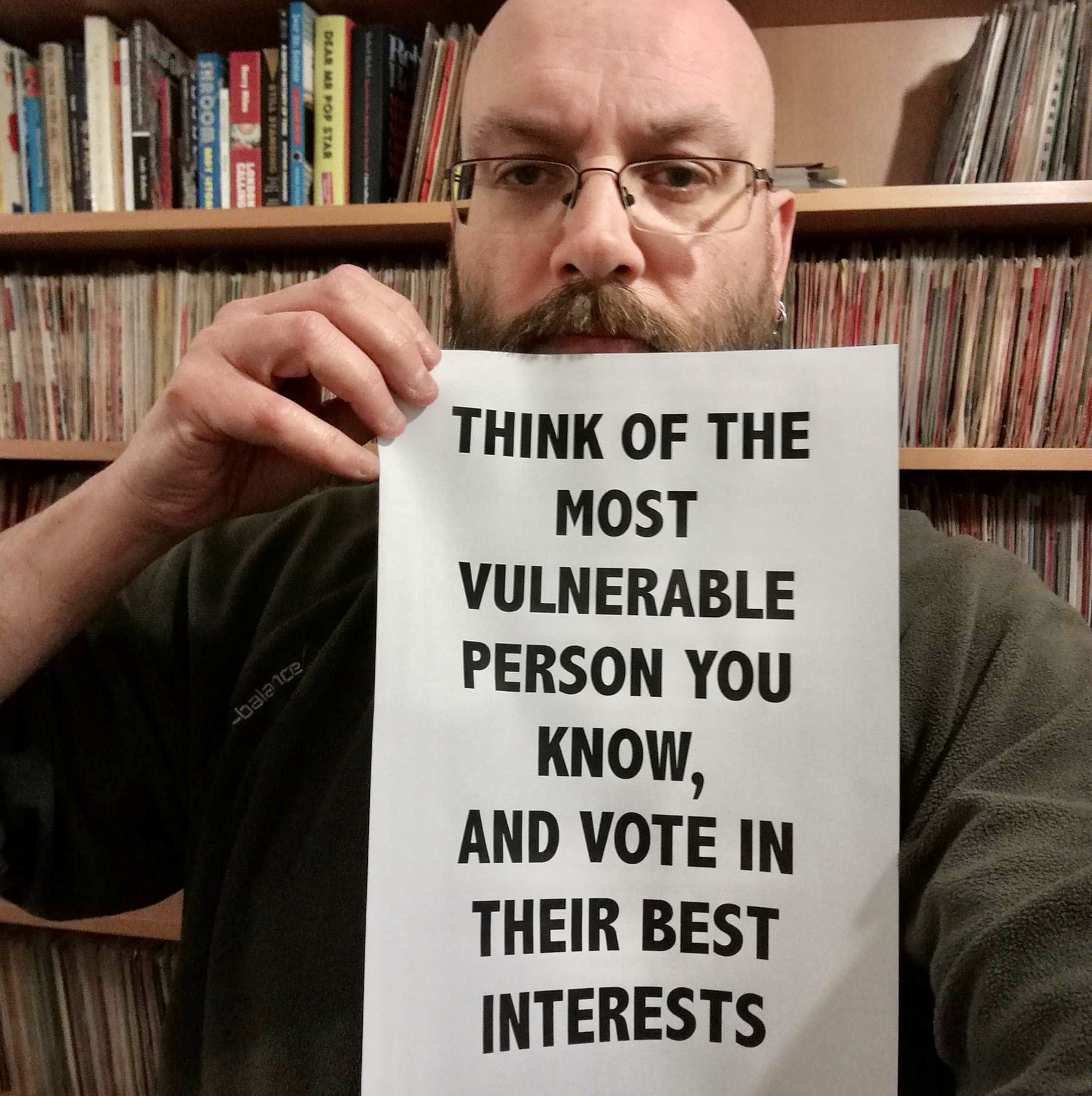





Damien Marie AtHope (Said as “At” “Hope”): Axiological Atheist, Anti-theist, Anti-religionist, Secular Humanist. Rationalist, Writer, Artist, Poet, Philosopher, Advocate, Activist, Psychology, and Armchair Archaeology/Anthropology/Historian.
Discussing Leadership and Prehistory with Leader Deanna L. Lawlis
Religious Trauma Syndrome with Author Deanna L. Lawlis
Belief (Theism) and Disbelief (Atheism) in Anarchism and Socialism?
Paganism 12,000 years old: related to (Pre-Capitalism): LINK
Paganism 7,000-5,000 years old: related to (Capitalism) (World War 0) Elite & their slaves: LINK
Paganism 5,000 years old: progressed organized religion and the state: related to (Kings and the Rise of the State): LINK
Paganism 4,000 years old: related to (First Moralistic gods, then the Origin time of Monotheism): LINK

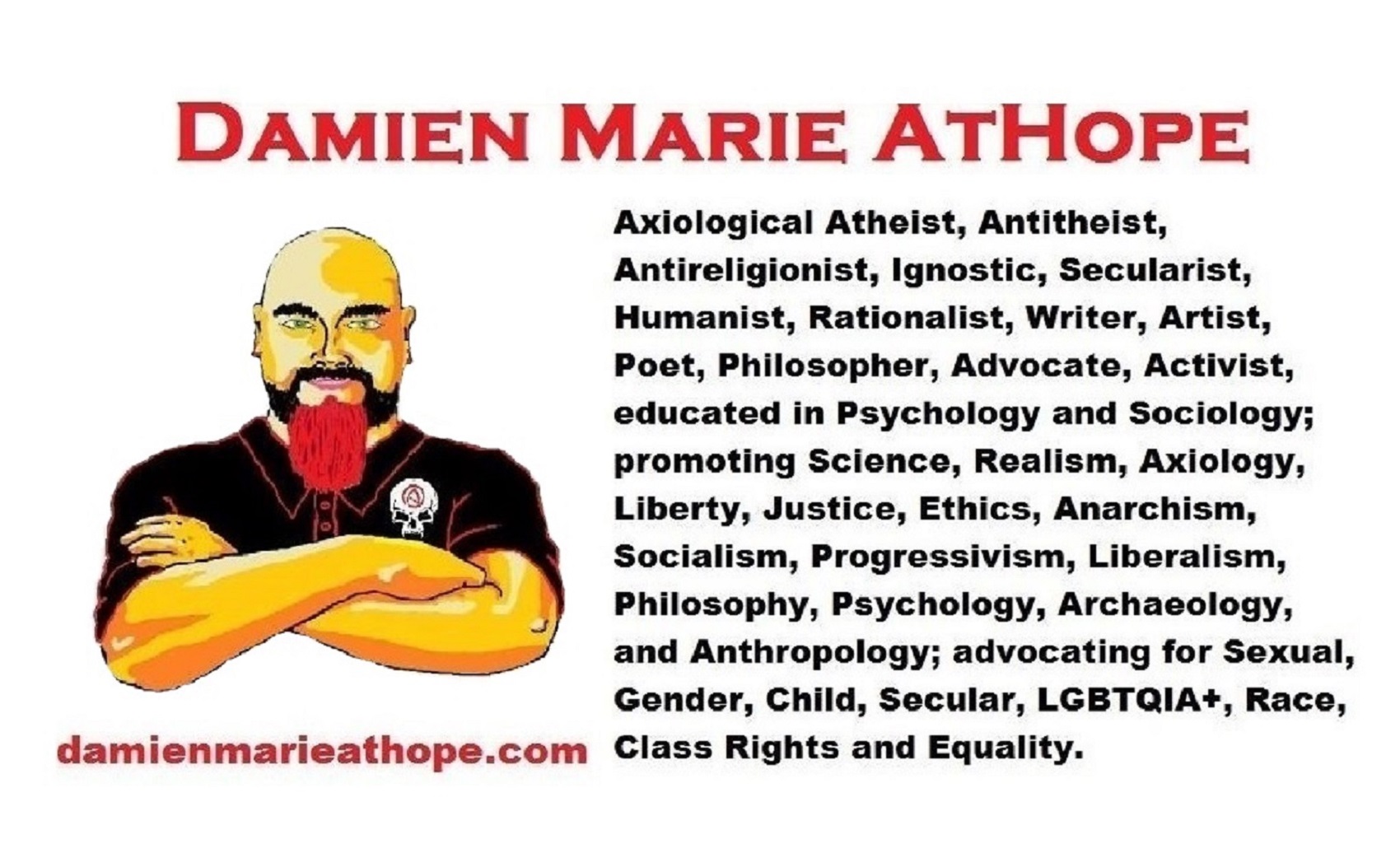

ref, ref, ref, ref, ref, ref, ref
Totemism is associated with kinship and the veneration of some natural objects, animals, plants, elements, and other physical objects, believed to have some spiritual or supernatural powers. So, harming of totemic animals is considered a taboo in most African cultures. Animism (‘breath, spirit, life’) belief objects, places, and nature may possess spiritual essence spirit.
Animism
“Animism (from Latin: anima, ‘breath, spirit, life‘) is the belief that objects, places, and creatures all possess a distinct spiritual essence. Potentially, animism perceives all things—animals, plants, rocks, rivers, weather systems, human handiwork, and perhaps even words—as animated and alive. Animism is used in the anthropology of religion as a term for the belief system of many indigenous peoples, especially in contrast to the relatively more recent development of organised religions. Although each culture has its own different mythologies and rituals, animism is said to describe the most common, foundational thread of indigenous peoples’ “spiritual” or “supernatural” perspectives. The animistic perspective is so widely held and inherent to most indigenous peoples that they often do not even have a word in their languages that corresponds to “animism” (or even “religion”); the term is an anthropological construct.” ref
“Aka people” Central African nomadic Mbenga pygmy people (Animist)
“Aka are very warm and hospitable. Relationships between men and women are extremely egalitarian. Men and women contribute equally to a household’s diet, either a husband or wife can initiate divorce, and violence against women is very rare. No cases of rape have been reported. The Aka are fiercely egalitarian and independent. No individual has the right to force or order another individual to perform an activity against his or her will. Aka have a number of informal methods for maintaining their egalitarianism. First, they practice “prestige avoidance”; no one draws attention to his or her own abilities. Individuals play down their achievements.” ref
Mbuti People of the Congo (Animist)
“The Mbuti hunter-gatherers in the Congo’s Ituri Forest have traditionally lived in stateless communities with gift economies and largely egalitarian gender relations. They were a people who had found in the forest something that made life more than just worth living, something that made it, with all its hardships and problems and tragedies, a wonderful thing full of joy and happiness and free of care. Pygmies, like the Inuit, minimize discrimination based upon sex and age differences. Adults of all genders make communal decisions at public assemblies. The Mbuti do not have a state, or chiefs or councils.” ref
Hadza people of East Africa (Animist)
“The Hadza of Tanzania in East Africa are egalitarian, meaning there are no real status differences between individuals. While the elderly receive slightly more respect, within groups of age and sex all individuals are equal, and compared to strictly stratified societies, women are considered fairly equal. This egalitarianism results in high levels of freedom and self-dependency. When conflict does arise, it may be resolved by one of the parties voluntarily moving to another camp. Ernst Fehr and Urs Fischbacher point out that the Hadza people “exhibit a considerable amount of altruistic punishment” to organize these tribes. The Hadza live in a communal setting and engage in cooperative child-rearing, where many individuals (both related and unrelated) provide high-quality care for children. Having no tribal or governing hierarchy, the Hadza trace descent bilaterally (through paternal and maternal lines), and almost all Hadza can trace some kin tie to all other Hadza people. ” ref


ref, ref, ref, ref, ref, ref, ref, ref, ref, ref, ref, ref, ref, ref, ref, ref, ref, ref, ref, ref, ref
Low Gods “Earth” or Tutelary deity and High Gods “Sky” or Supreme deity
“An Earth goddess is a deification of the Earth. Earth goddesses are often associated with the “chthonic” deities of the underworld. Ki and Ninhursag are Mesopotamian earth goddesses. In Greek mythology, the Earth is personified as Gaia, corresponding to Roman Terra, Indic Prithvi/Bhūmi, etc. traced to an “Earth Mother” complementary to the “Sky Father” in Proto-Indo-European religion. Egyptian mythology exceptionally has a sky goddess and an Earth god.” ref
“A mother goddess is a goddess who represents or is a personification of nature, motherhood, fertility, creation, destruction or who embodies the bounty of the Earth. When equated with the Earth or the natural world, such goddesses are sometimes referred to as Mother Earth or as the Earth Mother. In some religious traditions or movements, Heavenly Mother (also referred to as Mother in Heaven or Sky Mother) is the wife or feminine counterpart of the Sky father or God the Father.” ref
Tutelary deity
“A tutelary (also tutelar) is a deity or spirit who is a guardian, patron, or protector of a particular place, geographic feature, person, lineage, nation, culture, or occupation. The etymology of “tutelary” expresses the concept of safety and thus of guardianship. In late Greek and Roman religion, one type of tutelary deity, the genius, functions as the personal deity or daimon of an individual from birth to death. Another form of personal tutelary spirit is the familiar spirit of European folklore.” ref

Hinduism around 3,700 to 3,500 years old. ref
Judaism around 3,450 or 3,250 years old. (The first writing in the bible was “Paleo-Hebrew” dated to around 3,000 years ago Khirbet Qeiyafa is the site of an ancient fortress city overlooking the Elah Valley. And many believe the religious Jewish texts were completed around 2,500) ref, ref
Judaism is around 3,450 or 3,250 years old. (“Paleo-Hebrew” 3,000 years ago and Torah 2,500 years ago)
“Judaism is an Abrahamic, its roots as an organized religion in the Middle East during the Bronze Age. Some scholars argue that modern Judaism evolved from Yahwism, the religion of ancient Israel and Judah, by the late 6th century BCE, and is thus considered to be one of the oldest monotheistic religions.” ref
“Yahwism is the name given by modern scholars to the religion of ancient Israel, essentially polytheistic, with a plethora of gods and goddesses. Heading the pantheon was Yahweh, the national god of the Israelite kingdoms of Israel and Judah, with his consort, the goddess Asherah; below them were second-tier gods and goddesses such as Baal, Shamash, Yarikh, Mot, and Astarte, all of whom had their own priests and prophets and numbered royalty among their devotees, and a third and fourth tier of minor divine beings, including the mal’ak, the messengers of the higher gods, who in later times became the angels of Judaism, Christianity and Islam. Yahweh, however, was not the ‘original’ god of Israel “Isra-El”; it is El, the head of the Canaanite pantheon, whose name forms the basis of the name “Israel”, and none of the Old Testament patriarchs, the tribes of Israel, the Judges, or the earliest monarchs, have a Yahwistic theophoric name (i.e., one incorporating the name of Yahweh).” ref
“El is a Northwest Semitic word meaning “god” or “deity“, or referring (as a proper name) to any one of multiple major ancient Near Eastern deities. A rarer form, ‘ila, represents the predicate form in Old Akkadian and in Amorite. The word is derived from the Proto-Semitic *ʔil-, meaning “god”. Specific deities known as ‘El or ‘Il include the supreme god of the ancient Canaanite religion and the supreme god of East Semitic speakers in Mesopotamia’s Early Dynastic Period. ʼĒl is listed at the head of many pantheons. In some Canaanite and Ugaritic sources, ʼĒl played a role as father of the gods, of creation, or both. For example, in the Ugaritic texts, ʾil mlk is understood to mean “ʼĒl the King” but ʾil hd as “the god Hadad“. The Semitic root ʾlh (Arabic ʾilāh, Aramaic ʾAlāh, ʾElāh, Hebrew ʾelōah) may be ʾl with a parasitic h, and ʾl may be an abbreviated form of ʾlh. In Ugaritic the plural form meaning “gods” is ʾilhm, equivalent to Hebrew ʾelōhîm “powers”. In the Hebrew texts this word is interpreted as being semantically singular for “god” by biblical commentators. However the documentary hypothesis for the Old Testament (corresponds to the Jewish Torah) developed originally in the 1870s, identifies these that different authors – the Jahwist, Elohist, Deuteronomist, and the Priestly source – were responsible for editing stories from a polytheistic religion into those of a monotheistic religion. Inconsistencies that arise between monotheism and polytheism in the texts are reflective of this hypothesis.” ref
Jainism around 2,599 – 2,527 years old. ref
Confucianism around 2,600 – 2,551 years old. ref
Buddhism around 2,563/2,480 – 2,483/2,400 years old. ref
Christianity around 2,o00 years old. ref
Shinto around 1,305 years old. ref
Islam around 1407–1385 years old. ref
My thoughts on religious progression, and reasoned speculations from the evidence:
Animism (100,000 years ago)
Totemism (50/45,000 years ago)
Shamanism (30/35,000 years ago)
Paganism (13/12,000 years ago)
“Institutional” Progressed Organized Religion (5,000 years ago)
Religion Progression
- Animism (belief in a perceived spirit world) passably by at least 100,000 years ago “the primal stage of early religion”
- Totemism (belief that these perceived spirits could be managed with created physical expressions) passably by at least 50,000 years ago “progressed stage of early religion”
- Shamanism (belief that some special person can commune with these perceived spirits on the behalf of others by way rituals) passably by at least 30,000 years ago
- Paganism “Early organized nature-based religion” mainly like an evolved shamanism with gods (passable by at least 13,000 years ago).
- Institutional religion developed stage of “Progressed Organized Type Religion” as a social institution with official dogma usually set in a hierarchical/bureaucratic structure that contains strict rules and practices dominating the believer’s life.
Religion Progression
1. Animism (belief in a perceived spirit world) passably by at least 100,000 years ago “the primal stage of early religion”
2. Totemism (belief that these perceived spirits could be managed with created physical expressions) passably by at least 50,000 years ago “progressed stage of early religion”
3. Shamanism (belief that some special person can commune with these perceived spirits on the behalf of others by way rituals) passably by at least 30,000 years ago
4. Paganism “Early organized religion” (passably by at least 13,000/12,000 to 5,000 years ago):
*primal stage of organized religion is 13,000 years ago.
*proto stage of organized religion is around 10,000 years ago.
*origin elements leading to the progressed stage of organized religion is around 7,000 years ago.
*developed stage of organized religion is around 5,000 years ago.
I classify Animism (animated ‘spirit‘ or “supernatural” perspectives).
I see all religious people as at least animists, so, all religions have at least some amount, kind, or expression of animism as well.
I want to make something clear as I can, as simple as I can, even though I classify Animism (animated and alive from Latin: anima, ‘breath, spirit, life‘ or peoples’ “spiritual” or “supernatural” perspectives. Potentially, in some animism perceives, all things may relate to some spiritual/supernatural/non-natural inclinations, even a possible belief that objects, places, and/or creatures all possess a distinct spiritual essence, and/or thinking things like all things—animals, plants, rocks, rivers, weather systems, human handiwork, and perhaps even words— could be as animated and alive ref) as the first expression of religious thinking or religion, it is not less than, nor is it not equal to any other religion, or religious thinking. I see all religious people as at least animists any way, so everyone is at least animist, how could it be less than other religions as all other religions have at least some amount, kind, or expression of animism. Animism, +? is what I think about all that say they are spiritual or religious in thinking. Regardless if they know it, understand it, or claim it, they all, to me, an animistic-thinker, plus a paganistic, totemistic, and shamanistic-monotheist, calling themselves a Christian, Jew, or Muslim, as an example of my thinking. Animism (is the other-then-reality thinking relates to, thus it is in all such non-reality thinking generally.
Furthermore, I actually am impressed by animist cultures in Africa, others have seen them as primitive or something, help with that, they are revolutionaries with women’s rights, child rights. I mean if I had to choose a religion it would be animism only like in Africa so I don’t look down on them nor any indigenous peoples, who I care about, as well as I am for “humanity for all.” I challenge religious Ideas, and this is not meant to be an attack on people, but rather a challenge to think or rethink ideas, I want what is actually true. May we all desire a truly honest search for what is true even if we have to update what we believe or know. I even have religious friends, as I am not a bigot.
I class religious thinking in “time of origin” not somehow that any are better or worse or more reasoned than others. No, I am trying to help others understand how things happened, so they understand, and for themselves can finally think does the religion they say they believe in, still seems true, as they believed before learning my information and art. I am hoping I inspire freedom of thought and development of heart as well as mind as we need such a holistic approach in our quest for a humanity free for all and supportive of all. Until then, train your brain to think ethically. We are responsible for the future, we are the future, living in the present, soon to be passed, so we must act with passion, because life is over just like that. I am just another fellow dignity being. May I be a good human.
Here are a few of what I see as “Animist only” Cultures:
“Aka people” Central African nomadic Mbenga pygmy people. PRONUNCIATION: AH-kah
“The Aka people are very warm and hospitable. Relationships between men and women are extremely egalitarian. Men and women contribute equally to a household’s diet, either a husband or wife can initiate divorce, and violence against women is very rare. No cases of rape have been reported. The Aka people are fiercely egalitarian and independent. No individual has the right to force or order another individual to perform an activity against his or her will. Aka people have a number of informal methods for maintaining their egalitarianism. First, they practice “prestige avoidance”; no one draws attention to his or her own abilities. Individuals play down their achievements.” ref
“Mbuti People”
“The Mbuti people are generally hunter-gatherers who commonly are in the Congo’s Ituri Forest have traditionally lived in stateless communities with gift economies and largely egalitarian gender relations. They were a people who had found in the forest something that made life more than just worth living, something that made it, with all its hardships and problems and tragedies, a wonderful thing full of joy and happiness and free of care. Pygmies, like the Inuit, minimize discrimination based upon sex and age differences. Adults of all genders make communal decisions at public assemblies. The Mbuti people do not have a state, or chiefs or councils.” ref
“Hadza people”
“The Hadza people of Tanzania in East Africa are egalitarian, meaning there are no real status differences between individuals. While the elderly receive slightly more respect, within groups of age and sex all individuals are equal, and compared to strictly stratified societies, women are considered fairly equal. This egalitarianism results in high levels of freedom and self-dependency. When conflict does arise, it may be resolved by one of the parties voluntarily moving to another camp. Ernst Fehr and Urs Fischbacher point out that the Hadza people “exhibit a considerable amount of altruistic punishment” to organize these tribes. The Hadza people live in a communal setting and engage in cooperative child-rearing, where many individuals (both related and unrelated) provide high-quality care for children. Having no tribal or governing hierarchy, the Hadza people trace descent bilaterally (through paternal and maternal lines), and almost all Hadza people can trace some kin tie to all other Hadza people.” ref
*Primal superstition starts around 1 million years ago with. Then the development of religion increased around 600,000 years ago with proto superstition and then even to a greater extent around 300,000 years ago with progressed superstition.
Around 100,000 years ago, is the primal stage of early religion, the proto stage of early religion is around 75,000 years ago, or less, the progressed stage of early religion is around 50,000 years ago and finally after 13,500 years ago, begins with the evolution of organized religion. The set of stages for the development of organized religion is subdivided into the following: the primal stage of organized religion is 13,000 years ago, the proto stage of organized religion is around 10,000 years ago, and finally the progressed stage of organized religion is around 7,000 years ago with the forming of mythology and its connected set of Dogmatic-Propaganda-Closure belief strains of sacralized superstitionism. I will now give offer my rough outlined four-stage hypotheses, which use the reference of a house, in order to help to explain the way how that house (modern religions) fully developed a packet of wishful thinking nonsense, in order to assist in grasping the relative big picture of both the original elements that are involved in what often became a variety of nonrealism/unrealistic faiths or beliefs around the world. Moreover, this relative compiled a set of nonrealism faith or belief components (animism, totemism, and paganism) that are often still found in almost all religions today. My hypothesis with an explanation of this house (modern religions development).
- First, there is the foundation: Superstitionism and Symbolism/Ritualism.
- Second, is the frame and walls: Supernaturalism and Sacralizism/Spiritualism.
- Third, is the roof and finishing elements of the structure: Dogmatism and Myths.
- Fourth, is the window dressing and stylings to the house: decorated with the webs religious Dogmatic-Propaganda.
In the stage of organized religion, one important aspect that is often overlooked because of male-only thinking or by some over-emphasized because of extreme feminism is gender. There are some obvious gender associations in artifacts and possible gender-involved religious beliefs but thoughtful feminist archaeologists do not pounce on every representation of a woman and pronounce that it is a goddess. Around 5,000 years ago there are the full elements seem to be grouping together with its connected set of Dogmatic-Propaganda-Closure belief strains of sacralized superstitionism that took different forms of behavior in different areas of the world.
Interconnectedness of religious thinking Animism, Totemism, Shamanism, and Paganism
So, it all starts in a general way with Animism (theoretical belief in supernatural powers/spirits), then this is physically expressed in or with Totemism (theoretical belief in mythical relationship with powers/spirits through a totem item), which then enlists a full-time specific person to do this worship and believed interacting Shamanism (theoretical belief in access and influence with spirits through ritual), and then there is the further employment of myths and gods added to all the above giving you Paganism (often a lot more nature-based than most current top world religions, thus hinting to their close link to more ancient religious thinking it stems from). My hypothesis is expressed with an explanation of the building of a theatrical house (modern religions development ending with Institutional religion/organized religion).
Hidden Religious Expressions
“animist, totemist, shamanist & paganist”
*Believe in spirit-filled life and/or afterlife (you are a hidden animist)
*Believe in spirit-filled life and/or afterlife can be attached to or be expressed in things or objects (you are a hidden totemist)
*Believe in spirit-filled life and/or afterlife can be attached to or be expressed in things or objects and these objects can be used by special persons or in special rituals can connect to spirit-filled life and/or afterlife (you are a hidden shamanist)
*Believe in spirit-filled life and/or afterlife can be attached to or be expressed in things or objects and these objects can be used by special persons or in special rituals can connect to spirit-filled life and/or afterlife who are guided/supported by a goddess/god or goddesses/gods (you are a hidden paganist)
Primal early superstition starts around 1 million years ago with. Then the development of religion increased around 600,000 years ago with proto superstition and then even to a greater extent around 300,000 years ago with progressed superstition. Around 100,000 years ago, is the primal stage of early religion, the proto stage of religion is around 75,000 years ago, or less, the progressed stage of early religion is around 50,000 years ago and finally after 13,500 years ago, begins with the evolution of organized religion. The set of stages for the development of organized religion is subdivided into the following: the primal stage of early organized religion is 13,000 years ago, the proto stage of organized religion is around 10,000 years ago, and finally the progressed stage of organized religion is around 7,000 years ago with the forming of mythology and its connected set of Dogmatic-Propaganda-Closure belief strains of sacralized superstitionism. In the stage of organized religion, one important aspect that is often overlooked because of male-only thinking or by some over-emphasized because of extreme feminism is gender. There are some obvious gender associations in artifacts and possible gender-involved religious beliefs but thoughtful feminist archaeologists do not pounce on every representation of a woman and pronounce that it is a goddess. Around 5,000 years ago elements seem to be grouping together with its connected set of Dogmatic-Propaganda-Closure belief strains of sacralized superstitionism that took different forms of behavior in different areas of the world.
Promoting Religion as Real is Harmful?
Sometimes, when you look at things, things that seem hidden at first, only come clearer into view later upon reselection or additional information. So, in one’s earnest search for truth one’s support is expressed not as a one-time event and more akin to a life’s journey to know what is true. I am very anti-religious, opposing anything even like religion, including atheist church. but that’s just me. Others have the right to do atheism their way. I am Not just an Atheist, I am a proud antireligionist. I can sum up what I do not like about religion in one idea; as a group, religions are “Conspiracy Theories of Reality.” These reality conspiracies are usually filled with Pseudo-science and Pseudo-history, often along with Pseudo-morality and other harmful aspects and not just ancient mythology to be marveled or laughed at. I regard all this as ridiculous. Promoting Religion as Real is Mentally Harmful to a Flourishing Humanity To me, promoting religion as real is too often promotes a toxic mental substance that can divide a person from who they are shaming them for being human. In addition, religion is a toxic mental substance that can divide a person from real history, real science or real morality to pseudohistory, pseudoscience, and pseudomorality. Moreover, religion is a toxic mental substance that can divide a person from rational thought, critical thinking, or logic. Likewise, religion is a toxic mental substance that can divide a person from justice, universal ethics, equality, and liberty. Yes, religion is a toxic mental substance that can divide a person from loved ones, and religion is a toxic mental substance that can divide a person from humanity. Therefore, to me, promoting religion as real is too often promote a toxic mental substance that should be rejected as not only false but harmful as well even if you believe it has some redeeming quality. To me, promoting religion as real is mentally harmful to a flourishing humanity. Religion may have once seemed great when all you had or needed was to believe. Science now seems great when we have facts and need to actually know.
A Rational Mind Values Humanity and Rejects Religion and Gods
A truly rational mind sees the need for humanity, as they too live in the world and see themselves as they actually are an alone body in the world seeking comfort and safety. Thus, see the value of everyone around them as they too are the same and therefore rationally as well a humanistically we should work for this humanity we are part of and can either dwell in or help its flourishing as we are all in the hands of each other. You are Free to think as you like but REALITY is unchanged. While you personally may react, or think differently about our shared reality (the natural world devoid of magic anything), We can play with how we use it but there is still only one communal reality (a natural non-supernatural one), which we all share like it or not and you can’t justifiably claim there is a different reality. This is valid as the only one of warrant is the non-mystical natural world around us all, existing in or caused by nature; not made or caused by superstitions like gods or other monsters, too many sill fear irrationally.
I know that god-something is is an unjustified and debunked claim of super supernatural when no supernatural any has ever been found to even start such claims. I am quite familiar with a general when and why gods were created. Gods are not in all religions nor their thinking. I believe that all claims of God will fail epistemic qualities need for belief and instead require disbelief in all of them, unless shown real epistemic value.
Every child born with horrific deformities shows that those who believe in a loving god who is in control and values every life is not just holding a ridiculous belief; it is an offensive belief to the compassion for life and a loving morality. Prayer is nothing like hope, as prayer is the Belief in magic and a thing one is believed they are praying to is magical things or beings. Hope is a desire or aspiration, not a Belief in magical things or you have additional beliefs added in that hope.
Religion removed? All its pseudo meaning as well as pseudoscience, pseudohistory, and pseudo-morality. We have real science, realistic history and can access real morality with a blend of philosophy, anthropology, psychology, sociology, and cognitive science. I do not hate simply because I challenge and expose myths or lies any more than others being thought of as loving simply because of the protection and hiding from challenge their favored myths or lies.
It is not a matter of being the only flame but to inspire us all to unify as one, to bring light to all we can. Be an honest thinker who values only reason and evidence as your main helpful guides. Follow an “ethics of belief” and don’t “believe what you like” rather what is justified soundly, thus let “Reason” be your master, and may you master “Reason.” Anger has been easier than care but it is my care I hold as value and it is this care, not some anger, I wish to inspire. In fact, I wish for us all to truly slow down and think, to add the needed care. Yea, we should do the needful, the worthy, and what is true. Reason rules.
No God: No evidence, No intelligence, and No goodness = Valid Atheism Conclusion
1. No evidence, To move past the Atheistic Null Hypothesis: There is no God/Gods (in inferential statistics, a Null Hypothesis generally assumed to be true until evidence indicates otherwise. Thus, a Null Hypothesis is a statistical hypothesis that there is no significant difference reached between the claim and the non-claim, as it is relatively provable/demonstratable in reality in some way. “The god question” Null Hypothesis is set at as always at the negative standard: Thus, holding that there is no God/Gods, and as god faith is an assumption of the non-evidentiary wishful thinking non-reality of “mystery thing” found in all god-talk, until it is demonstratable otherwise to change. Alternative hypothesis: There is a God (offered with no proof: what is a god and how can anyone say they know), therefore, results: Insufficient evidence to overturn the null hypothesis of no God/Gods.
2. No intelligence, Taking into account the reality of the world we do know with 99 Percent Of The Earth’s Species Are Extinct an intelligent design is ridiculous. Five Mass Extinctions Wiped out 99 Percent of Species that have ever existed on earth. Therefore like a child’s report card having an f they need to retake the class thus, profoundly unintelligent design.
3. No goodness, Assessed through ethically challenging the good god assumptions as seen in the reality of pain and other harm of which there are many to demonstrates either a god is not sufficiently good, not real or as I would assert, god if responsible for this world, would make it a moral monster ripe for the problem of evil and suffering (Argument from Evil). God would be responsible for all pain as life could easily be less painful and yet there is mass suffering. In fact, to me, every child born with diseases from birth screams out against a caring or loving god with the power to do otherwise. It could be different as there is Congenital insensitivity to pain (CIP), also known as congenital analgesia, in which a person cannot feel (and has never felt) physical pain.
My Thought on the Evolution of God?
Animal protector deities from old totems/spirit animal beliefs come first to me, 13,000/12,000 years ago, then women as deities 11,000/10,000 years ago, then male gods around 7,000 years ago. Then Moralistic gods around 5,000 years ago.
Silence is no virtue, especially against injustice, oppression, or untruths. From our natural only reality, there is no need to hide, for Atheism and a magic-free universe is the truth and theism religion and its supernatural thinking gods are just a lie. Truth deserves to be supported and has no need to remain silent and should instead, inspire its strong championing. I hear this call deep in me to bravely champion the truth of atheism and I do it with pride. To me, Animistic Somethingism: You just feel/think there has to be something supernatural/spirit-world or feel/think things are supernatural/spirit-filled. “Somethingism” is commonly an unspecified belief in an undetermined supernatural reality, stated sometimes as spiritual but not religious, but, to me, is basically unrealized animism. Vague Theism or god Somethingism: just say NO! May I remind you , vague theism, somethingism or “ietsism” is not some Philosophers Stone of Theism removed from strong critique.
So loudly, I will proclaim supernatural, and gods are willful mental illusions, confusions, and lies that are commonly inspired by a life of religious influences, religiously motivated fears, and or religious indoctrination. I laugh at questions like “what would convince you of god” as if I approach thinking differently dependent. As a rationalist I am always moved best by valid and reliable reason and evidence, you know the very stuff, all religions and any supernatural claim always lack in the end. Religion is big on claims but small of real reasoning, full of logical fallacies in thinking, and no evidence to quorate all their delusionary supernatural nonsense and superstitions.
My Antireligionism?
I will grant you some religious mythology is quite interesting but I never forget it is simple stories of hope, fear, and magical thinking arising from human ignorance fueled by imagination and presto people believe in things never seen. I hate religion as I hate harm, oppression, bigotry, and love equality, self-ownership, self-empowerment, self-actualization including self-mastery, as well as truth and not only does religion lie, it is a conspiracy theory of reality. I know that god-something is is an unjustified and debunked claim of super supernatural when no supernatural any has ever been found to even start such claims.
I don’t think antireligionism is really anti-friendly-atheism, as it can involve being friendly to people even if it is harsh to religion, positive antireligionism or Anti-Accommodationism is attacking bad thinking and bad behaviors, not just people who believe. Not just an atheist and antitheist, I am a proud anti-religionist. I have greater confidence in science as they often admit errors and I have greater mistrust of religion as they often refuse to accept or admit errors.
What I do not like about religion in one idea, religions as a group are “Conspiracy Theories of Reality,” usually filled with Pseudoscience, Pseudohistory, along with Pseudomorality, and other harmful aspects. An antireligionist generally means opposition to religion, this includes all, every religion or pseudo-religion, YES, I am an atheist and antitheist, who is “Anti” ALL RELIGIONS. But I am against the ideas, not people. We regrettably pay our life debt in our time lost living one moment at a time which seems to group together into what we call a life, so live as there just went another lost moment.
“But Damien, Souls are real because energy does not die!”
My response, That is a logical fallacy as it is not a reasoned jump in logic. Energy leaves all once alive bodies by dissipating heat in the environment then is gone as the once related energy in a now dead body.
I strive to be a good human ethical in both my thinking and behaviors thus I strive to be:
Anti-racist, Anti-sexist, Anti-homophobic, Anti-biphobic. Anti-transphobic, Anti-classist, Anti-ablest, Anti-ageist, and as Always ???? Antifascist ????
In fact, I want to strive to avoid as much as I can bigoted thinking towards others based on their perceived membership or classification based on that person’s perceived political affiliation (Well: within reason, justice, and ethics), sex/gender, beliefs (Well: within reason, justice, and ethics), social class (Well: within reason, justice, and ethics), age, disability, religion (Well: within reason, justice, and ethics), sexuality (Well: within reason, justice, and ethics), race, ethnicity, language (Well: within reason, justice, and ethics), nationality, beauty, height, occupation (Well: within reason, justice, and ethics), wealth (Well: within reason, justice, and ethics), education, sport-team affiliation, music tastes or other personal characteristics (Well: within reason, justice, and ethics).
Although, I am a “very”, yes, VERY strong atheist, antitheist as well as antireligionist, My humanity is just as strong and I value it above my disbeliefs. My kind of people are those who champion humanity, the ones who value kindness, love justice, and support universal empowerment for all humans, we are all equal in dignity, and all deserve human rights, due self-sovereignty.


I am a light in the dark, it always hurts your eyes at first but even my haters start to love me for who I am.
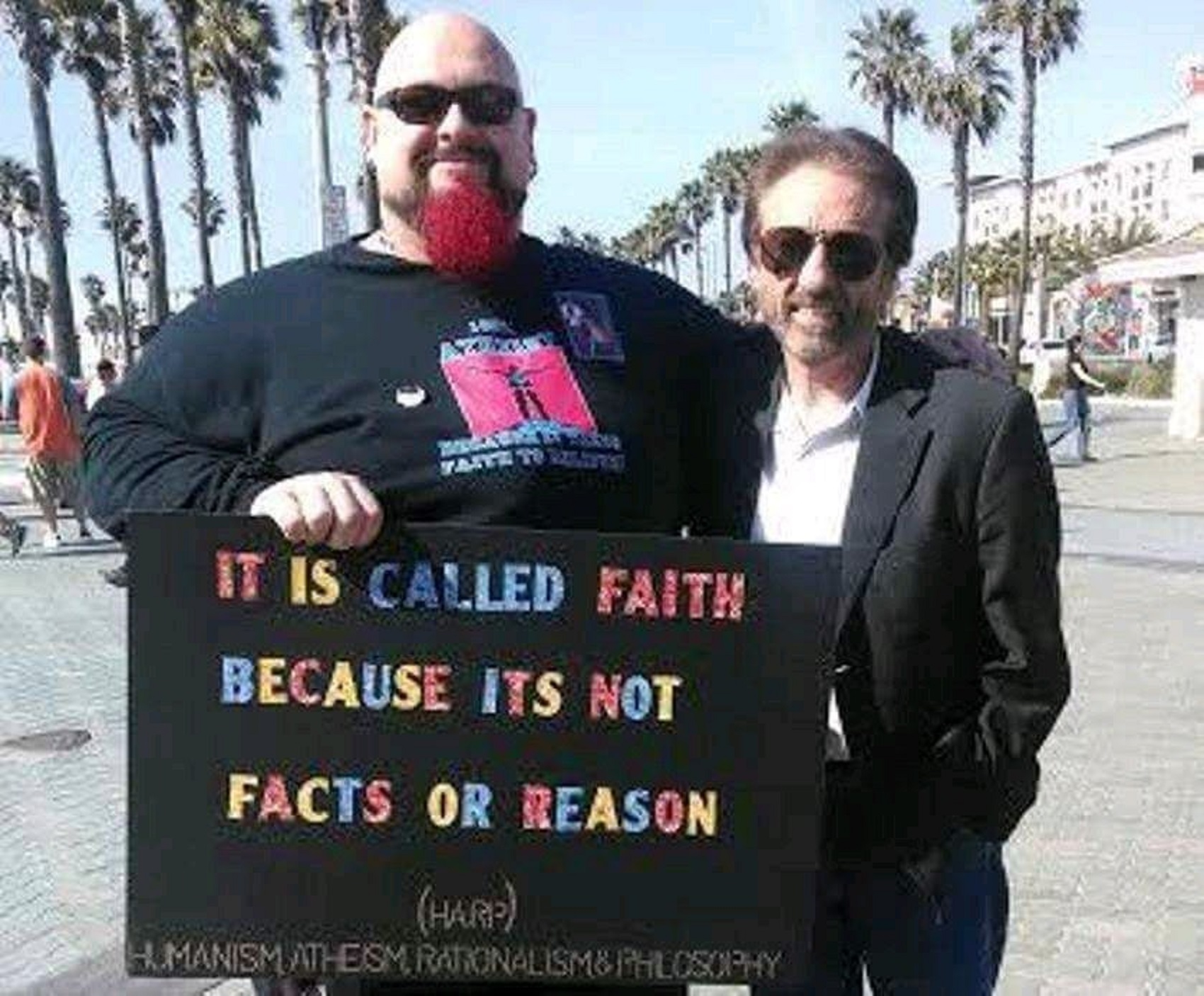
My Quick response from Ray Comfort’s Movie Noah: VIEDO
Quick video of me answering Eric Hovind’s questions: VIEDO
American Atheist Challenges Calgary Street Church: VIEDO
Atheist in a Wheelchair challenges a street preacher: VIEDO
My speech at the Bring Back our Motto Atheist rally: VIEDO
“The Tree of Lies and its Hidden Roots” Discussing the Evolution of Religion: VIEDO
Axiological Atheism: A Conversation with Atheist Damien AtHope (Apologetics Academy): VIDEO
The Evolution of Religion and Removing the Rationale of Faith: VIEDO
Speech on the Evolution of Religion & Religious Sexism: VIEDO
Animism, Totemism, Shamanism, Paganism & Progressed organized religion: VIEDO
Understanding Religion Evolution (Mount Vernon) with good Q & A: VIEDO
The Archaeological/Anthropological Evolution of Religion: VIEDO
My Understanding of Religion Evolution (with an atheist Meetup group, a presentation in Pasco, WA): VIEDO
Trying to Help Promote Knowledge: Philosophy and Science: VIEDO
Hammer of Truth: Yes, you too, have lots of beliefS: VIEDO
Ethnographer/Anthropologist Saumya Sharma: VIEDO
Religious Fallacies: Appeal to Emotion: VIEDO
Sound thinking, Presumptive-value, Axiology, and Disciplined-Rationality: VIEDO
I am a “Scientific Axiology” minded “Philosophic Axiologist Theorist”: VIEDO
Discussing Leadership and Prehistory with Leader Deanna L. Lawlis: VIEDO
Religion Evolution by Archaeology and Anthropology: VIEDO
No, Religion and Gods were not Created due to fear of Lightning: VIEDO
Don’t confuse beliefs, religion and science are two different epistemologies: VIEDO
Prehistory: related to “Anarchism and Socialism” the division of labor, power, rights, and recourses: VIEDO
Pre-Animism (at least 300,000 years ago): VIEDO
Pre-animism 300,000 years old and animism 100,000 years old: related to “Anarchism and Socialism”: VIEDO
Animism as in that seen in Africa: 100,000 years ago: VIEDO
“Totemism” as first seen in Europe: 50,000 years ago: VIEDO
Totemism 50,000 years old: related to “Anarchism and Socialism”: VIDEO
Shamanism (as seen in Siberia: 30,000 years ago): VIEDO
Shamanism 30,000 years old: related to “Anarchism and Socialism”: VIEDO
Paganism (Turkey: 12,000 years ago): VIEDO
Paganism 12,000 years old: related to “Anarchism and Socialism” (Pre-Capitalism): VIEDO
Paganism: Goddesses around 12,000 years ago then Male Gods after 7,000 years ago: VIEDO
Chatting about Turkey spreading early paganism around 9,000 years ago: VIEDO
Early Atheistic Doubting: “2,570 Years Ago”: VIEDO
Chatting about the terms Atheist, Theist, Agnostic, Anti-theist, and Anti-religionist: VIEDO
Validity, Reliability, and Soundness Simplified as it Relates to Reasoning: VIEDO
Aron Ra interviewing me on my “Archaeological/Anthropological Understanding of Religion Evolution”: VIEDO
Truth Navigation: “Hammer of Truth”: VIEDO
The Origin of Language: Starts in Symbolism Around 100,000 years ago: VIEDO
Legesse Allyn: Writer/Researcher in Ancient Languages and Ancient Scripts: VIEDO
Lisa For Truth: Origins of Religion and Anthropology of Religion: VIEDO
Debunking Ancient Aliens and other Unsupported Pseudoscience Beliefs: VIEDO
Dear Mr. AtHope, The 20th Century is a Failed Atheist Century: VIEDO
The Rise of Inequality: patriarchy and state hierarchy inequality: VIEDO
Shifting through the Claims in support of Faith: VIEDO
Why do all monotheistic religions have a male god?: VIEDO
Video relating to my future book: “The Tree of Lies and its Hidden Roots”: VIEDO
My interview with Robert Rob Moore of Atheist Underground: VIEDO
Atheist Pastor: Historian Christopher Atlee: VIEDO
Bernard Lamborelle: Abrahamic Faith by Means of Deification: VIEDO
Stefan Milo: “Atheist Archaeologist YouTuber”: VIEDO
Interviewed by Jay at The Nevermore Tavern on My Prehistory Thinking: VIEDO
My (Close CHANCE) TV Opportunity Interview TO HOST A SHOW ON PREHISTORY: VIEDO
Discussing Beliefs, Bias, Prehistory, History, Archaeology, Anthropology, and Humanism: VIEDO
Interviewing Dr. David Miano, Historian, and Educational YouTuber: VIEDO
The History Voyagers, Gobekli Tepe: Show 1# the first temple: VIEDO
The History Voyagers, Gobekli Tepe: Show #2 the pillars: VIEDO
Deeply Discussing Anthropology, Archaeology, Psychology, Science, Atheism, Philosophy, and Religion: VIEDO
Chatting about My style of Atheism (with a theist fan): VIEDO
Witness a mental dynamite explosion, in the revolution that is Damien Marie AtHope: VIEDO
My American Atheist “MeetUp” Presentation, Evolution of all Religions, 100,000 to 4,000 years ago: VIEDO
Gillian Hovell: ‘The Muddy Archaeologist’ Ancient Historian & Archaeologist: VIEDO
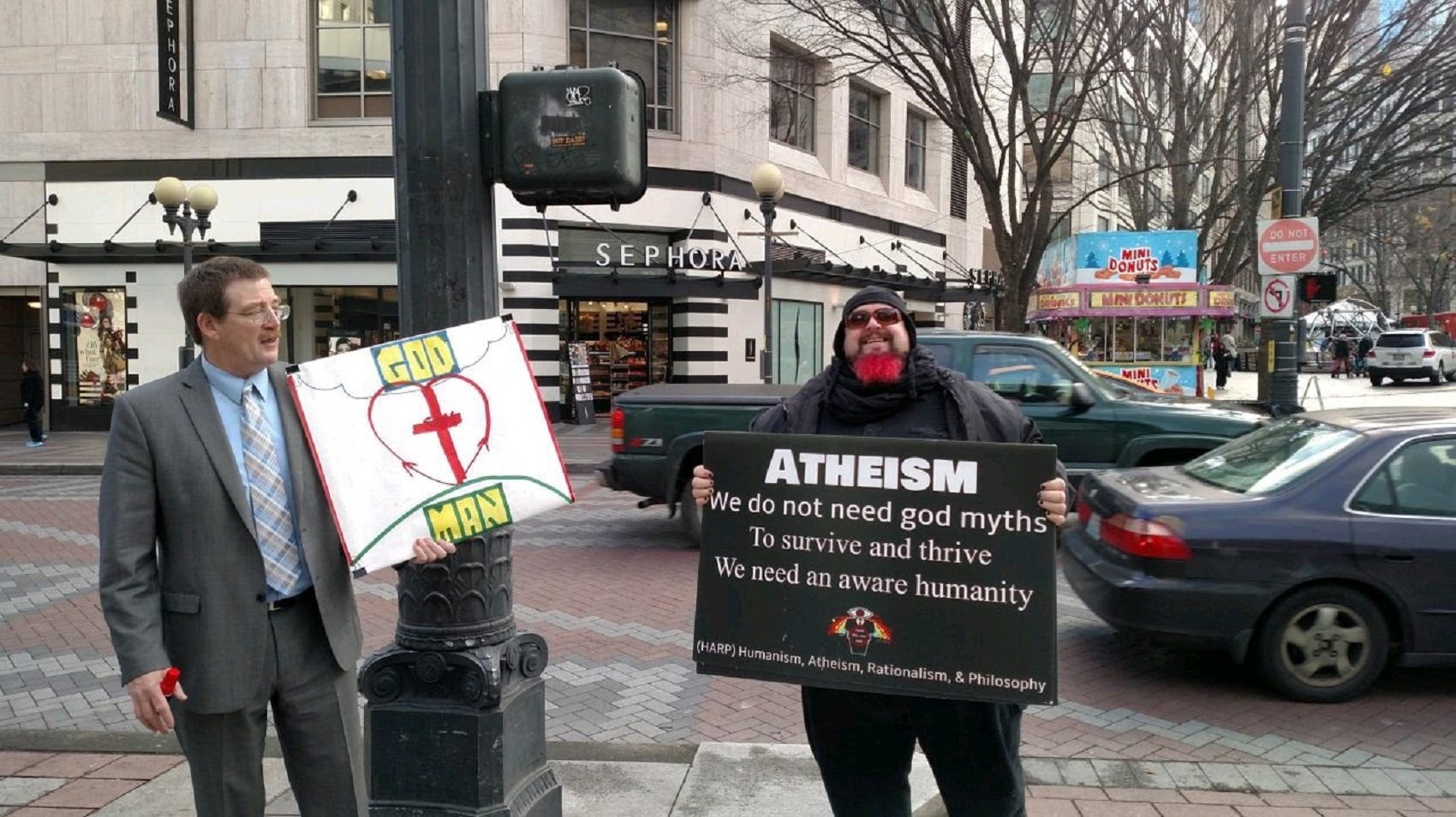





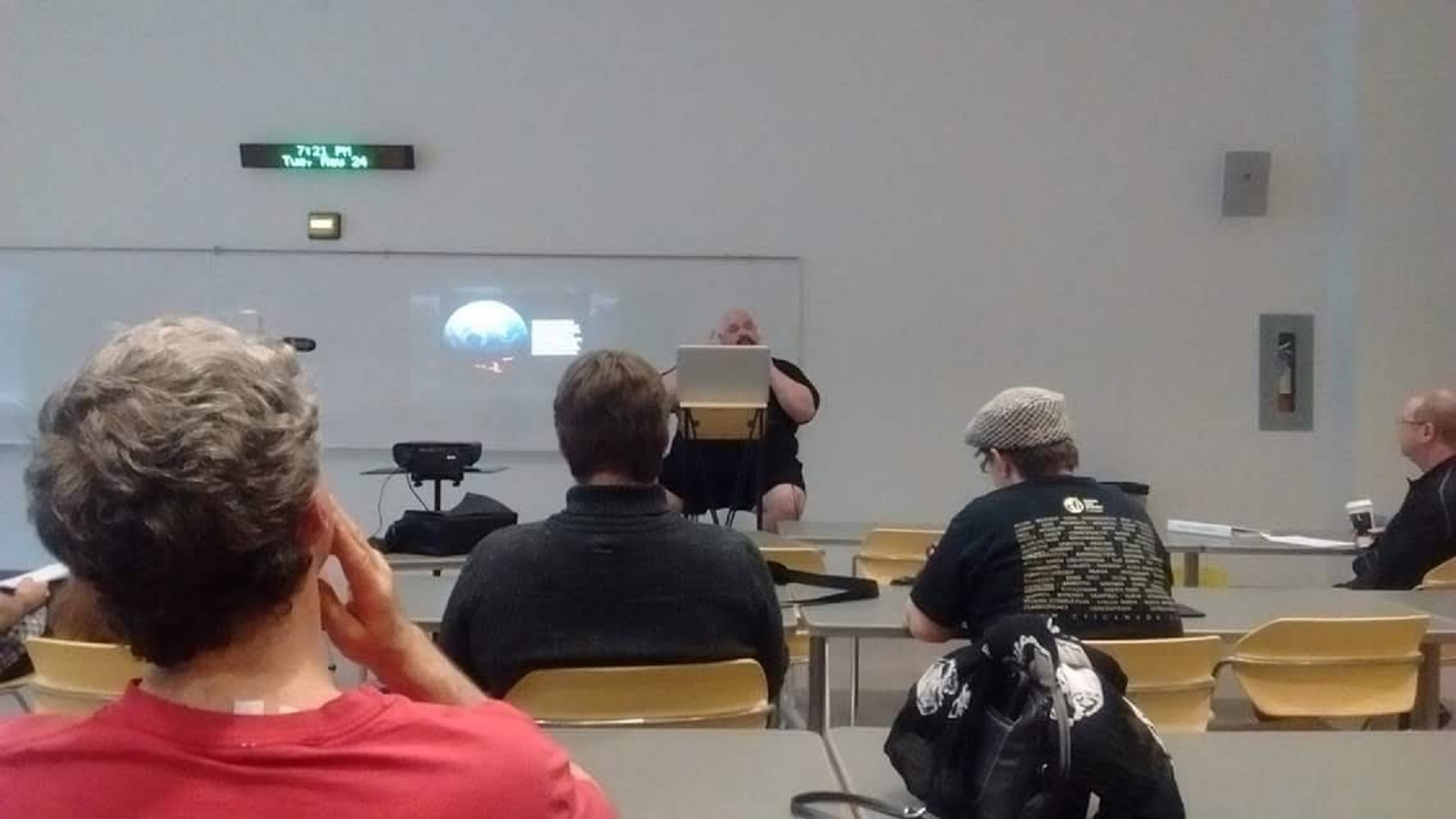
MY FIRST EVER PRESENTATION of my thoughts on the evolution of religion, IN EDMONTON CANIDA

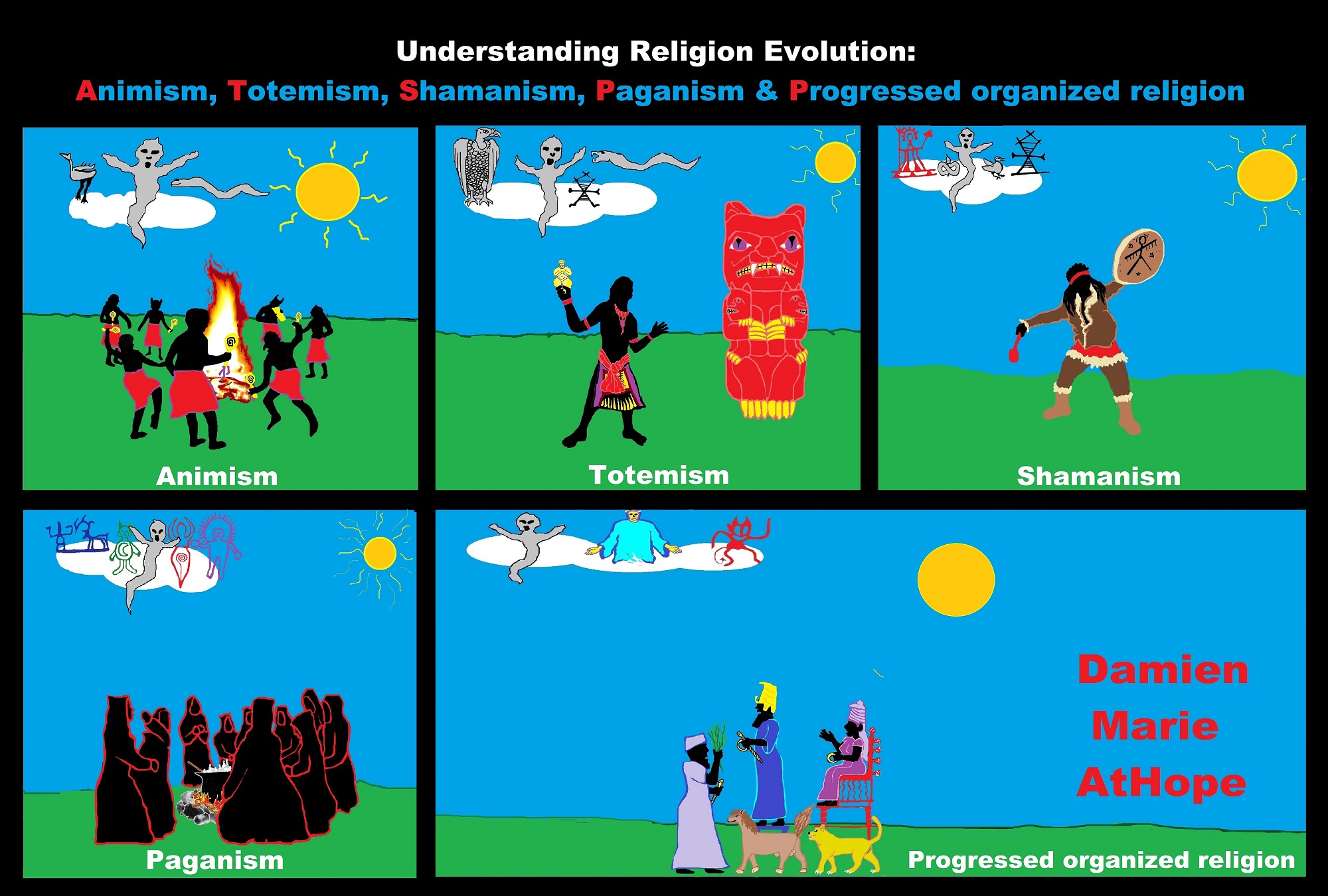
Understanding Religion Evolution:
- Pre-Animism (at least 300,000 years ago)
- Animism (Africa: 100,000 years ago)
- Totemism (Europe: 50,000 years ago)
- Shamanism (Siberia: 30,000 years ago)
- Paganism (Turkey: 12,000 years ago)
- Progressed organized religion (Egypt: 5,000 years ago), (Egypt, the First Dynasty 5,150 years ago)
- CURRENT “World” RELIGIONS (after 4,000 years ago)
- Early Atheistic Doubting (at least by 2,600 years ago)
“An Archaeological/Anthropological Understanding of Religion Evolution”
It seems ancient peoples had to survived amazing threats in a “dangerous universe (by superstition perceived as good and evil),” and human “immorality or imperfection of the soul” which was thought to affect the still living, leading to ancestor worship. This ancestor worship presumably led to the belief in supernatural beings, and then some of these were turned into the belief in gods. This feeble myth called gods were just a human conceived “made from nothing into something over and over, changing, again and again, taking on more as they evolve, all the while they are thought to be special,” but it is just supernatural animistic spirit-belief perceived as sacred.
Quick Evolution of Religion?
Pre-Animism (at least 300,000 years ago). So, it all starts in a general way with Animism (such as that seen in Africa: 100,000 years ago) (theoretical belief in supernatural powers/spirits), then this is physically expressed in or with Totemism (Europe: 50,000 years ago) (theoretical belief in mythical relationship with powers/spirits through a totem item), which then enlists a full-time specific person to do this worship and believed interacting Shamanism (beginning around 30,000 years ago in Siberia) (theoretical belief in access and influence with spirits through ritual), and then there is the further employment of myths and gods added to all the above giving you Paganism (beginning around 12,000 years ago in Turkey) (often a lot more nature-based than most current top world religions, thus hinting to their close link to more ancient religious thinking it stems from). My hypothesis is expressed with an explanation of the building of a theatrical house (modern religious development). Progressed organized religion (around 5,000 years ago as seen in Egypt) with CURRENT “World” RELIGIONS (after 4,000 years ago).
Historically, in large city-state societies (such as Egypt or Iraq) starting around 5,000 years ago culminated to make religion something kind of new, a sociocultural-governmental-religious monarchy, where all or at least many of the people of such large city-state societies seem familiar with and committed to the existence of “religion” as the integrated life identity package of control dynamics with a fixed closed magical doctrine, but this juggernaut integrated religion identity package of Dogmatic-Propaganda certainly did not exist or if developed to an extent it was highly limited in most smaller prehistoric societies as they seem to lack most of the strong control dynamics with a fixed closed magical doctrine (magical beliefs could be at times be added or removed). Many people just want to see developed religious dynamics everywhere even if it is not. Instead, all that is found is largely fragments until the domestication of religion.
Religions, as we think of them today, are a new fad, even if they go back to around 6,000 years in the timeline of human existence, this amounts to almost nothing when seen in the long slow evolution of religion at least around 70,000 years ago with one of the oldest ritual worship. Stone Snake of South Africa: “first human worship” 70,000 years ago. This message of how religion and gods among them are clearly a man-made thing that was developed slowly as it was invented and then implemented peace by peace discrediting them all. Which seems to be a simple point some are just not grasping how devastating to any claims of truth are when we can see the lie clearly in the archeological sites.
Paganism:
*primal stage of organized religion is 13,000 years ago.
*proto stage of organized religion is 10,000 years ago.
*progressed stage of organized religion “Myths Origin” is 7,000 years ago.
*developed stage of organized religion is 5,000 years ago.
- Paganism 12,000-7,000 years old: related to “Anarchism and Socialism” (Pre-Capitalism)
- Paganism 7,000-5,000 years old: related to “Anarchism and Socialism” (Capitalism) (World War 0) Elite and their slaves!
- Paganism 5,000 years old: progressed organized religion and the birth of the state: related to “Anarchism and Socialism” (Kings and the Rise of the State)
- Paganism 4,000 years old: Moralistic gods after the rise of Statism and often support Statism/Kings: related to “Anarchism and Socialism” (First Moralistic gods, then the Origin time of Monotheism)
Then from 5,000-4,000 years ago, moralistic deities are invented likely by or for the state. Then around 4,000 years ago monotheism emerges.
Paganism was more than shamanism at first it was about the clan leader from 13,000 to 7,000 years ago then from 7,000 until 5, 500 was a time of proto kings and by 5,000 kings were a growing norm.
The term “paganism”, used by me and some others who are academics, roughly refers to pre-Christian, socioreligious-cultural-based traditions which were polytheistic (worshiped multiple entities), and to me, I speculate also involve elements of Animism, Totemism, and shamanism; which together with polytheism are what I call paganism.
* “paganist” As I conceive it in a simplified way is to believe in spirit-filled life and/or afterlife can be attached to or be expressed in things or objects and these objects can be used by special persons or in special rituals can connect to spirit-filled life and/or afterlife who are guided/supported by a goddess/god or goddesses/gods (you are a hidden paganist/Paganism: an approximately 12,000-year-old belief system) And Gobekli Tepe: “first human-made temple” as well as Catal Huyuk “first religious designed city” are both evidence of some kind of early paganism, to me.
Again just to clarify when I refer to seeming paganism thinking or behaviors (emphasize reverence for nature, polytheistic and animistic, totemistic, and shamanist religious practices). and Gobekli Tepe, by paganism I mean a grouped set of behaviors that I believe resemble the concept of paganism-type beliefs. Neither am I claiming to fully know or understand all the possible mythology beliefs that may be represented in the carving at Gobekli Tepe, some seem more straightforward others beyond current understanding, and possibly forever beyond full comprehension.
“Paganism was originally a pejorative and derogatory term for polytheism, implying its inferiority. Paganism (from classical Latin refers to “rural, rustic,” later “civilian”) is a term first used in the fourth century by early Christians for people who practiced polytheism.” ref
“However, Paganism as a term of meaning represents a wide variety of traditions that emphasize reverence for nature and a revival of ancient polytheistic and animistic religious practices. Paganism is not a traditional religion per se because it does not have any official doctrine, but it does have some common characteristics joining the great variety of traditions. One of the common beliefs is the divine presence in nature and the reverence of the natural order in life. Spiritual growth is related to the cycles of the Earth and great emphasis is placed on ecological concerns. Monotheism is almost universally rejected within Paganism and most Pagan traditions are particularly interested in the revival of ancient polytheist religious traditions.” ref
“Religion may be defined as “a set of beliefs concerning the cause, nature, and purpose of the universe, especially when considered as the creation of a superhuman agency or agencies, usually involving devotional and ritual observances, and often containing a moral code governing the conduct of human affairs,” whereas ritual is “an established or prescribed procedure for religious or other rites.” ref
*Primal superstition starts around 1 million years ago with. Then the development of religion increased around 600,000 years ago with proto superstition and then even to a greater extent around 300,000 years ago with progressed superstition.
Around 100,000 years ago, is the primal stage of early religion, the proto stage of early religion is around 75,000 years ago, or less, the progressed stage of early religion is around 50,000 years ago and finally after 13,500 years ago, begins with the evolution of organized religion. The set of stages for the development of organized religion is subdivided into the following: the primal stage of organized religion is 13,000 years ago, the proto stage of organized religion is around 10,000 years ago, and finally the progressed stage of organized religion is around 7,000 years ago with the forming of mythology and its connected set of Dogmatic-Propaganda-Closure belief strains of sacralized superstitionism. I will now give offer my rough outlined four-stage hypotheses, which use the reference of a house, in order to help to explain the way how that house (modern religions) fully developed a packet of wishful thinking nonsense, in order to assist in grasping the relative big picture of both the original elements that are involved in what often became a variety of nonrealism/unrealistic faiths or beliefs around the world. Moreover, this relative compiled a set of nonrealism faith or belief components (animism, totemism, and paganism) that are often still found in almost all religions today. My hypothesis with an explanation of this house (modern religions development).
- First, there is the foundation: Superstitionism and Symbolism/Ritualism.
- Second, is the frame and walls: Supernaturalism and Sacralizism/Spiritualism.
- Third, is the roof and finishing elements of the structure: Dogmatism and Myths.
- Fourth, is the window dressing and stylings to the house: decorated with the webs religious Dogmatic-Propaganda.
In the stage of organized religion, one important aspect that is often overlooked because of male-only thinking or by some over-emphasized because of extreme feminism is gender. There are some obvious gender associations in artifacts and possible gender-involved religious beliefs but thoughtful feminist archaeologists do not pounce on every representation of a woman and pronounce that it is a goddess. Around 5,000 years ago there are the full elements seem to be grouping together with its connected set of Dogmatic-Propaganda-Closure belief strains of sacralized superstitionism that took different forms of behavior in different areas of the world.
Hidden Religious Expressions
“animist, totemist, shamanist & paganist”
*Believe in spirit-filled life and/or afterlife (you are a hidden animist)
*Believe in spirit-filled life and/or afterlife can be attached to or be expressed in things or objects (you are a hidden totemist)
*Believe in spirit-filled life and/or afterlife can be attached to or be expressed in things or objects and these objects can be used by special persons or in special rituals can connect to spirit-filled life and/or afterlife (you are a hidden shamanist)
*Believe in spirit-filled life and/or afterlife can be attached to or be expressed in things or objects and these objects can be used by special persons or in special rituals can connect to spirit-filled life and/or afterlife who are guided/supported by a goddess/god or goddesses/gods (you are a hidden paganist)
I classify Animism (animated ‘spirit‘ or “supernatural” perspectives).
I see all religious people as at least animists, so, all religions have at least some amount, kind, or expression of animism as well.
The door of reason opens not once but many times.
Religions continuing in our modern world, full of science and facts, should be seen as little more than a set of irrational conspiracy theories of reality. Nothing more than a confused reality made up of unscientific echoes from man’s ancient past. Rational thinkers must ask themselves why continue to believe in religions’ stories. Religion myths which are nothing more than childlike stories and obsolete tales once used to explain how the world works, acting like magic was needed when it was always only nature. These childlike religious stories should not even be taken seriously, but sadly too often they are. Often without realizing it, we accumulate beliefs that we allow to negatively influence our lives. In order to bring about awareness, we need to be willing to alter skewed beliefs. Rational thinkers must examine the facts instead of blindly following beliefs or faith.

Why are my tattoos Aztec themed?
I was raised in Southern California and have Hispanic/Mexican family members, so, I feel a connection, and like Mexican themes in culture and prehistory.
Just think of all you know now, because of me. lol
When was the last time you held yourself accountable for saying or doing something bigoted? If you were taken to Court could you be found guilty of a life lived in love? What is stopping you now from making yourself a better YOU?
My thoughts on the origin of Capitalism?
7,000-5,000 years old: (Capitalism: Elite & their slaves) https://www.patreon.com/posts/paganism-7-000-5-58451950
5,000 years old: (Kings and the State) https://www.patreon.com/posts/59323043
4,000 years old: (First Moralistic gods, then Monotheism) https://www.patreon.com/posts/paganism-4-000-59676642
“Hinduism teaches us Humanity. Be a Proud Hindu” – Hindu
My response, I say the “pride” is in the “Humanity,” regardless of what faith, or lack of faith, one has or what religion one believes as it is an act of the compassionate heart that truly leads one to be kind.

Aka people https://www.everyculture.com/wc/Brazil-to-Congo-Republic-of/Aka.html#ixzz6j5QP3Kq3
Mbuti people https://en.wikipedia.org/wiki/Mbuti_people
Hadza people https://en.wikipedia.org/wiki/Hadza_people
I classify Animism (animated ‘spirit‘ or “supernatural” perspectives).
I see all religious people as at least animists, so, all religions have at least some amount, kind, or expression of animism as well.
I Support the World Following the Social Ways of the Animists in Africa as they have Beautiful Humanity.

I think Göbekli Tepe started 12,000 years ago with man-centric, then after 11,000 years ago switched up, then around 10,000 to a little more woman-centric after female gods seem to emerge. But it was male animals, not male gods that I see happening 7,000 years ago.
12,000-year-old Gobekli Tepe: the first temple
At around 13,000 years ago, the site functioned as a ritual or religious center, with the early circles being added around 11,600 years ago. Then, between 11,130–10,620 years ago, the first building stage for Layer III was completed. At this point, it was a totemistic-shamanistic proto-paganism meeting place of ancestor worship and cultic feasting as well as drinking, with evidence of beer brewing starting at almost 11,000 years ago. Next, around 10,280–9,970 years ago, enclosure B is constructed, followed by enclosure C at around 9,560–9,370. Some pillars are around 15 to 20 ft-foot-high and can weigh up to 20 tons, many with totem animals and anthropomorphic human-like fertility cult representations.

The number of settlements contemporaneous with Gobekli Tepe Layer II (assigned to Pre-Pottery Neolithic B: 10,800 – 8,500 years ago) increased amongst the Neolithic settlements in the Urfa region and become widespread all around the region.
1. Gobekli Tepe, 2. Nevali Cori, 3. Tasli Tepe, 4. Kurt Tepesi, 5. Sefer Tepe, 6. Karahan Tepe, 7. Harbetsuvan Tepesi, 8. Hamzan Tepe, 9. Urfa, 10. Ayanlar Hoyuk/Gaziantep, 11. Kilisik, 12. Tell Abr 3, 13. Boncuklu Tarla, 14. Gusir Hoyuk, 15. Nemrik 9, 16. Qermez Dere, 17. Hasankeyf, 18. Cayonu, 19. Hallan Cemi, 20. Demirci, 21. Kortik Tepe, 22. Mureybet, 23. Cheik Hassan, 24. Jerf el Ahmar, 25. Dja’de, 26. Tell Abr, 27. Akarcay, and 28. Tell Qarmel
Göbekli Tepe is not alone, in fact, it is part of a religious/cultural connected ritual culture in the general region. There are several other similar sites with similar T-pillars to Göbekli Tepe or other types of stone pillar providing a seeming connected cult belief or religious culture of pillars seen in the PPNA-PPNB in the northern portion of the Near East.
“The locations of the sites that contain “T” shaped pillars are the main topic that needs more understanding to grasp the larger sociocultural-religious cultural complex in the same general region. Another matter under discussion is to comprehend the differences between the small-scale settlements that contain cult centers and “T” shaped pillars and the larger ones found at Gobekli Tepe layer III. The fact that settlements with “T” shaped pillars contain both the remains of circular domestic buildings and the pillars such as seen at Cayonu and Nevali Cori, which are also known to contain cult and domestic buildings. It is contemplated that such settlements are contemporary with Gobekli Tepe layer II and the cult building known from Nevali Cori based on the similarities and differences of the “T” shaped pillars. In the light of the finds unearthed from the settlements in Şanliurfa region that contain “T” shaped pillars, such settlements should be dated to the end of Late Pre-Pottery Neolithic A (LPPNA) and the Early Pre-Pottery Neolithic B (EPPNB).” ref
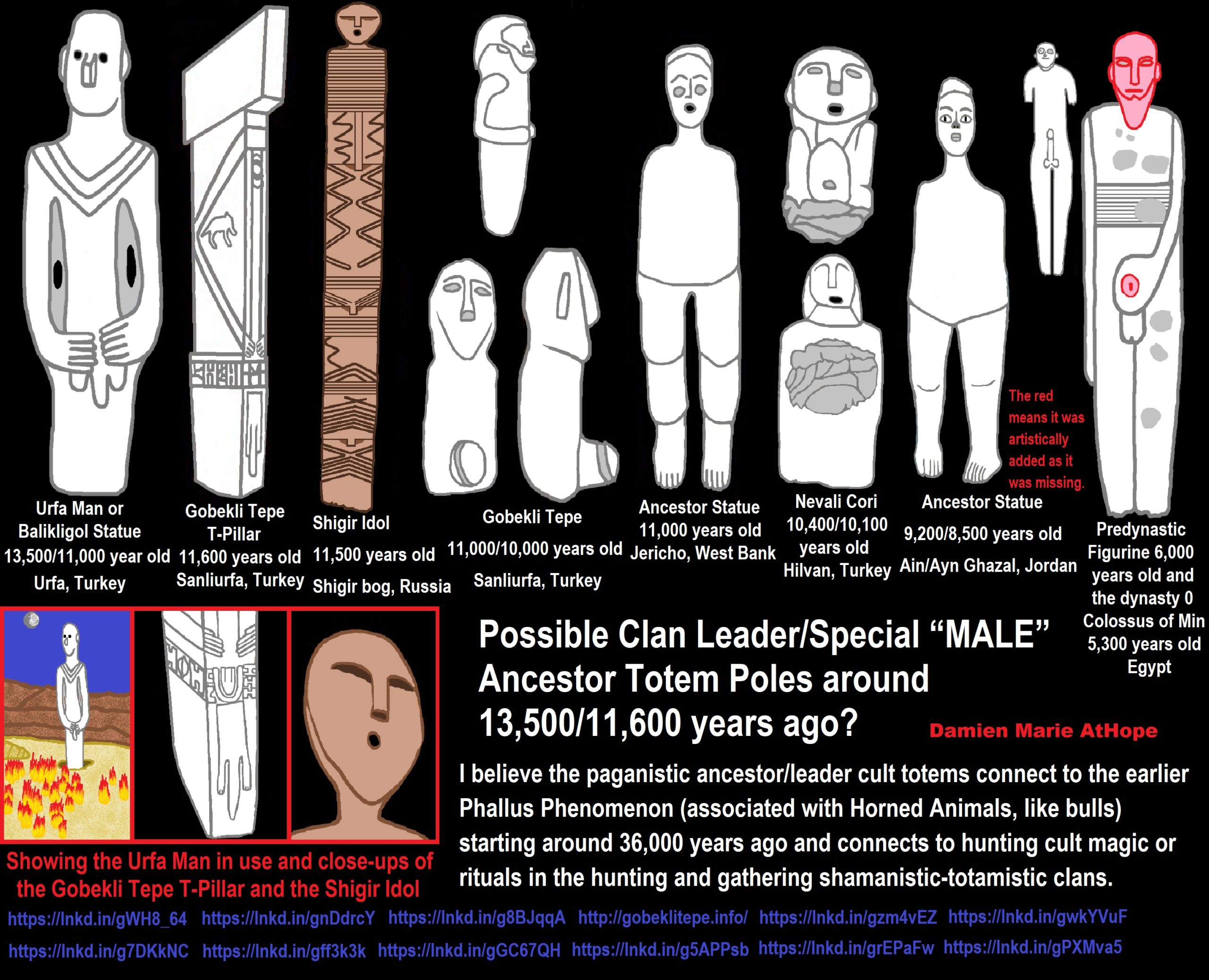
ref, ref, ref, ref, ref, ref, ref, ref, ref, ref, ref, ref, ref
I believe the paganistic ancestor/leader cult totems connect to the earlier Phallus Phenomenon (associated with Horned Animals, like bulls) starting around 36,000 years ago and connects to hunting cult magic or rituals in the hunting and gathering shamanistic-totamistic clans.
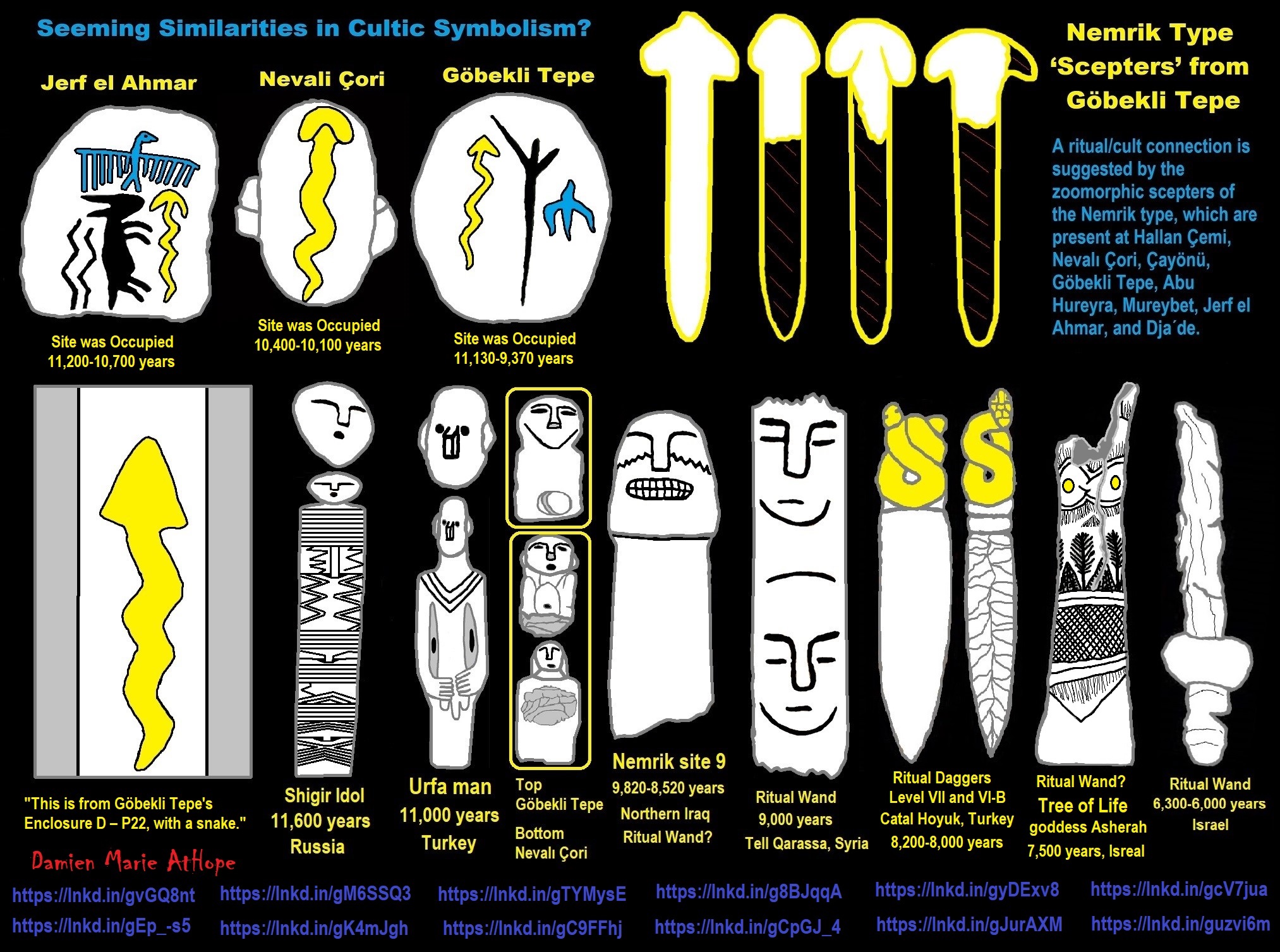
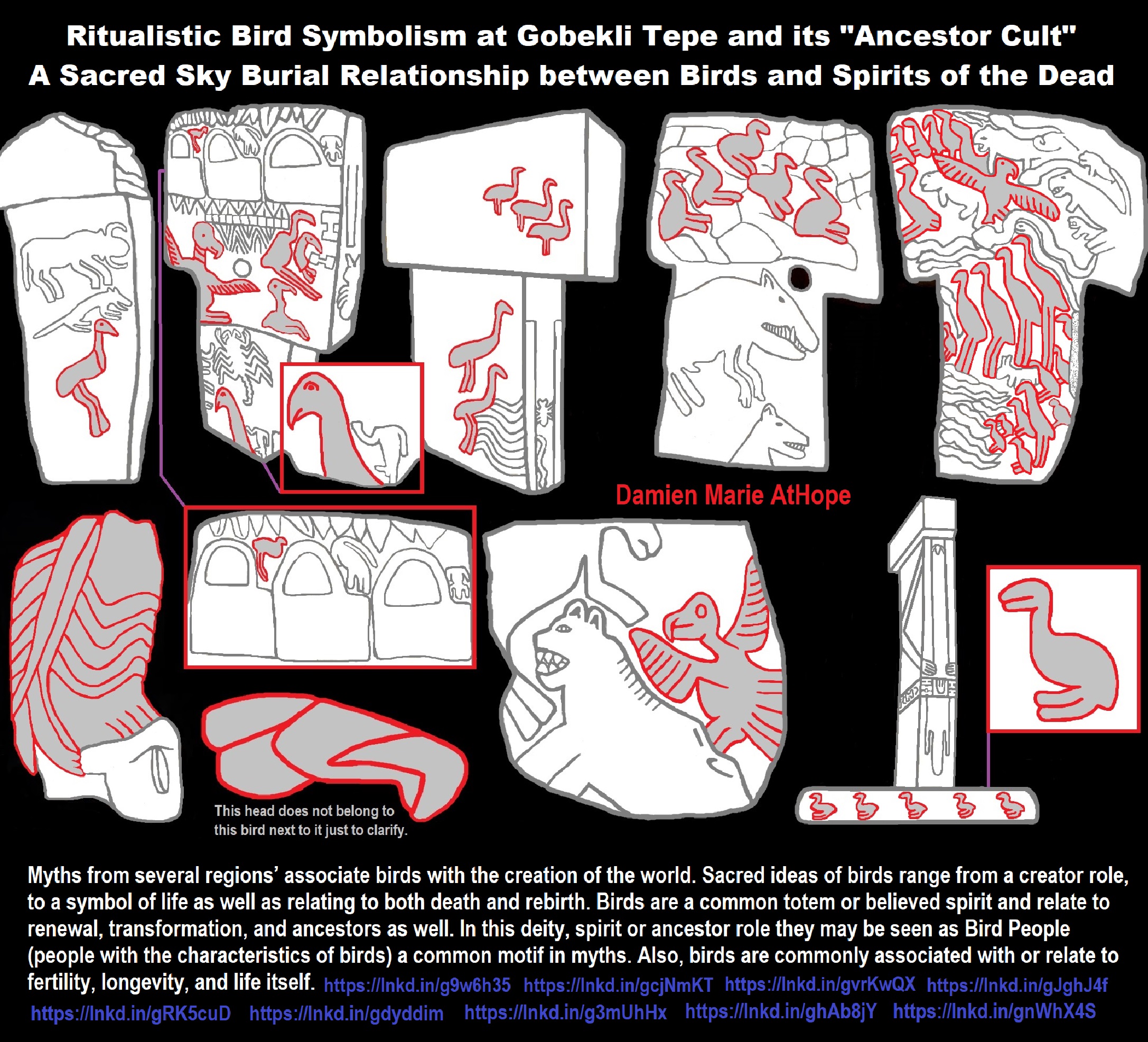
ref, ref, ref, ref, ref, ref, ref, ref, ref, ref, ref, ref, ref, ref, ref, ref, ref
Gobekli Tepe: “first human made temple” around 12,000 years ago
Ritualistic Bird Symbolism at Gobekli Tepe and its “Ancestor Cult” a Sacred Sky Burial Relationship between Birds and Spirits of the Dead
Myths from several regions’ associate birds with the creation of the world. Sacred ideas of birds range from a creator role, to a symbol of life as well as relating to both death and rebirth. Birds are a common totem or believed spirit and relate to renewal, transformation, and ancestors as well. In this deity, spirit or ancestor role they may be seen as Bird People (people with the characteristics of birds) a common motif in myths. Also, birds are commonly associated with or relate to fertility, longevity, and life itself.

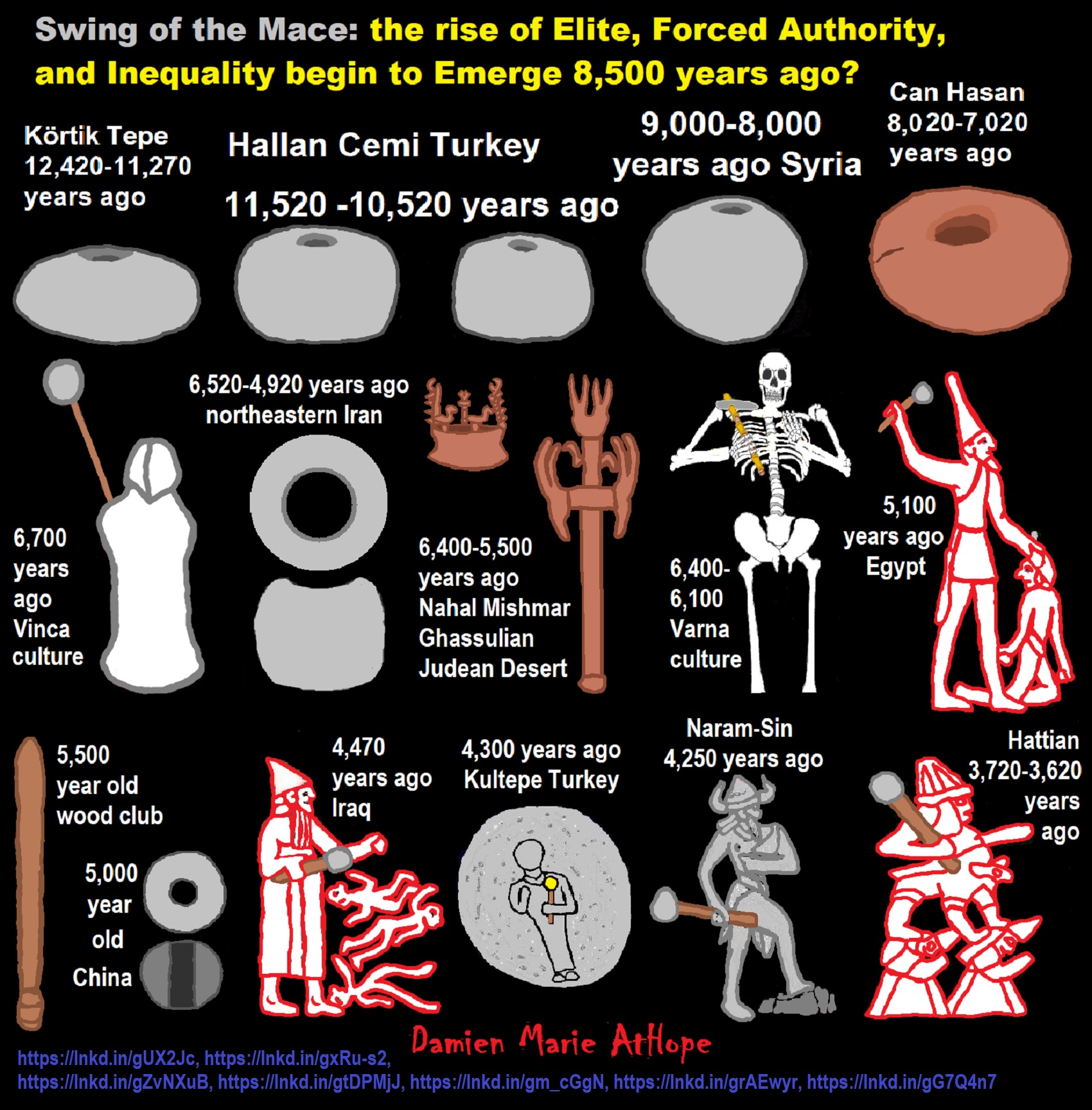
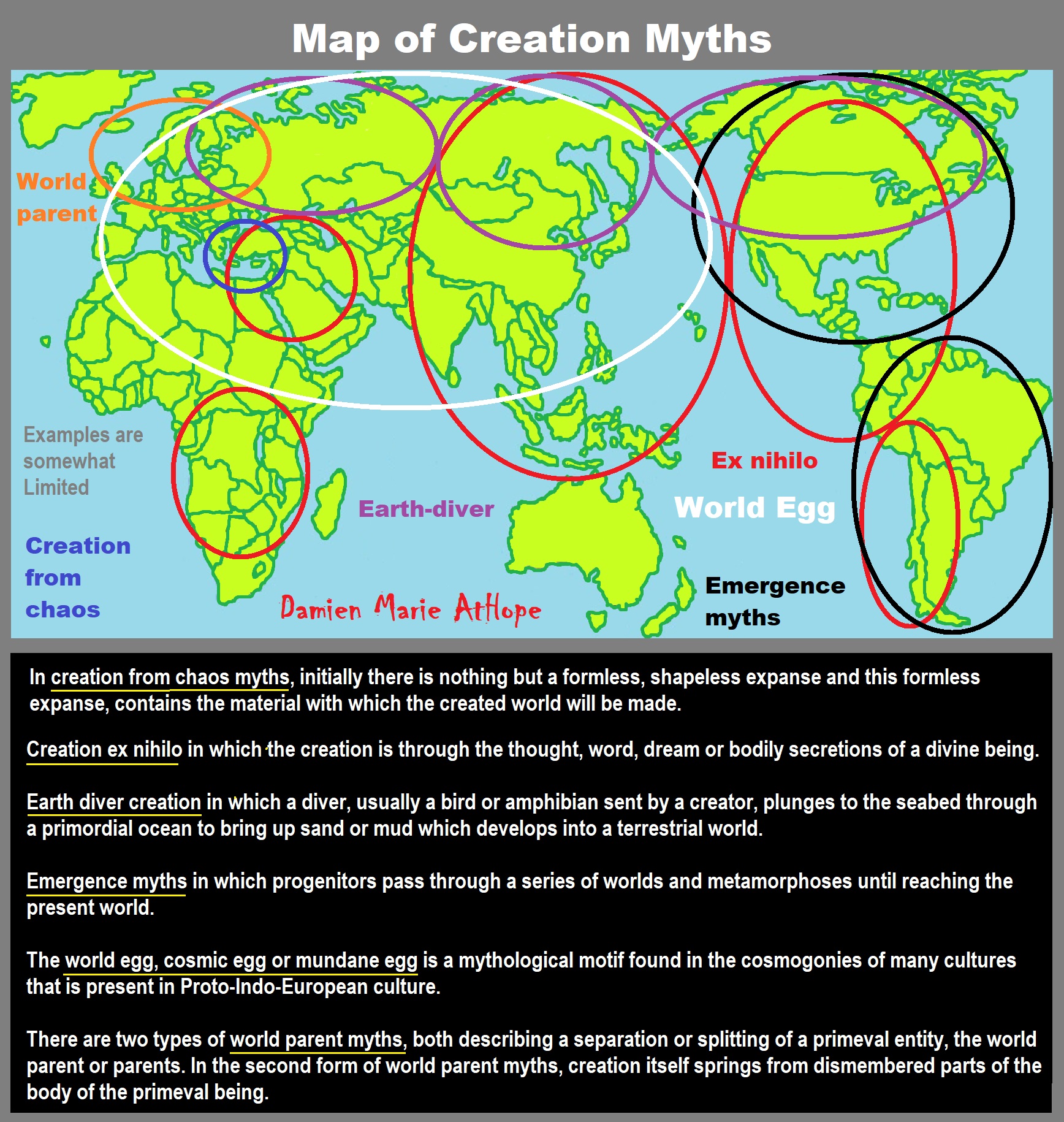
- Rape, Sexism and Religion?
- Sexism in the BIBLE: chapter and verse!
- New Testament: bigotry, cruelty, sexism, slavery, racism, etc.
- Sexism in Taoism
- Yin and Yang is sexist with an ORIGIN around 2,300 years ago?
- Sexism in Protestantism
- Sexism in Catholicism
- Sexism in Bahaism
- Sexism in Sikhism
- Sexism in Confucianism
- Sexism in Jainism
- Sexism in Shintoism
- Sexism in Buddhism
- Sexist Buddha
- Sexism in Islam
- Sexism in Hinduism
- Sexism in Mormonism
- Sexism in Jehovah Witness
- Sexism in Christianity (New Testament)
- Sexism in Judaism (old Testament)
- Sexism, Prejudice, and Killing in Vedic Culture (Hinduism)
- Sexism in Islam? Face Covering: Religious Freedom or Religious Oppression
- Speech on the Evolution of Religion & Religious Sexism
- Sexism in the Major World Religions
- All Religions are Sexist/Sexism

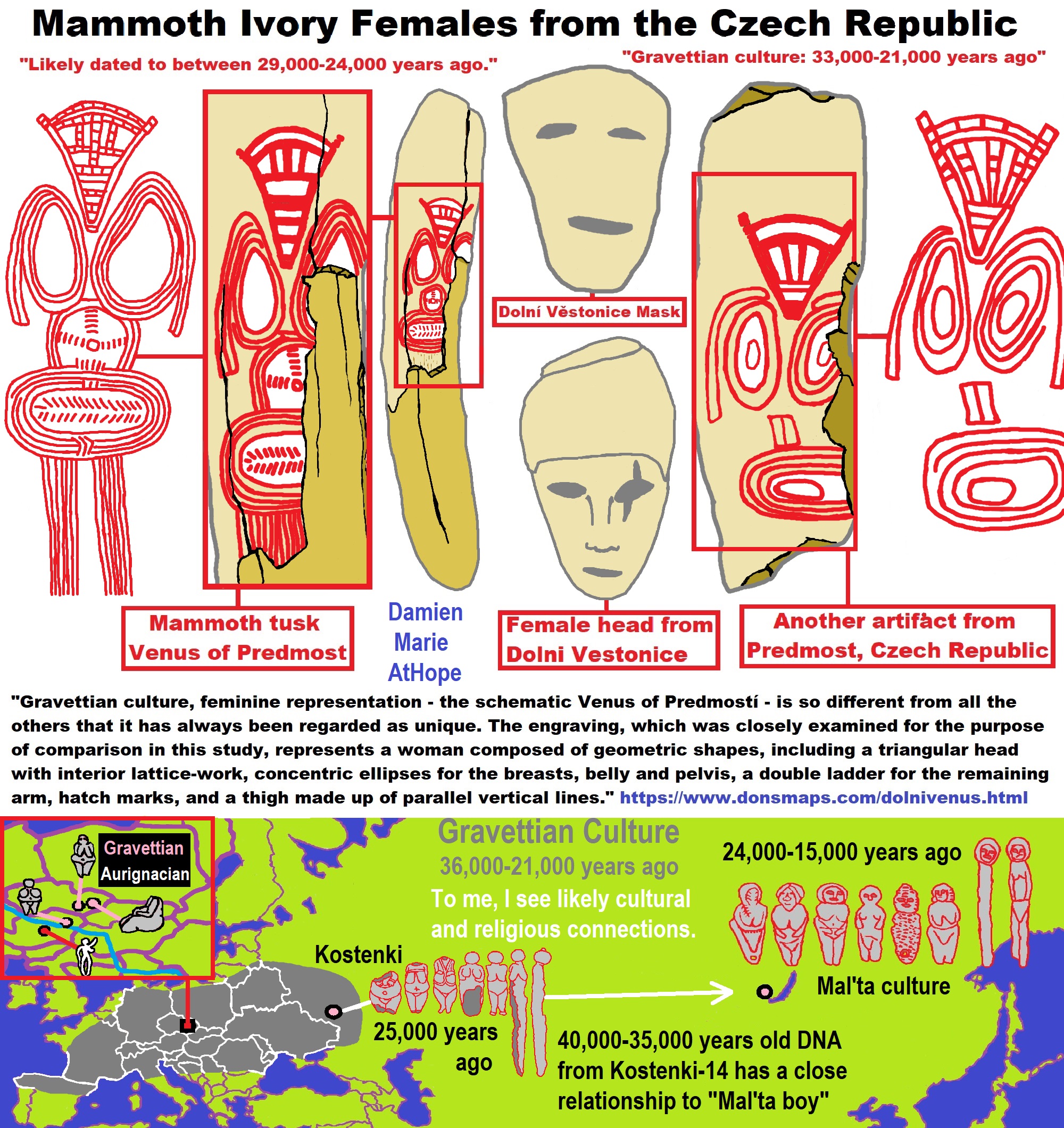
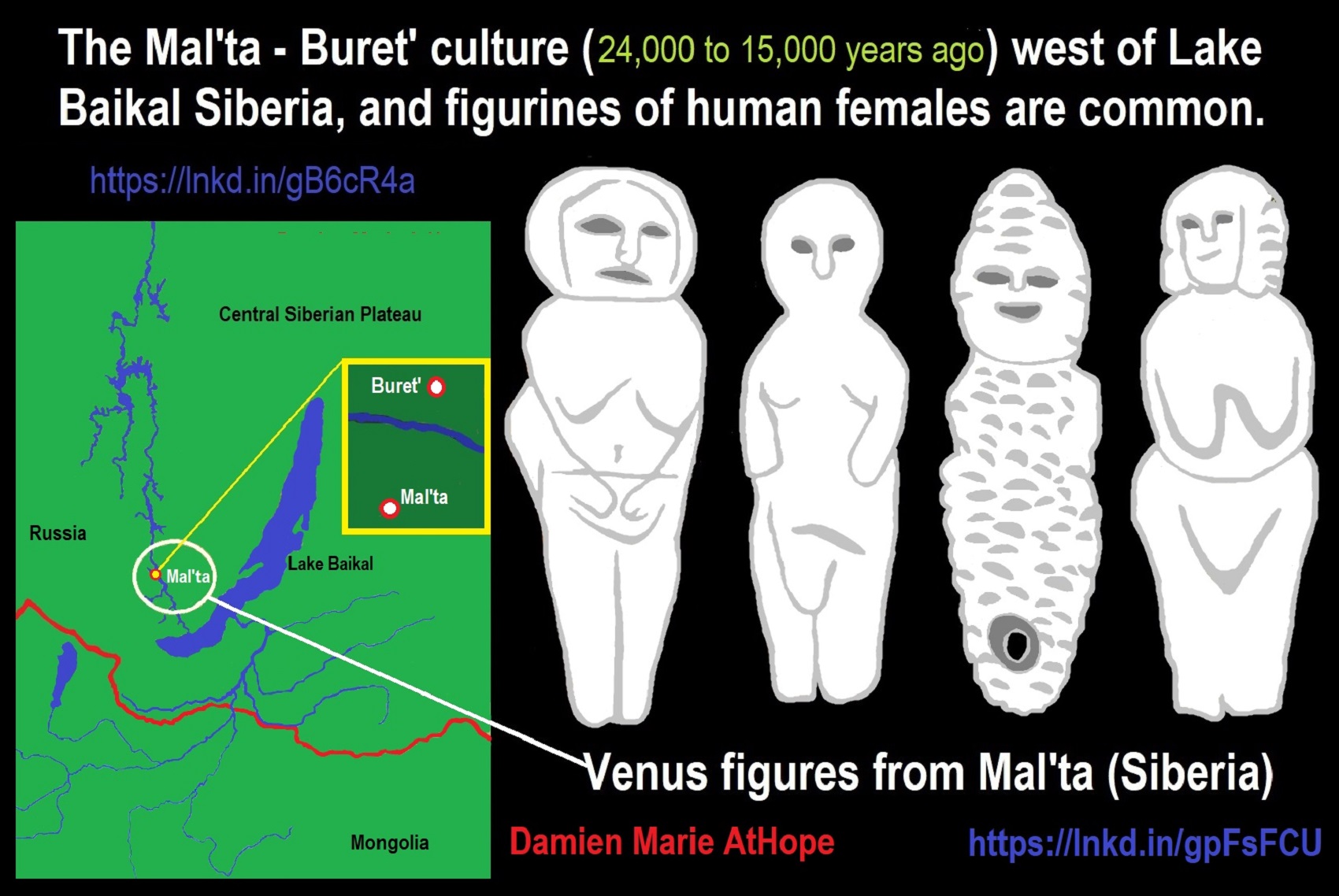
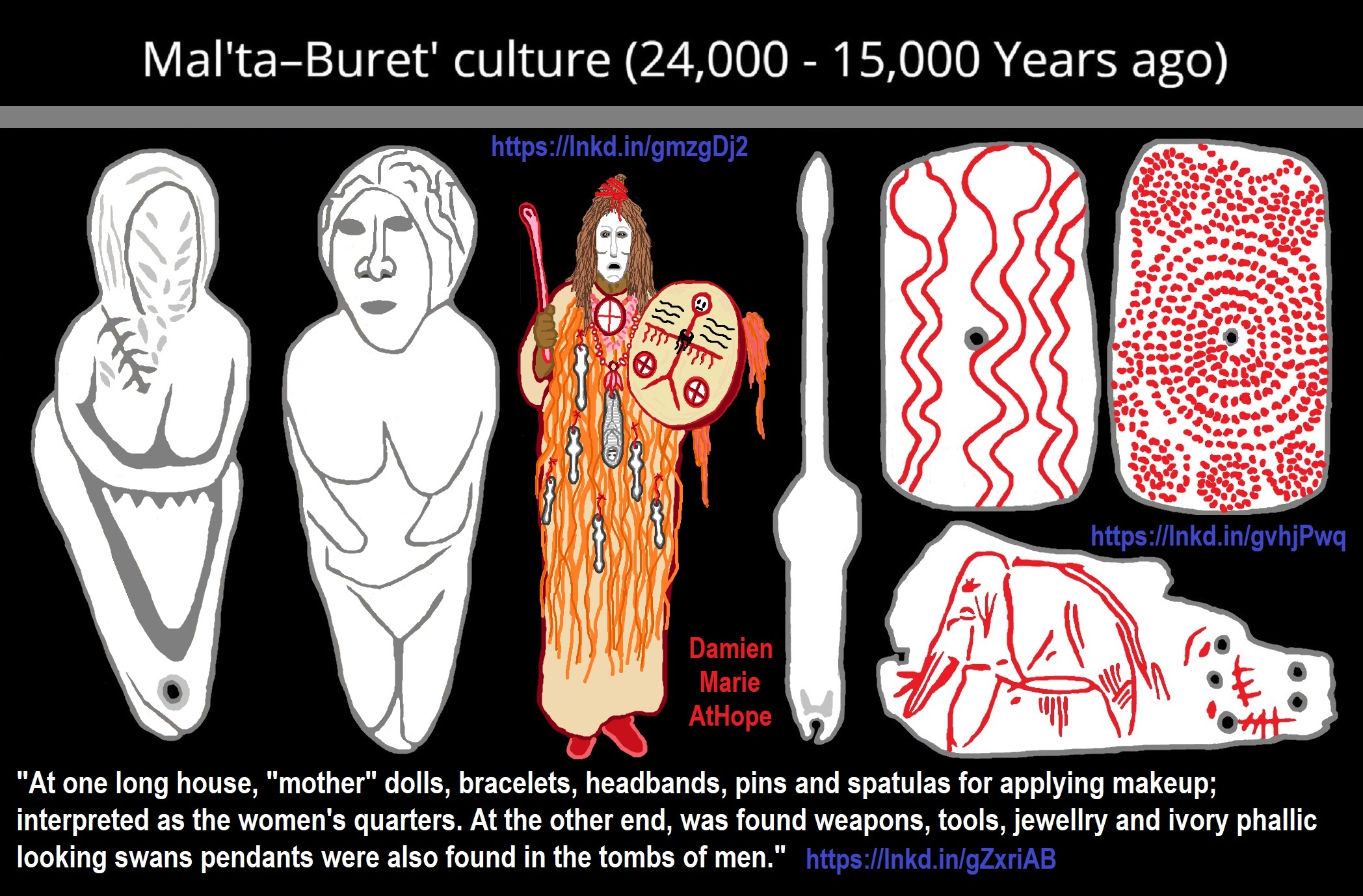
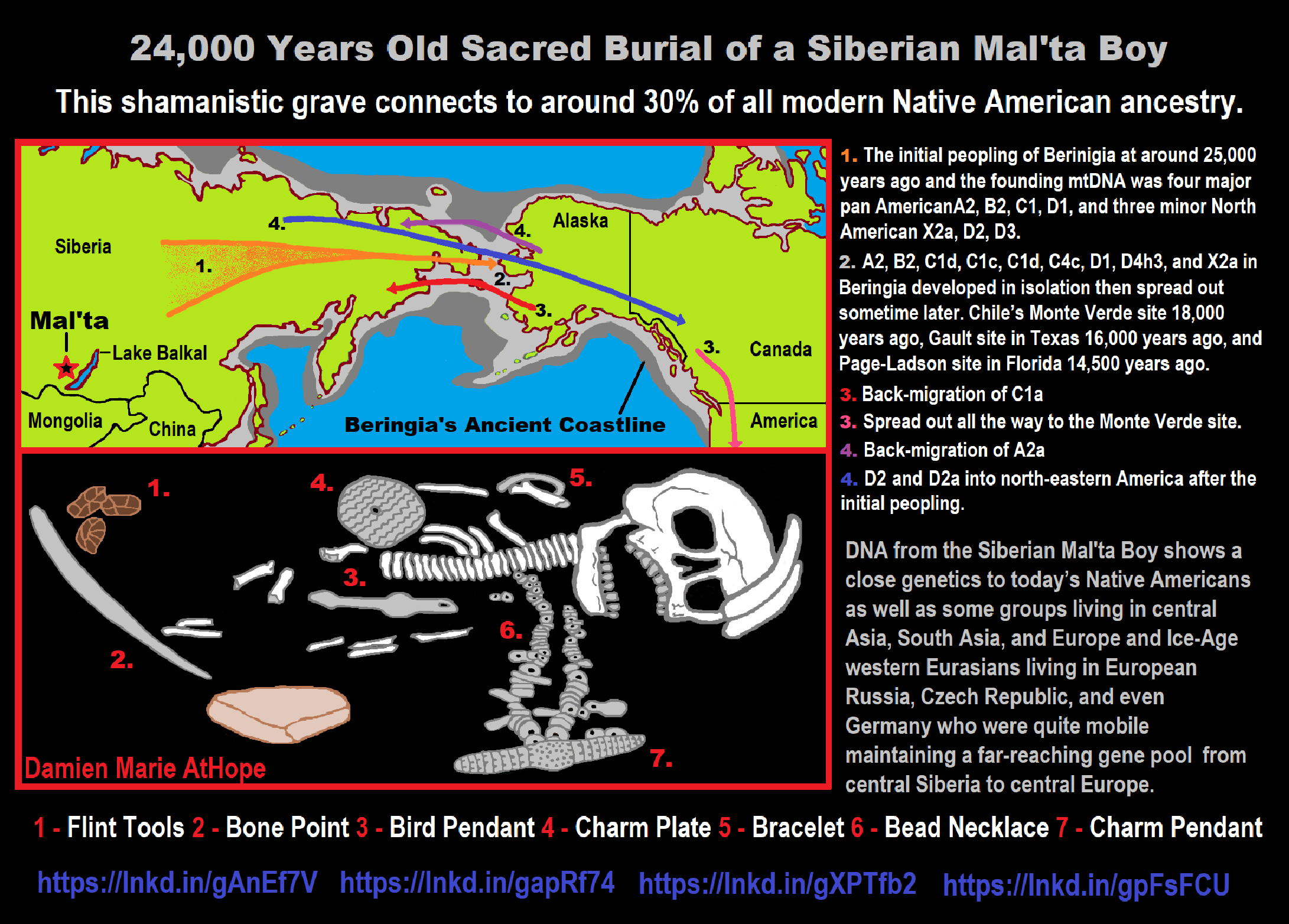



ref
Haplogroup R possible time of origin about 27,000 years in Central Asia, South Asia, or Siberia:
- Mal’ta–Buret’ culture (24,000-15,000 years ago)
- Afontova Gora culture (21,000-12,000 years ago)
- Trialetian culture (16,000–8000 years ago)
- Samara culture (7,000-6,500 years ago)
- Khvalynsk culture (7,000-6,500 years ago)
- Afanasievo culture (5,300-4,500 years ago)
- Yamna/Yamnaya Culture (5,300-4,500 years ago)
- Andronovo culture (4,000–2,900 years ago) ref
Trialetian sites
Caucasus and Transcaucasia:
- Edzani (Georgia)
- Chokh (Azerbaijan), layers E-C200
- Kotias Klde, layer B” ref
Eastern Anatolia:
- Hallan Çemi (from ca. 8.6-8.5k BC to 7.6-7.5k BCE)
- Nevali Çori shows some Trialetian admixture in a PPNB context” ref
Trialetian influences can also be found in:
- Cafer Höyük
- Boy Tepe” ref
Southeast of the Caspian Sea:
- Hotu (Iran)
- Ali Tepe (Iran) (from cal. 10,500 to 8,870 BCE)
- Belt Cave (Iran), layers 28-11 (the last remains date from ca. 6,000 BCE)
- Dam-Dam-Cheshme II (Turkmenistan), layers7,000-3,000 BCE)” ref
“The belonging of these Caspian Mesolithic sites to the Trialetian has been questioned. Little is known about the end of the Trialetian. 6k BC has been proposed as the time on which the decline phase took place. From this date are the first evidence of the Jeitunian, an industry that has probably evolved from the Trialetian. Also from this date are the first pieces of evidence of Neolithic materials in the Belt cave.” ref
“In the southwest corner of the Trialetian region it has been proposed that this culture evolved towards a local version of the PPNB around 7,000 BCE, in sites as Cafer Höyük. Kozłowski suggests that the Trialetian does not seem to have continuation in the Neolithic of Georgia (as for example in Paluri and Kobuleti). Although in the 5,000 BCE certain microliths similar to those of the Trialetian reappear in Shulaveris Gora (see Shulaveri-Shomu) and Irmis Gora.” ref
“The genome of a Mesolithic hunter-gatherer individual found at the layer A2 of the Kotias Klde rock shelter in Georgia (labeled KK1), dating from 9,700 years ago, has been analyzed. This individual forms a genetic cluster with another hunter-gatherer from the Satsurblia Cave, the so-called Caucasian Hunter-Gatherer (CHG) cluster. KK1 belongs to the Y-chromosome haplogruoup J2a (an independent analysis has assigned him J2a1b-Y12379*).” ref
“Although the belonging of the Caspian Mesolithic to the Trialetian has been questioned, it is worth noting that genetic similarities have been found between an Mesolithic hunther-gatherer from the Hotu cave (labeled Iran_HotuIIIb) dating from 9,100-8,600 BCE and the CHG from Kotias Klde. The Iran_HotuIIIb individual belongs to the Y-chromosome haplogroup J (xJ2a1b3, J2b2a1a1) (an independent analysis yields J2a-CTS1085(xCTS11251,PF5073) -probably J2a2-). Then, both KK1 and Iran_HotuIIIb individuals share a paternal ancestor that lived approximately 18.7k years ago (according to the estimates of full). At the autosomal level, it falls in the cluster of the CHG’s and the Iranian Neolithic Farmers.” ref
“Göbekli Tepe (“Potbelly Hill”) is a Neolithic archaeological site near the city of Şanlıurfa in Southeastern Anatolia, Turkey. Dated to the Pre-Pottery Neolithic, between c. 9500 and 8000 BCE, the site comprises a number of large circular structures supported by massive stone pillars – the world’s oldest known megaliths. Many of these pillars are richly decorated with abstract anthropomorphic details, clothing, and reliefs of wild animals, providing archaeologists rare insights into prehistoric religion and the particular iconography of the period..” ref

10,800-10,000 years old “Göbekli Tepe, engraving of a female person from layer II.” ref
“The Gravettian was an archaeological industry of the European Upper Paleolithic that succeeded the Aurignacian circa around 36/33,022 years ago, It is archaeologically the last European culture many consider unified, and had mostly disappeared by c. 22,022 years ago, close to the Last Glacial Maximum, although some elements lasted until c. 17,022 years ago. At this point, it was replaced abruptly by the Solutrean in France and Spain, and developed into or continued as the Epigravettian in Italy, the Balkans, Ukraine, and Russia. The Gravettian culture is known for Venus figurines, which were typically carved from either ivory or limestone. The culture was first identified at the site of La Gravette in the southwestern French department of Dordogne.” ref
“Surviving Gravettian art includes numerous cave paintings and small, portable Venus figurines made from clay or ivory, as well as jewelry objects. The fertility deities mostly date from the early period; there are over 100 known surviving examples. They conform to a very specific physical type, with large breasts, broad hips, and prominent posteriors. The statuettes tend to lack facial details, and their limbs are often broken off.” ref
“In a genetic study published in Nature in May 2016, the remains of fourteen Gravettians were examined. The eight samples of Y-DNA analyzed were determined to be three samples of haplogroup CT, one sample of I, one sample of IJK, one sample of BT, one sample of C1a2, one sample of F. Of the fourteen samples of mtDNA, there were thirteen samples of U and one sample of M. The majority of the sample of U belonged to the U5 and U2. In a genetic study published in Nature in November 2020, the remains of one adult male and two twin boys from a Gravettian site were examined. The Y-DNA analysis revealed that all 3 individuals belonged to haplogroup I. The 3 individuals had the same mtDNA, U5.” ref
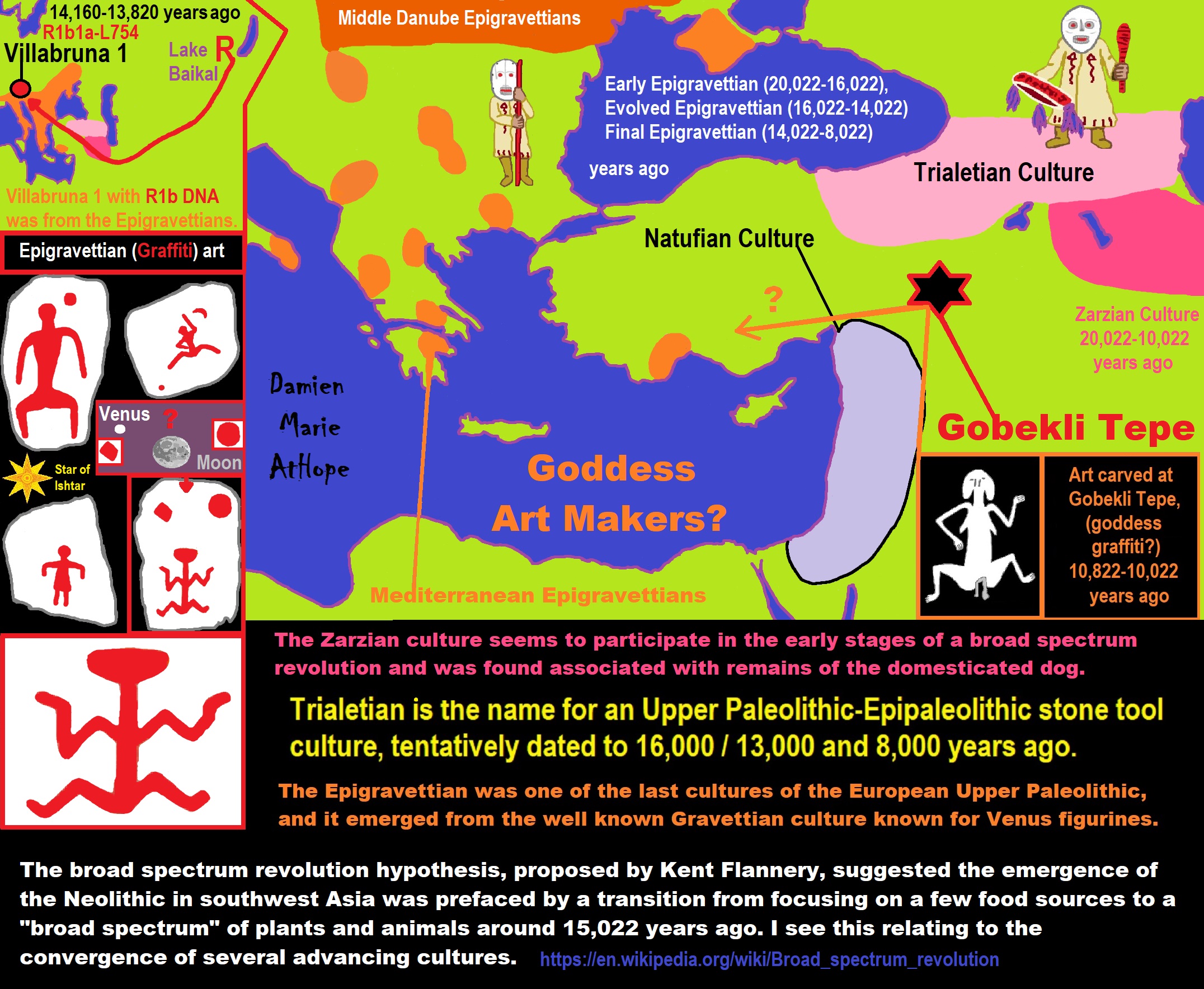
ref, ref, ref, ref, ref, ref, ref, ref, ref, ref, ref, ref, ref, ref, ref
The Ochre Painted Stones from the Riparo Dalmeri (Trento). Development of the Research on the Art and Rituality of the Epigravettian Site https://www.researchgate.net/publication/285689545_The_Ochre_Painted_Stones_from_the_Riparo_Dalmeri_Trento_Development_of_the_Research_on_the_Art_and_Rituality_of_the_Epigravettian_Site
Are the Natufians of Israel around 15,000 to 11,500 years ago who you thought they were?

ref, ref, ref, ref, ref, ref, ref, ref, ref, ref, ref, ref, ref, ref, ref
1. Kebaran culture 23,022-16,522 Years Ago, 2. Kortik Tepe 12,422-11,722 Years Ago, 3. Jerf el-Ahmar 11,222 -10,722 Years Ago, 4. Gobekli Tepe 11,152-9,392 Years Ago, 5. Tell Al-‘abr Syria, 6. Nevali Cori 10,422 -10,122 Years Ago, 7. Catal Hoyuk 9,522-7,722 Years Ago
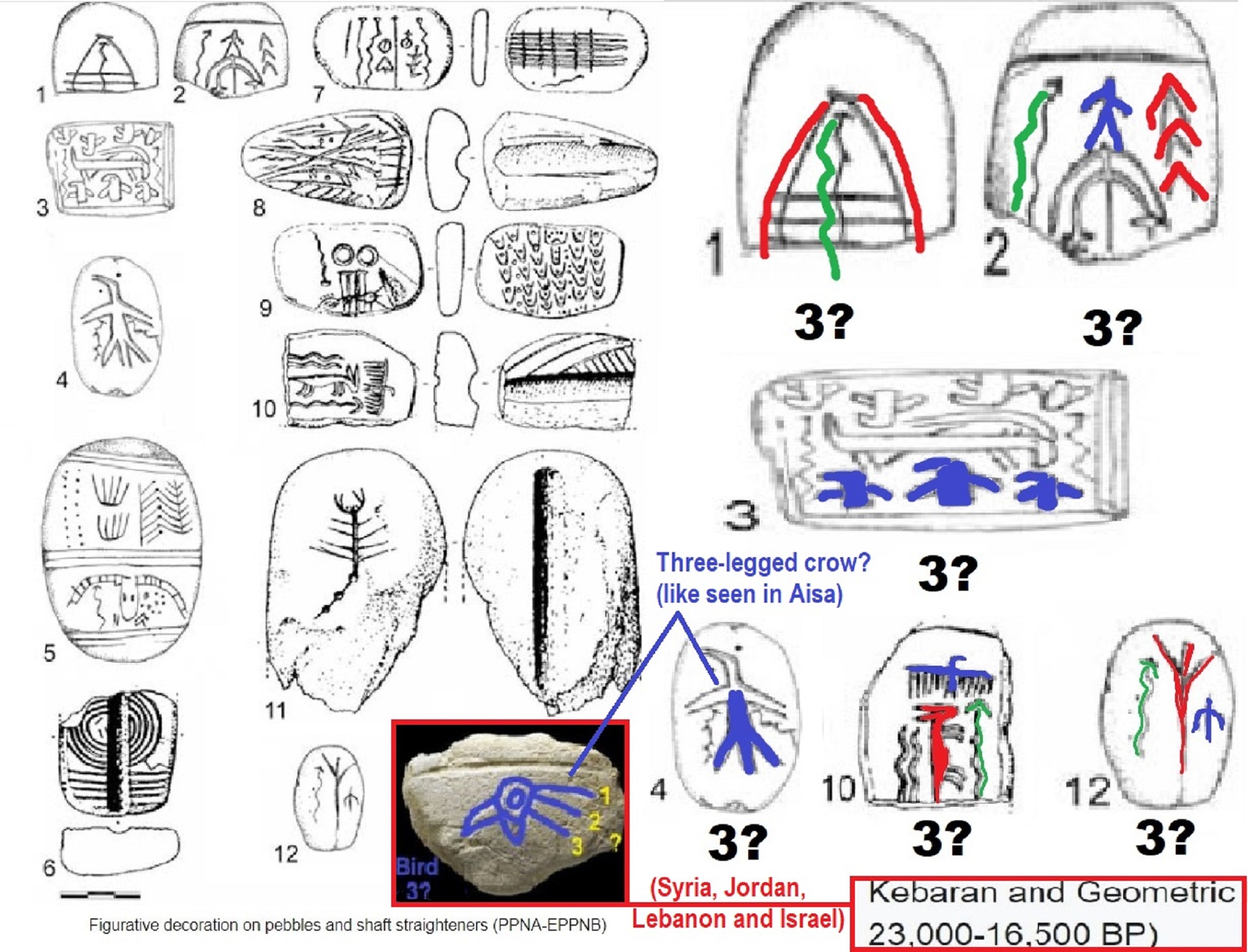
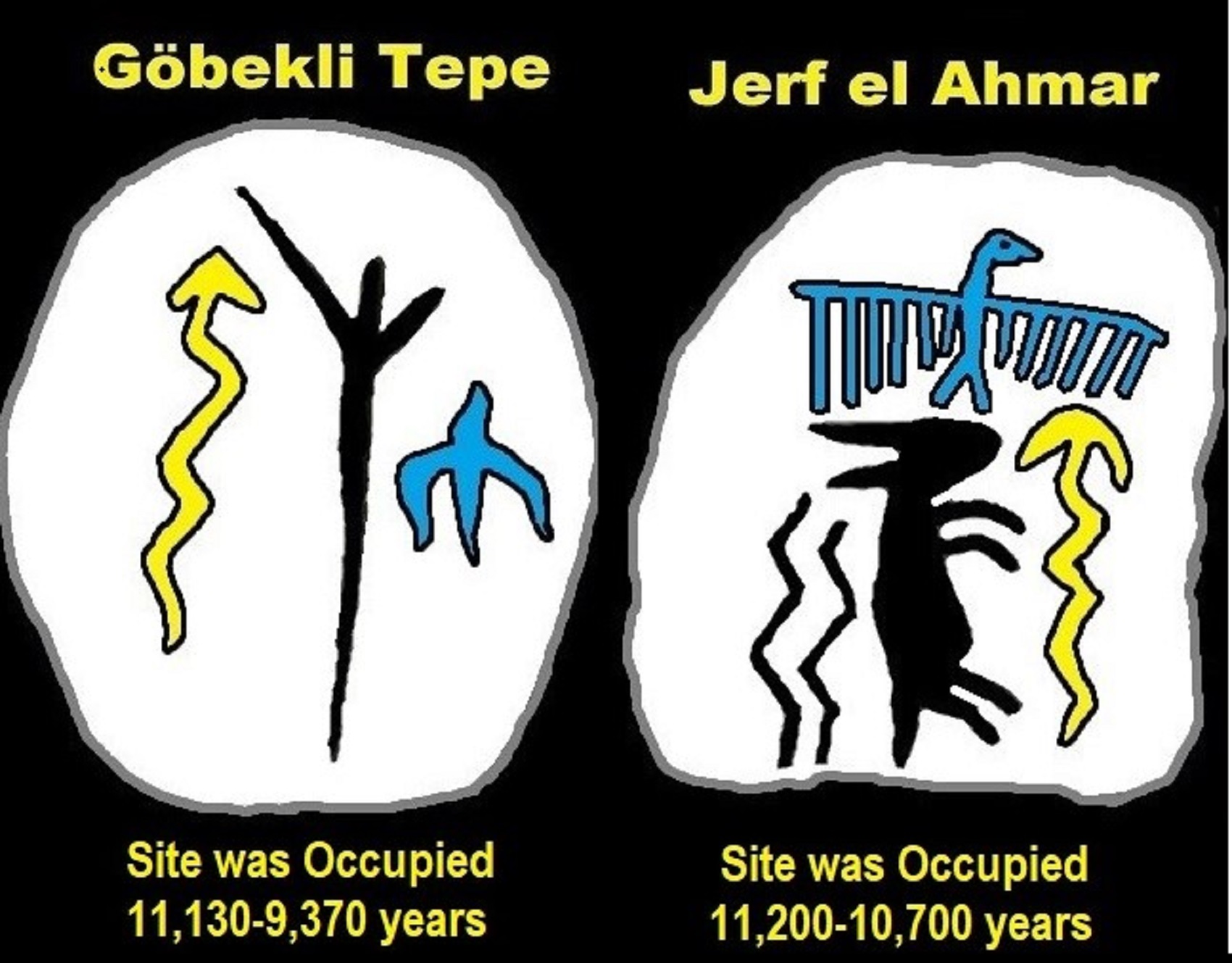
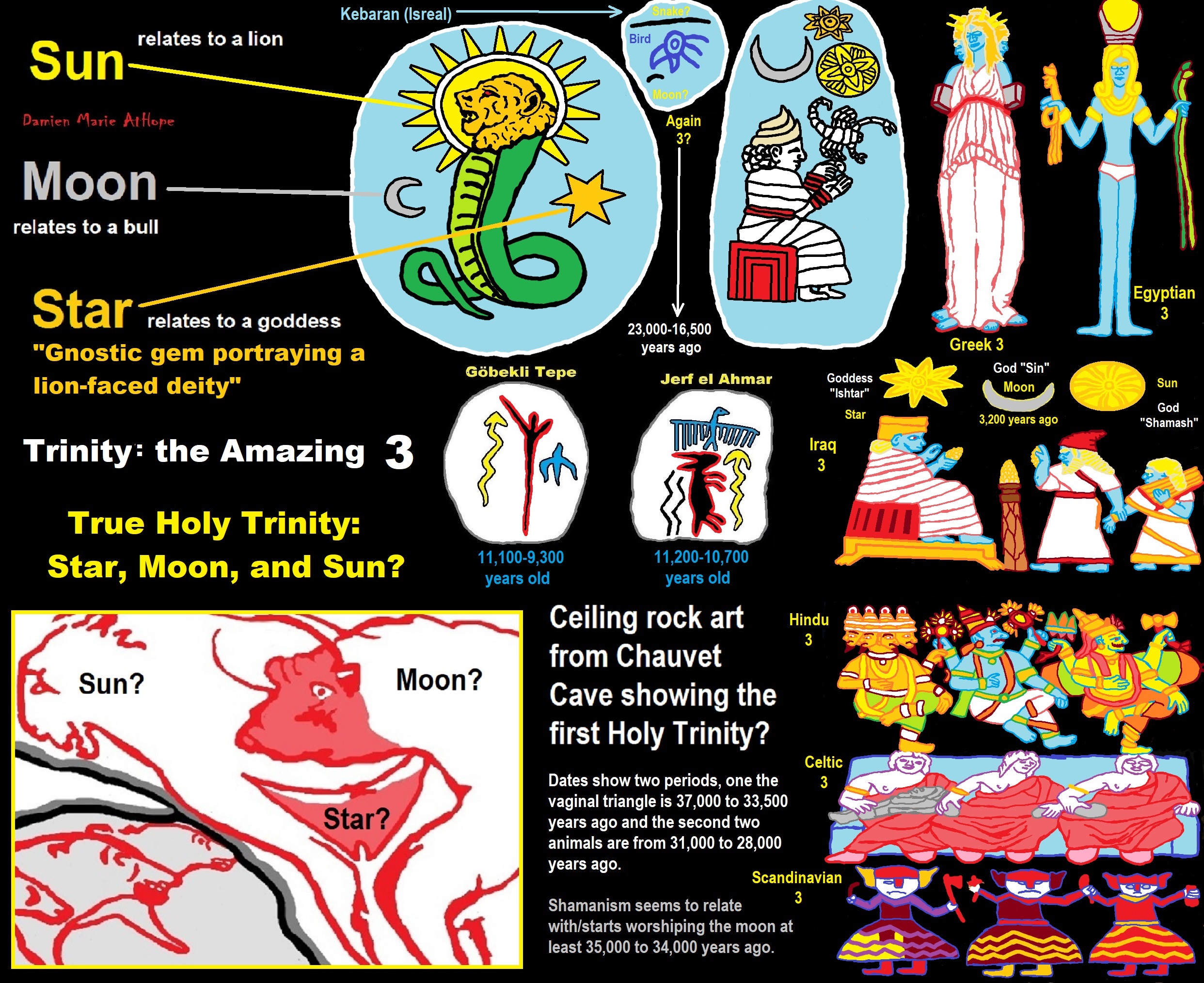
ref, ref, ref, ref, ref, ref, ref, ref, ref, ref, ref, ref, ref
Triad (religion)
“A triad, in a religious context, refers to a grouping of three gods, usually by importance or similar roles. A triad of gods were usually not considered to be one in the same being, or different aspects of a single deity as in a Trinity or Triple deity. Triads of three closely associated deities were commonly found throughout the ancient world, and in particular in the religious traditions of Ancient Greece and Egypt.” ref
Triad in Dharmic religions
- Amitabha Triad – Amitābha, Avalokiteśvara and Mahāsthāmaprāpta in Mahayana Buddhism
- Ayyavazhi Trinity
- Brahma, Vishnu, and Shiva (Trimurti) in Puranic Hinduism
- Lord Dattatreya
- Mitra, Aryaman, and Varuna in early vedic Hinduism
- Ganga, Yamuna, and Saraswati merged in one is the Triveni
- Sahā Triad – Shakyamuni, Avalokitesvara, and Ksitigarbha in Mahayana Buddhism
- Shakti, Lakshmi, and Saraswati (Tridevi) in Puranic Hinduism.” ref
Other Eastern religions
- Three Pure Ones in Taoism
- Fu Lu Shou in Taoism
- San-shan kuo-wang, Lords of the Three Mountains in Chinese folk religion
- The Ahuric Triad of Ahura Mazda, Mithra, and Apam Napat in Zoroastrianism. Also, in Achaemenid times, Mazda, Mithra, and Anahita.” ref
Historical polytheism
- The Classical Greek Olympic triad of Zeus (king of the gods), Athena (goddess of war and intellect), and Apollo (god of the sun, culture, and music)
- The Delian chief triad of Leto (mother), Artemis (daughter), and Apollo (son) and second Delian triad of Athena, Zeus, and Hera
- The Eleusinian Mysteries centered on Persephone (daughter), Demeter (mother), and Triptolemus (to whom Demeter taught agriculture)
- In ancient Egypt, there were many triads: the Osirian (or Abydos) triad of Osiris (husband), Isis (wife), and Horus (son),
the Theban triad of Amun, Mut, and Khonsu
the Memphite triad of Ptah, Sekhmet and Nefertem
the Elephantine triad of Khnum (god of the source of the Nile river), Satet (the personification of the floods of the Nile river), and Anuket (the Goddess of the Nile river).
the sun-god Ra, whose form in the morning was Khepri, at noon Re-Horakhty and in the evening Atum, and many others. - The Hellenistic Egypt triad of Isis, Alexandrian Serapis, and Harpocrates (a Hellenized version of the already referred Isis-Osiris-Horus triad), though in the early Ptolemaic period Serapis, Isis, and Apollo (who was sometimes identified with Horus) were preferred.
- The Roman Capitoline Triad of Jupiter (father), Juno (wife), and Minerva (daughter)
- The Roman pleibian triad of Ceres, Liber Pater, and Libera (or its Greek counterpart with Demeter, Dionysos, and Kore)
- The Julian triads of the early Roman Principate:Venus Genetrix, Divus Iulius, and Clementia Caesaris
Divus Iulius, Divi filius and Genius Augusti
Eastern variants of the Julian triad, e.g. in Asia Minor: Dea Roma, Divus Iulius, and Genius Augusti (or Divi filius) - The Matres (Deae Matres/Dea Matrona) in Roman mythology
- The Fates, Moirai, or Furies in Greek and Roman mythology: Clotho or Nona the Spinner, Lachesis or Decima the Weaver, and Atropos or Morta the Cutter of the Threads of Life. One’s Lifeline was Spun by Clotho, Woven into the tapestry of Life by Lachesis, and the thread Cut by Atropos.
- The Hooded Spirits or Genii Cucullati in Gallo-Roman times
- The main supranational triad of the ancient Lusitanian mythology and religion and Portuguese Neopagans made up of the couple Arentia and Arentius and Quangeius and Trebaruna, followed by a minor Gallaecian–Lusitanian triad of Bandua (under many natures), Nabia and Reve female nature: Reva
- The sisters Uksáhkká, Juksáhkká and Sáhráhkká in Sámi mythology.
- The triad of Al-Lat, Al-Uzza, and Manat in the time of Mohammed (Holy Qu’ran (Abdullah Yusuf Ali translation), Surah 53:19-22)
- Lugus (Esus, Toutatis, and Taranis) in Celtic mythology
- Odin, Vili, and Ve in Norse mythology
- The Norns in Norse mythology
- Odin, Freyr, and Thor in Norse mythology. Odin is the god of wisdom and knowledge, Freyr is the god of fertility and prosperity, and Thor is the god of thunder and strength.
- The Triglav in Slavic mythology
- Perkūnas (god of heaven), Patrimpas (god of earth), and Pikuolis (god of death) in Prussian mythology
- The Zorya or Auroras in Slavic mythology
- The Charites or Graces in Greek mythology
- The One, the Thought (or Intellect) and the Soul in Neoplatonism
- Trinitarian Doctrines of God the Father, God the Son, and Holy Spirit in Christianity New Testament.” ref
Christian Trinity
“The Christian doctrine of the Trinity defines God as being one god existing in three coequal, coeternal, consubstantial persons: God the Father, God the Son (Jesus Christ), and God the Holy Spirit — three distinct persons sharing one essence. In this context, the three persons define who God is, while the one essence defines what God is. This doctrine is called Trinitarianism and its adherents are called trinitarians, while its opponents are called antitrinitarians or nontrinitarians. Nontrinitarian positions include Unitarianism, Binitarianism and Modalism.” ref
“The Christian doctrine of the Trinity (Latin: Trinitas, lit. ‘triad’, from Latin: trinus “threefold”) defines God as being one god existing in three coequal, coeternal, consubstantial prosopon (divine persons): God the Father, God the Son (Jesus Christ) and God the Holy Spirit, three distinct persons sharing one homoousion (essence). In this context, the three persons define who God is, while the one essence defines what God is.” ref
“This doctrine is called Trinitarianism and its adherents are called trinitarians, while its opponents are called antitrinitarians or nontrinitarians. Nontrinitarian positions include Unitarianism, Binitarianism and Modalism. While the developed doctrine of the Trinity is not explicit in the books that constitute the New Testament, the New Testament possesses a triadic understanding of God and contains a number of Trinitarian formulas. The doctrine of the Trinity was first formulated among the early Christians and fathers of the Church as early Christians attempted to understand the relationship between Jesus and God in their scriptural documents and prior traditions.” ref
Before the Council of Nicaea
“While the developed doctrine of the Trinity is not explicit in the books that constitute the New Testament, it was first formulated as early Christians attempted to understand the relationship between Jesus and God in their scriptural documents and prior traditions.” ref
“An early Trinitarian formula appears towards the end of the first century, where Clement of Rome rhetorically asks in his epistle as to why corruption exists among some in the Christian community; “Do we not have one God, and one Christ, and one gracious Spirit that has been poured out upon us, and one calling in Christ?” (1 Clement 46:6). Around the turn of the first century, the Didache directs Christians to “baptize in the name of the Father and of the Son and of the Holy Spirit”. Ignatius of Antioch provides early support for the Trinity around 110, exhorting obedience to “Christ, and to the Father, and to the Spirit.” ref
“The pseudonymous Ascension of Isaiah, written sometime between the end of the first century and the beginning of the third century, possesses a “proto-trinitarian” view, such as in its narrative of how the inhabitants of the sixth heaven sing praises to “the primal Father and his Beloved Christ, and the Holy Spirit.” ref
“Justin Martyr (CE 100–c. 165) also writes, “in the name of God, the Father and Lord of the universe, and of our Saviour Jesus Christ, and of the Holy Spirit”. At another point, Justin Martyr wrote that “we worship him [Jesus Christ] with reason, since we have learned that he is the Son of the living God himself, and believe him to be in second place and the prophetic Spirit in the third” (1 Apology 13, cf. ch. 60).” ref
“Justin Martyr is the first to use much of the terminology that would later become widespread in codified Trinitarian theology. For example, he describes that the Son and Father are the same “being” (ousia) and yet are also distinct faces (prosopa), anticipating the three persons (hypostases) that come with Tertullian and later authors. Justin describes how Jesus, the Son, is distinguishable from the Father but also derives from the Father, using the analogy of a fire (representing the Son) that is lit from its source, a torch (representing the Father).” ref
“In Trinitarian doctrine, God exists as three persons but is one being, having a single divine nature. The members of the Trinity are co-equal and co-eternal, one in essence, nature, power, action, and will. As stated in the Athanasian Creed, the Father is uncreated, the Son is uncreated, and the Holy Spirit is uncreated, and all three are eternal without beginning.” ref
“The Father and the Son and the Holy Spirit” are not names for different parts of God, but one name for God because three persons exist in God as one entity. They cannot be separate from one another. Each person is understood as having the identical essence or nature, not merely similar natures.” ref
“Nontrinitarianism (or antitrinitarianism) refers to Christian belief systems that reject the doctrine of the Trinity as found in the Nicene Creed as not having a scriptural origin. Nontrinitarian views differ widely on the nature of God, Jesus, and the Holy Spirit. Various nontrinitarian views, such as Adoptionism, Monarchianism, and Arianism existed prior to the formal definition of the Trinity doctrine in CE 325, 360, and 431, at the Councils of Nicaea, Constantinople, and Ephesus, respectively.” ref
“Following the adoption of trinitarianism at Constantinople in 381, Arianism was driven from the Empire, retaining a foothold amongst the Germanic tribes. When the Franks converted to Catholicism in 496, however, it gradually faded out. Nontrinitarianism was later renewed in the Gnosticism of the Cathars in the 11th through 13th centuries, in the Age of Enlightenment of the 18th century, and in some groups arising during the Second Great Awakening of the 19th century. See also binitarianism.” ref
Arianism was condemned as heretical by the First Council of Nicaea and, lastly, with Sabellianism by the Second Ecumenical Council (Constantinople, 381 CE). Adoptionism was declared as heretical by the Ecumenical Council of Frankfurt, convened by the Emperor Charlemagne in 794 for the Latin West Church.” ref
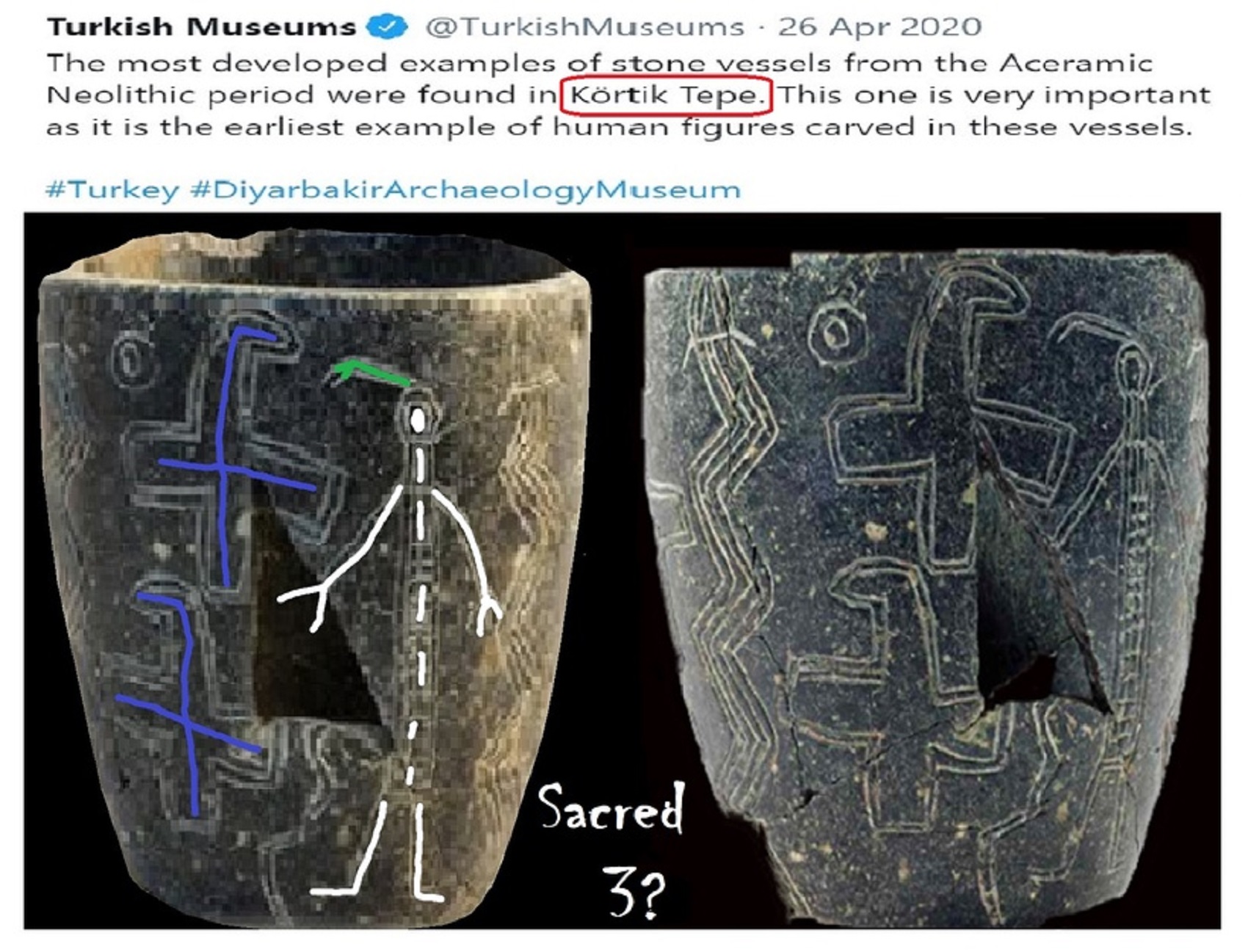
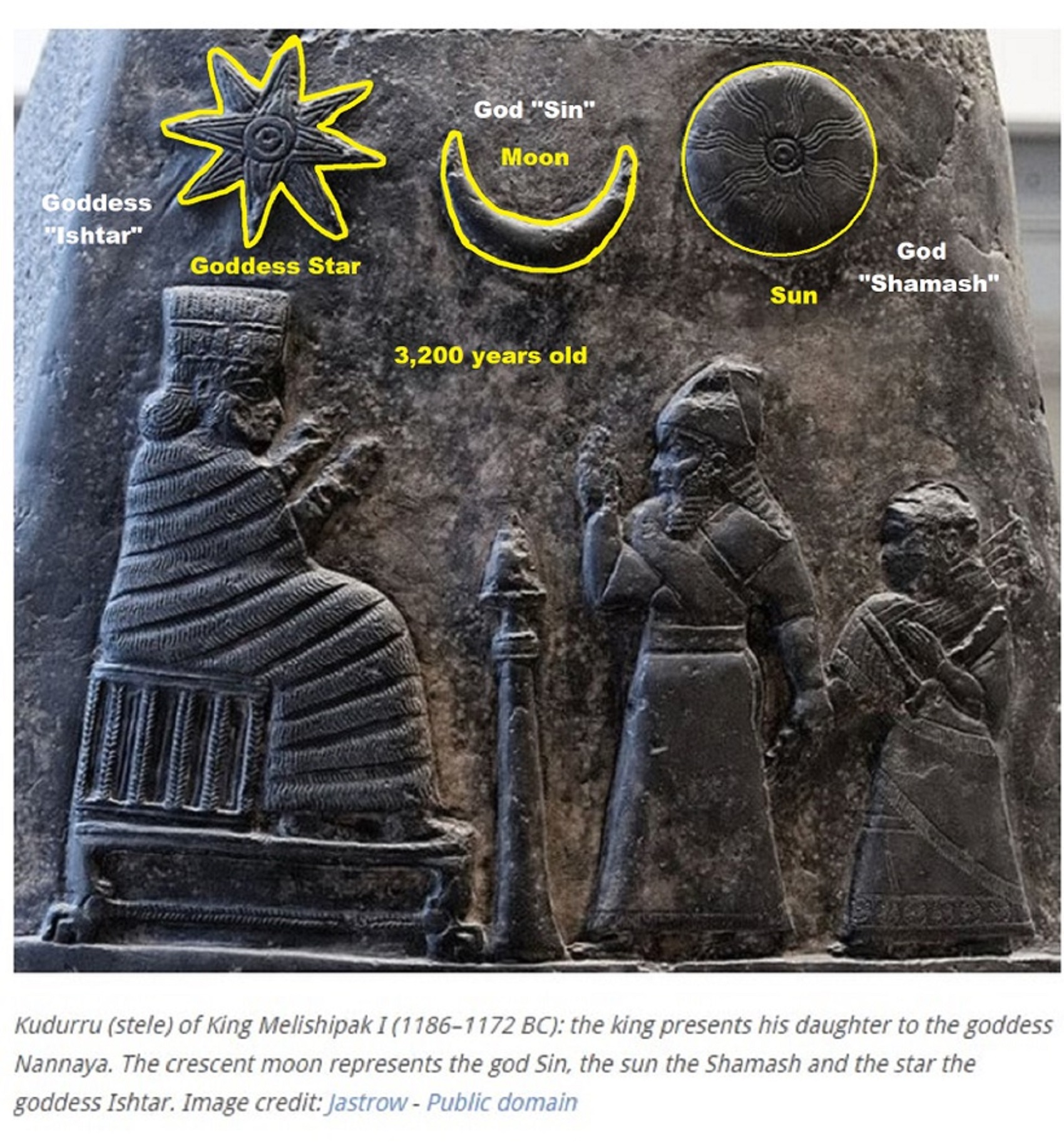

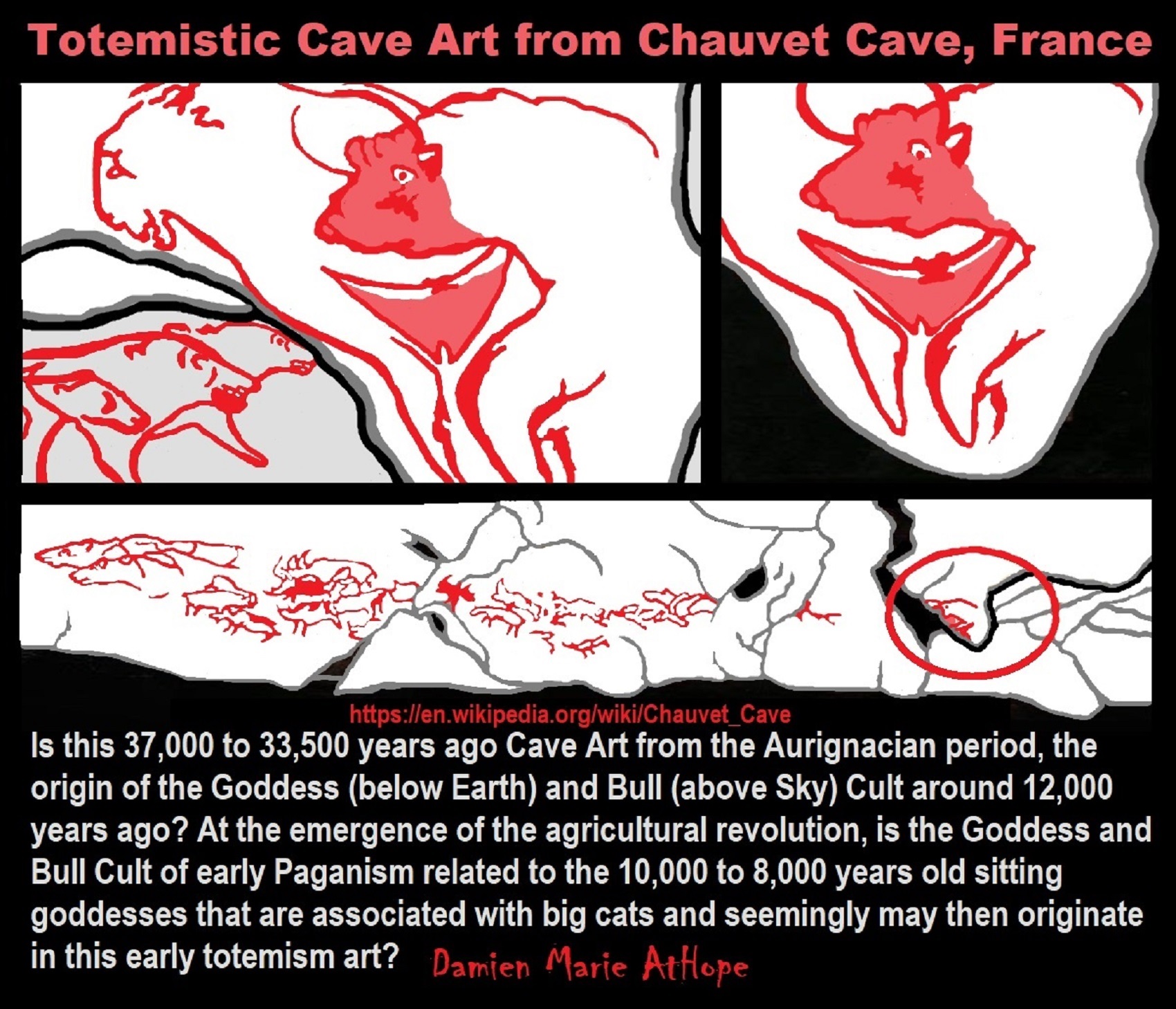


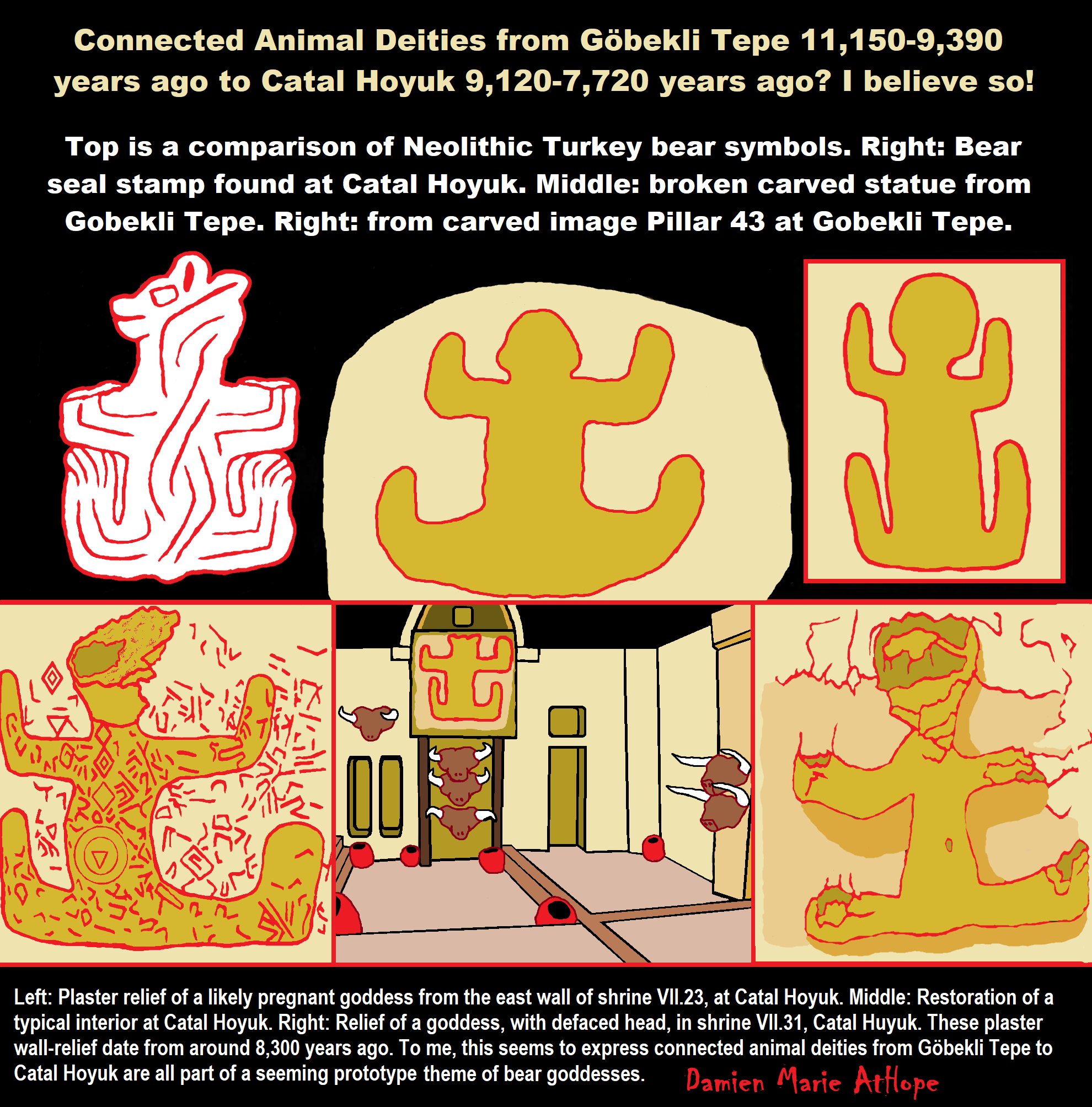
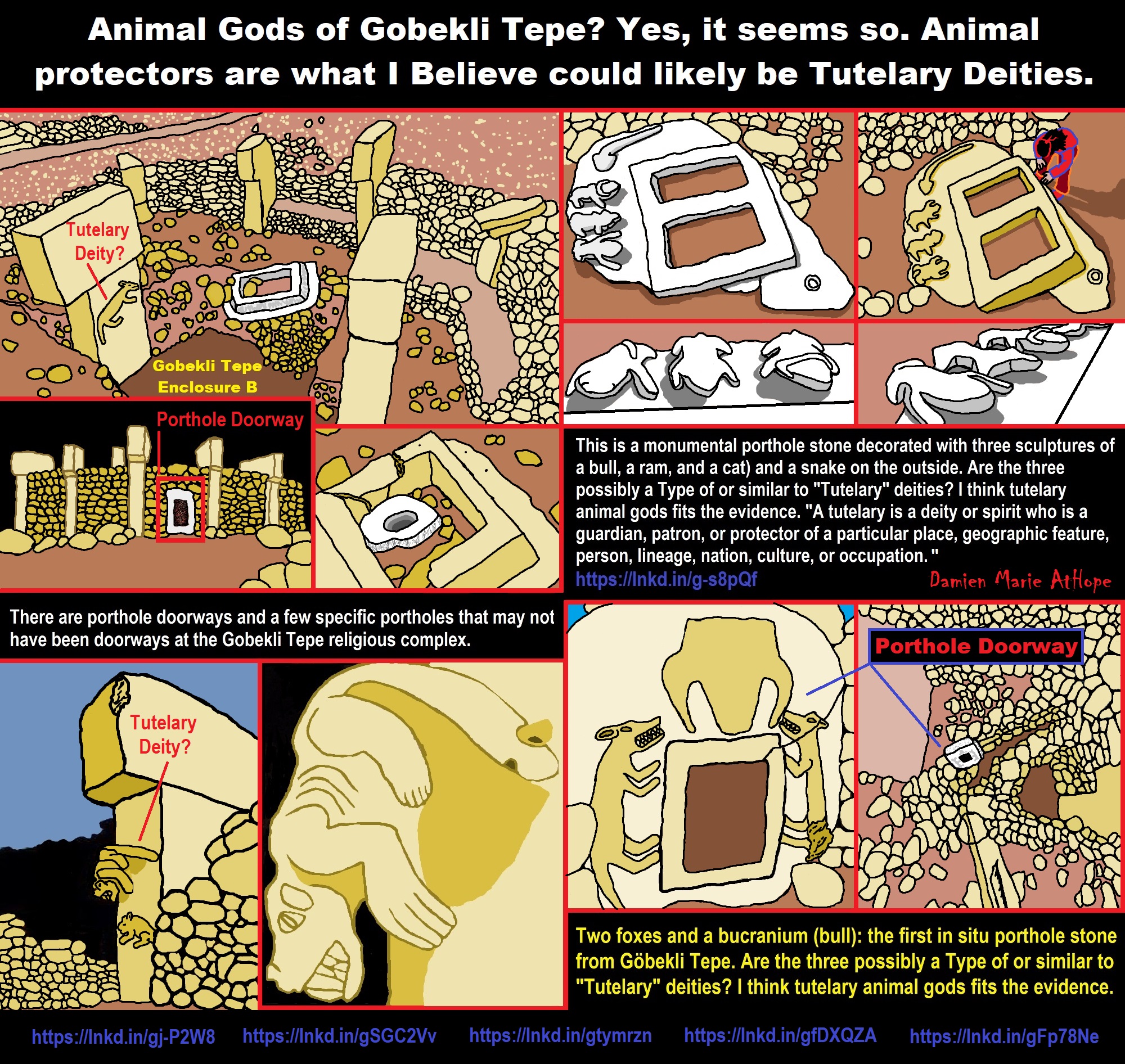
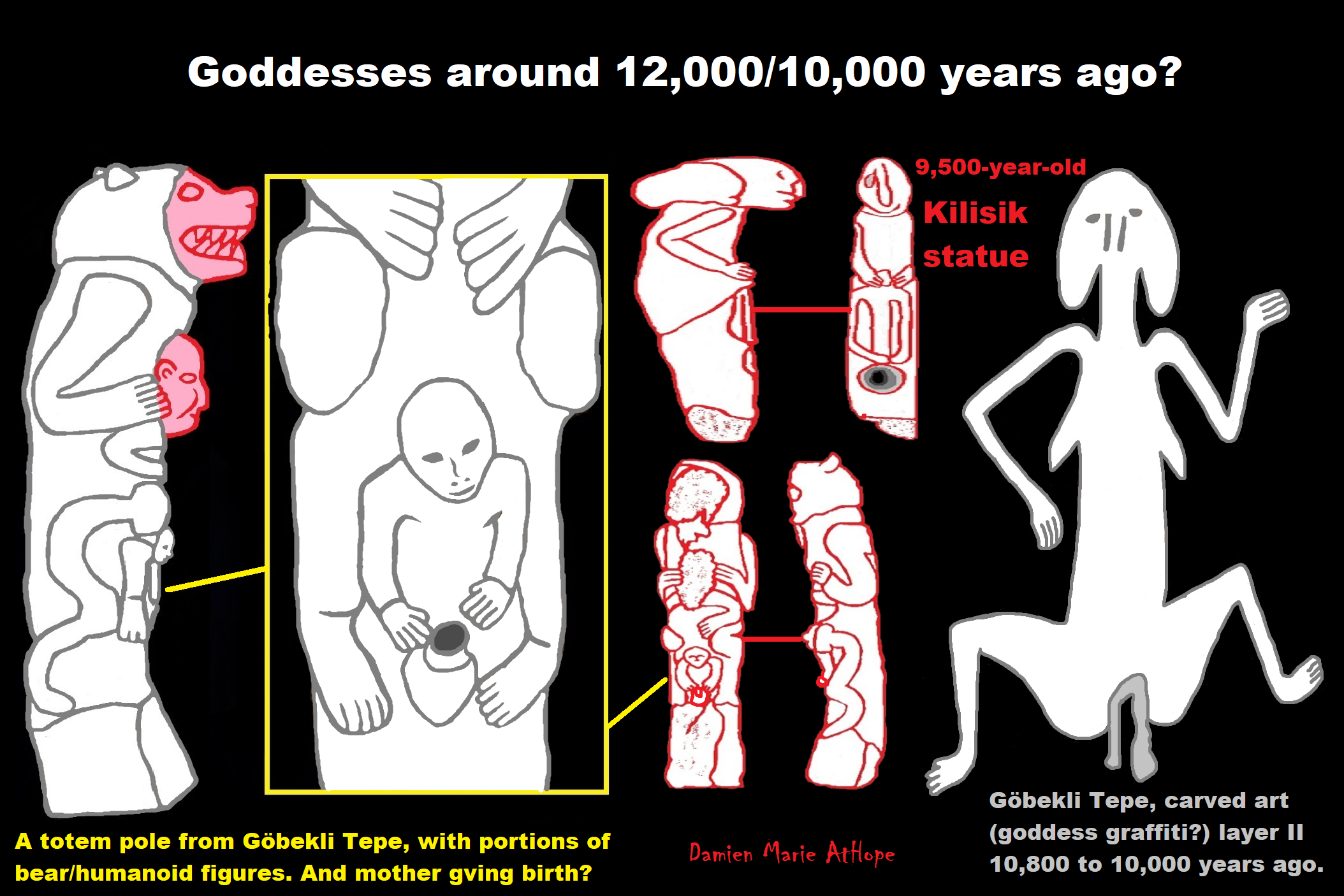
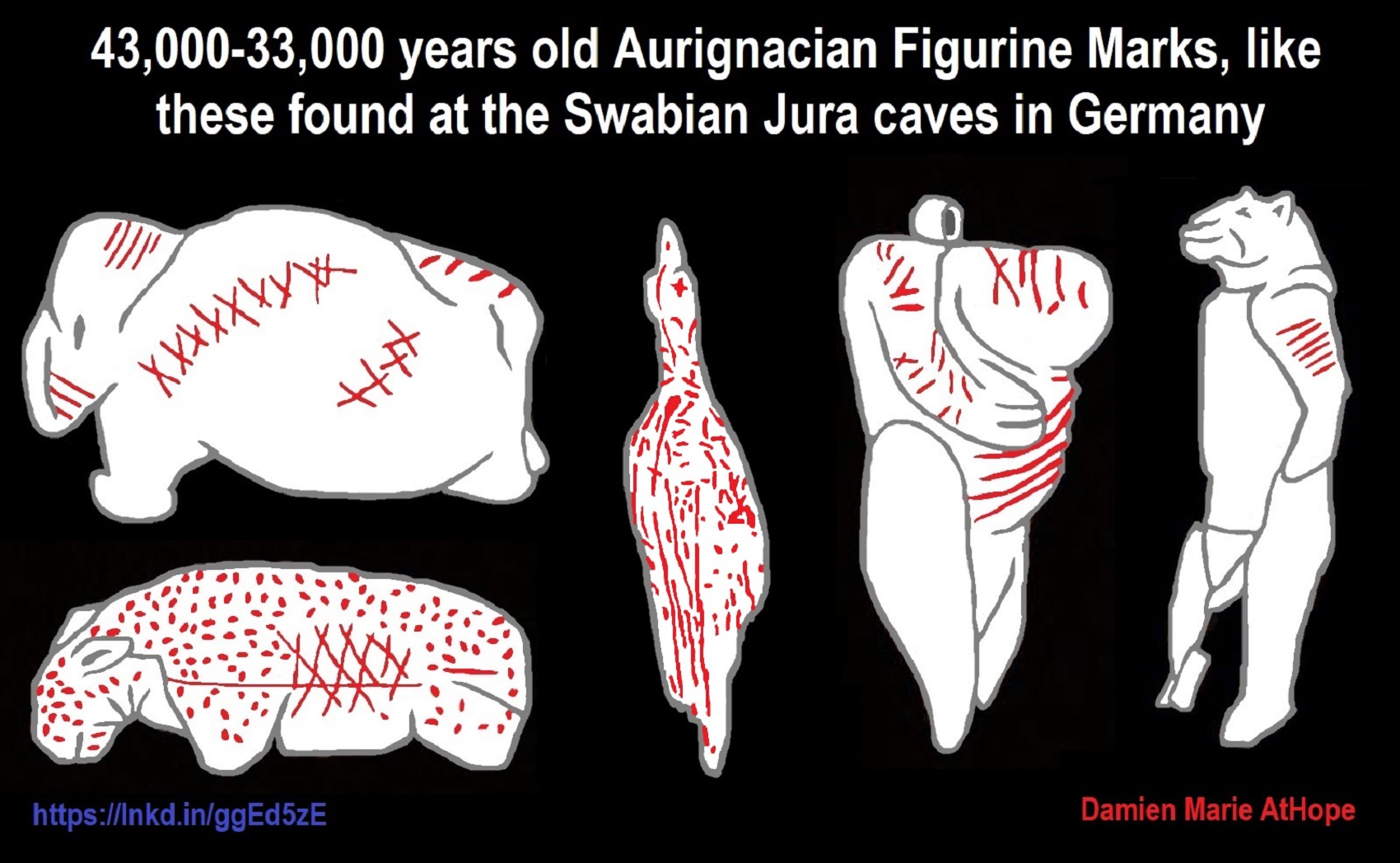
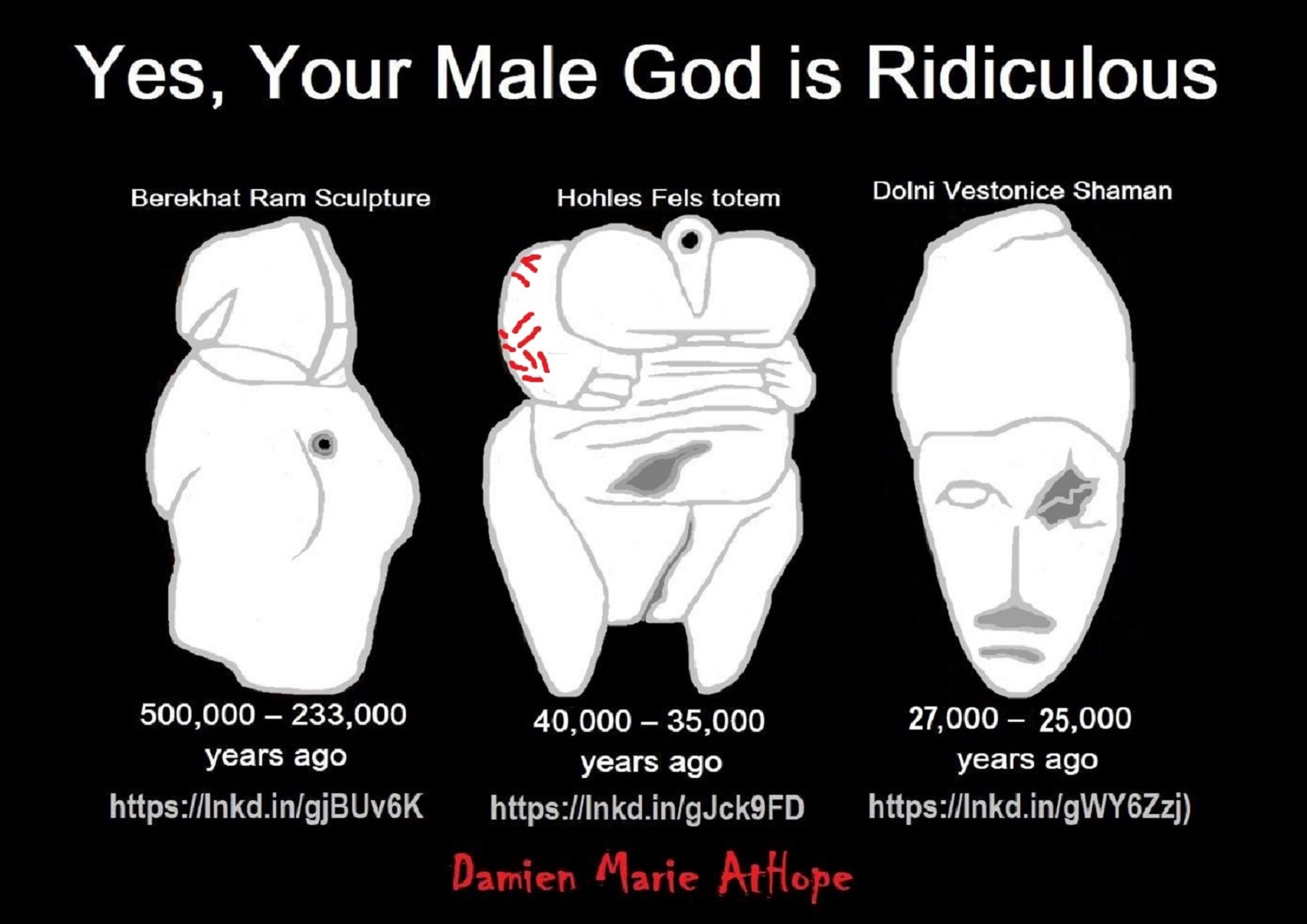

Often a wise person can learn, even something from a person thinking stupid, but often a person thinking stupid can’t learn, even something from a wise person.
I offer so much of my stuff to others for free, not because its value is low, but because my heart of care is rich.
Only the unjust, are truly comfortable with the oppression and harm of others. If you think society is great, wow do I have some news for you. Think, how often is it the powerless that start wars, oppress others, or commit genocide? So, I guess the question is to us all, to ask, how can power not carry responsibility in a humanity concept?
I spend most of my efforts improving the ranks of leftists, solidarity, so other leftists may pick on each other not me. Humanitarian issues are my focus. I am not like most, I am a leftist, not by reading any leftist stuff but by my own thinking, thus I act differently at times.
While I have often impressed some with my skilled words of anger, it is my world of kindness, that has truly changed lives. There is someone somewhere that remembers “you”, simply because you showed them kindness. So as often as you can, strive to be kind.
I was asked what is my favorite put down of believers. Well, I don’t worry about putting anyone down, my goal is offering info to challenge what believers think they know, hoping to change their minds. Truth rather than some fixed thing is at times but a guess, later shown accurate thus labeled knowledge or possibly seen as wrong in the sunlight of new information, requiring correction.
We have different knowledge, but that is good as we then complement areas the other is not better at. We don’t have to be good at everything, we have each other, we are our best when we work in solidarity, not competition.
I teach online mainly, I am doing it now for instance, (or in-person, if asked and my way is paid), humanity, prehistory, kindness, atheism, humanism, religion, reason, rationalism, truth navigation, science, philosophy, morality, axiology, solidarity, anarchism, socialism, etc.
I was not influenced by anyone in the atheist movement, so I don’t use a style that most under that label do. They doubt religions and gods but I prove their evolution in the story of human cultural expressions and connected rituals and mythology. Not hating, I invented my style.
To me, paganism starts around 12,00 years ago in Turkey/Anatolia in Western Asia. The odd thing is most of the world’s religious myths/fables start or commonly relate to “Siberia” like “Lake Baikal/Golden Mountains of Altai” region and “North China like Chertovy Vorota Cave (Devil’s Gate Cave) area at about 8,000/7,000 years ago and they were transferred to the middle east and East Europe/Balkans/Ukraine as well.”
- “12,000 years ago: Jericho has evidence of settlement dating back to 10,000 BC. Jericho was a popular camping ground for Natufian hunter-gatherer groups, who left a scattering of crescent microlith tools behind them.
- 12,000 years ago: Earliest dates suggested for the domestication of the goat.
- 11,600 years ago: Start of the current Holocene epoch.
- 11,000 -12,00/13,000 years ago (9,000 BC): Earliest date recorded for construction of temenoi ceremonial structures at Göbekli Tepe in southern Turkey, as possibly the oldest surviving proto-religious site on Earth.
- 11,000 years ago: Emergence of Jericho, which is now one of the oldest continuously inhabited cities in the world. Giant short-faced bears and giant ground sloths go extinct. Equidae goes extinct in North America.
- 10,500 years ago: Earliest supposed date for the domestication of cattle.
- 10,000 years ago: The Quaternary extinction event, which has been ongoing since the mid-Pleistocene, concludes. Many of the ice age megafauna go extinct, including the megatherium, woolly rhinoceros, Irish elk, cave bear, cave lion, and the last of the sabre-toothed cats. The mammoth goes extinct in Eurasia and North America, but is preserved in small island populations until ~1650 BC.
- 11,000 – 9,000 years ago: Byblos appears to have been settled during the PPNB period, approximately 8800 to 7000 BC. Neolithic remains of some buildings can be observed at the site.
- 10,000 – 8,000 years ago: The post-glacial sea level rise decelerates, slowing the submersion of landmasses that had taken place over the previous 10,000 years.
- 10,000 – 9,000 years ago: In northern Mesopotamia, now northern Iraq, cultivation of barley and wheat begins. At first they are used for beer, gruel, and soup, eventually for bread. In early agriculture at this time, the planting stick is used, but it is replaced by a primitive plow in subsequent centuries. Around this time, a round stone tower, now preserved to about 8.5 meters high and 8.5 meters in diameter is built in Jericho.
- 9,500–5,900 years ago: Neolithic Subpluvial in North Africa. The Sahara desert region supports a savanna-like environment. Lake Chad is larger than the current Caspian Sea. An African culture develops across the current Sahel region.
- 9,500 years ago: Çatalhöyük urban settlement founded in Anatolia. Earliest supposed date for the domestication of the cat.
- 9,200 years ago: First human settlement in Amman, Jordan; ‘Ain Ghazal Neolithic settlement was built spanning over an area of 15 hectares.
- 9,000 years ago: Jiahu culture began in China.
- 9,000 years ago: large first fish fermentation in southern Sweden.
- 8,200–8,000 years ago: 8.2 kiloyear event: a sudden decrease of global temperatures, likely caused by the final collapse of the Laurentide Ice Sheet, which leads to drier conditions in East Africa and Mesopotamia.
- 8,000-5,000 years ago: development of proto-writing in China, Southeast Europe (Vinca symbols), and West Asia (proto-literate cuneiform).
- 8,000 years ago: Evidence of habitation at the current site of Aleppo dates to about c. 8,000 years ago, although excavations at Tell Qaramel, 25 kilometers north of the city show the area was inhabited about 13,000 years ago, Carbon-14 dating at Tell Ramad, on the outskirts of Damascus, suggests that the site may have been occupied since the second half of the seventh millennium BC, possibly around 6300 BC. However, evidence of settlement in the wider Barada basin dating back to 9000 BC exists.
- 7,500 years ago: Copper smelting in evidence in Pločnik and other locations.
- 7,200–6,000 years ago: 5200–4000 BC:Għar Dalam phase on Malta. First farming settlements on the island.
- 6,100–5,800 years ago: Żebbuġ phase. Malta.
- 6,070–6,000 years ago: Trypillian build in Nebelivka (Ukraine) settlement which reached 15,000—18,000 inhabitants.
- 6,500 years ago: The oldest known gold hoard deposited at Varna Necropolis, Bulgaria.
- 6,000 years ago: Civilizations develop in the Mesopotamia/Fertile Crescent region (around the location of modern-day Iraq). Earliest supposed dates for the domestication of the horse and for the domestication of the chicken, invention of the potter’s wheel.
- 5,900 years ago: 5.9 kiloyear event: a rapid and intense aridification event, which likely started the current Sahara Desert dry phase and a population increase in the Nile Valley due to migrations from nearby regions. It is also believed this event contributed to the end of the Ubaid period in Mesopotamia.
- 5,800 years ago: The Post Track and Sweet Track causeways are constructed in the Somerset Levels.
- 5,800 years ago: Trypillian build in Talianki (Ukraine) settlement which reached 15,600—21,000 inhabitants.
- 5,800–5,600 years ago: Mġarr phase A short transitional period in Malta’s prehistory. It is characterized by pottery consisting of mainly curved lines.
- 5,700 years ago: starts mass graves at Tell Brak in Syria.
- 5,700 years ago: Trypillian build in Maidanets (Ukraine) settlement which reached 12,000—46,000 inhabitants and built 3-story building.
- 5,700 years ago: Minoan culture begins on Crete.
- 5,600–5,200 years ago: Ġgantija phase on Malta. Characterized by a change in the way the prehistoric inhabitants of Malta lived.
- 5,500 years ago: Uruk period in Sumer. The first evidence of mummification in Egypt.
- 5,500 years ago: the oldest known depiction of a wheeled vehicle (Bronocice pot, Funnelbeaker culture)
- 5,300 years ago: Bronze Age begins in the Near East, Newgrange is built in Ireland. Hakra Phase of the Indus Valley Civilisation begins in the Indian subcontinent.
- 5,300–5,000 years ago: Saflieni phase in Maltese prehistory.” ref
Hinduism around 3,700 to 3,500 years old.
Judaism around 3,450 or 3,250 years old. (The first writing in the bible was “Paleo-Hebrew” dated to around 3,000 years ago Khirbet Qeiyafa is the site of an ancient fortress city overlooking the Elah Valley. And many believe the religious Jewish texts were completed around 2,500)
Jainism around 2,599 – 2,527 years old.
Confucianism around 2,600 – 2,551 years old.
Buddhism around 2,563/2,480 – 2,483/2,400 years old.
Christianity around 2,o00 years old.
Shinto around 1,305 years old.
Islam around 1407–1385 years old.
Sikhism around 548–478 years old.
Bahá’í around 200–125 years old.
- 5,750 years ago: The Proto-Semitic people emerged from a generally accepted urheimat in the Levant. The Proto-Semitic people would migrate throughout the Near East into Mesopotamia, Egypt, Ethiopia, and the eastern shore of the Mediterranean.
- 5,700 years ago: Lothal: Indus Valley trade-port city in India.
- 5,650 years ago: Minoan culture appeared on Crete.
- 5,500 Years old birth of the State, the rise of Hierarchy, and the fall of Women’s status
- 5,300 years ago: The Indus Valley Civilization (IVC) was a Bronze Age civilization (3300–1300 BCE; mature period 2600–1900 BCE) in the northwestern region of the Indian subcontinent, noted for its cities built of brick, roadside drainage system and multi-storeyed houses, as well as for creating artifacts which could be linked to pre-Vedic religions.
- 5,200 years ago: Helladic culture and Cycladic culture both emerge in Greece.
- 5,102 years ago: This was the beginning of Kaliyuga, a new age among the followers of Indian religions.
- 5,100 years ago: The initial form of Stonehenge was completed. The circular bank and ditch enclosure, about 110 meters (360 ft) across, may have been completed with a timber circle.
- 5,100 years ago: Newgrange, the 250,000 ton (226,796.2 tonnes) passage tomb aligned to the winter solstice in Ireland, was built.
- 5,000 years ago: Unification of Upper and Lower Egypt.
- 5,000 years ago: First evidence of gold being used in the Middle East.
- 5,000 years ago: Vessels from Denmark
- 5,000 years ago: Sumerian Cuneiform emerged from the proto-literate Uruk period, allowing the codification of beliefs and creation of detailed historical religious records.
- 5,000 years ago: The second phase of Stonehenge was completed and appeared to function as the first enclosed cremation cemetery in the British Isles.
- 4,900 years ago: Beginning of the Early Dynastic Period I in Sumer.
- 4,900 years ago: Sumerianpictographs evolve into phonograms.
- 4,900 years ago: Mesopotamian wars of the Early Dynastic period.
- 4,900 years ago: Votive statues from the Square Temple of Eshnunna (modern Tell Ashmar, Iraq) were made.
- 4,900 years ago: Syria: Foundation of the city of Mari.
- 4,900 years ago: Semitic tribes occupy Assyria in the northern part of the plain of Shinar and Akkad.
- 4,900 years ago: Phoenicians settle on Syrian coast, with centers at Tyre and Sidon.
- 4,900 years ago: Beginning of the period of the Sage Kings in China, also known as the Three Sovereigns and Five Emperors.
- 4,900 years ago: Ziggurats (multi-platform temples: 4,900 years old) to Pyramids (multi-platform tombs: 4,700 years old)
- 4,879 years ago: Rise of the Văn Lang Kingdom and the Hồng Bàng Dynasty in northern Viet Nam.
- 4,874 years ago: The 365-day calendar year was installed in ancient Egypt
- 4,852 years ago: The beginning of the period of the Three August Ones and Five Emperors in China.
- 4,832 years ago: Estimated germination of the Methuselah Tree, the oldest known living organism
- 4,807 years ago: Suggested date for an asteroid or comet impact occurring between Africa and Antarctica, around the time of a solar eclipse on May 10, based on an analysis of flood stories. Possibly causing the Burckle crater and Fenambosy Chevron.
- 4,800 years ago: Ur becomes one of the richest cities in Sumer
- 4,800 years ago: Harp Player, from Keros, Cyclades, was made. It is now at the Metropolitan Museum of Art, New York.
- 4,800 years ago: Iran: Creation of the Kingdom of Elam.
- 4,800 years ago: Seated Harp Player, from Keros, Cyclades, is made.
- 4,775 years ago: Second Dynasty wars in Ancient Egypt.
- 4,773 years ago: the 365-day calendar is introduced in Egypt.
- 4,750 years ago: End of the Early Dynastic I Period, and the beginning of the Early Dynastic II Period in Mesopotamia.
- 4,750 years ago: Estimated ending of the Cucuteni-Trypillian culture in the region of modern-day Romania, Moldova, and southwestern Ukraine
- 4,700 years ago: Germination of the Bristlecone pine tree “Methuselah“, one of the oldest known trees still living now.
- 4,700 years ago: Merit-Ptah is world’s first female physician mentioned by name.
- 4,700 years ago: Old Kingdom of Egypt begins. 3rd–6th Dynasties.
- 4,700 years ago: Mesoamericans begin to plant and domesticate maize.
- 4,697 years ago: The Yellow Emperor starts to reign in China.
- 4,685 years ago: Bull lyre from the tomb of Queen Puabi, Ur (modern Muqaiyir, Iraq) was made.
- 4,640 years ago: The cultivation and weaving of silk starts to be a closely guarded secret in China.
- 4,630 years ago: Imhotep, Vizier of Egypt, constructs the Pyramid of Djoser The Djoser pyramid is a step pyramid (or proto-pyramid) is considered to be the earliest large-scale cut stone construction and was thought to function in both life and the afterlife, which was sealed with a 3.5 ton block after the burial. The symbolism of the step pyramid form, which did not survive the 3rd Dynasty, is unknown, but it has been suggested that it may be a monumental symbol of the crown, especially the royal mortuary cult, since seven small step pyramids (not tombs) were built in the provinces.
- 4,627 years ago: Construction of the Caral metropolis in Peru
- 4,600 years ago: Mature Harappan phase of the Indus Valley Civilisation begins. The cities of Harappa and Mohenjo-daro become large metropolises and the civilization expands to over 2,500 cities and settlements across the whole of Pakistan, much of northern India, and parts of Afghanistan and Iran, covering a region of around one million square miles, which was larger than the land area of its contemporaries Egypt and Mesopotamia combined, and also had superior urban planning and sewage systems. The civilization began using the mature Indus script for its writing system.
- 4,600 years ago: End of the Early Dynastic II Period and the beginning of the Early Dynastic IIIa Period in Mesopotamia.
- 4,600 years ago: Founding of the Chalcolithic Iberian civilizations of Los Millares and Zambujal.
- 4,600 years ago: the Indus Valley Civilisation rises to become a powerful civilization.
- 4,600 years ago: Pre-Palace Period, phase I, in Crete
- 4,600 years ago: Wild horses still provide hunting feasts in Denmark. (Clutton-Brock)
- 4,600 years ago: Large water tank, possibly a public or ritual bathing area, Mohenjo-daro, Indus Valley Civilisation, is made.
- 4,600 years ago: Butmir culture existed in Butmir, near Ilidža, Bosnia and Herzegovina, dating from the Neolithic. It is characterized by its unique pottery, and is one of the best researched European cultures from 2600-2400 BC.
- 4,600 years ago: Unified Indus Valley Civilisation.
- 4,550 years ago: Estimated date of completion of the Great Pyramid of Giza.
- 4,550 years ago: Mesannepada is king of Ur (followed by his son, A-annepadda) who founds the First Dynasty of Ur and overthrows the last king of Uruk, as well as Mesilim of Kish.
- 4,550 years ago:: Great Lyre with bull’s head, from the tomb of King Meskalamdug, Ur (modern Muqaiyir, Iraq) is made.
- 4,500 years ago: Excavation and development of the Hypogeum of Ħal-Saflieni at Paola, Malta, a subterranean temple complex subsequently used as a necropolis.
- 4,500 years ago: The legendary line of Three Sovereigns and Five Emperors of China is founded by the Yellow Emperor.
- 4,500 years ago: the construction of the stone circle at Stonehenge begins and continues for the next five hundred years.
- 4,500 years ago: Rice was first introduced to Malaysia
- 4,500 years ago: Scribal schools flourish throughout Sumer.
- 4,500 years ago: Assyria is established.
- 4,500 years ago: Cylinder seal from Sumer and its impression are made. It is now in the Metropolitan Museum of Art, New York.
- 4,500 years ago: Excavation and development of the Hypogeum of Ħal-Saflieni at Paola, Malta, a subterranean temple complex subsequently used as a necropolis.
- 4,500 years ago: Valley Temple of Khafra, Giza, is built.
- 4,500 years ago: Khafra from Giza Valley, Temple of Khafra is made. Fourth Dynasty of Egypt. Discovered by Auguste Mariette. It is now kept in Egyptian Museum, Cairo.
- 4,500 years ago: Mohenjo-daro is about 7 square miles (18 km2) in size and has a population of c. 20,000 to 50,000.
- 4, 500 years ago: Incised panel “Frying pan”, from Syros, Cyclades is made.
- 4,500 years ago: Two figures of women, from the Cyclades, are made.
- 4,494 years ago: End of Fourth Dynasty, start of Fifth Dynasty in Egypt. Construction of the Pyramids begins.
- 4,494 years ago: “Sculptors at work”, relief from Saqqara, Fifth Dynasty. It is now at Egyptian Museum, Cairo, Egypt.
- 4,494 years ago: The Seated Scribe, a sculpture found at Saqqara, Fifth Dynasty of Egypt is made.
- 4,494 years ago: The first of the oldest surviving religious texts, the Pyramid Texts, was composed in Ancient Egypt.
- 4,492 years ago: Traditional date for the legendary foundation of Armenia by Hayk.
- 4,492 years ago: The Armenian patriarch Hayk defeats the Babylonian king Bel (legendary account) and Hayk founds Armenia.
- 4,474 years ago: Golden age of Ur in Mesopotamia.
- 4,450 years ago: End of the Early Dynastic IIIa Period and beginning of the Early Dynastic IIIb Period in Sumer.
- 4,450 years ago: Kish is lost to Hamazi tribesmen of the Kurdistan mountains; Elam under the Awan dynasty occupies parts of Sumer.
- 4,419 years ago: Neferefre is pharaoh
- 4,410 years ago: By this time, kings in Sumer have ceased to be automatically high priests of the city deity. Infiltration and conquest of Mesopotamia by ancient Semitic-speaking peoples begins.
- 4,400 years ago: Construction of Stonehenge
- 4,400 years ago: Megalithic culture begins to spread through Europe and the western Mediterranean.
- 4,400 years ago: Earliest signs of Corded Ware culture from the Caucasus.
- 4,400 years ago: Southeastern Spain is settled from the Mediterranean, by people using Prehistoric Egyptian-style pottery.
- 4,400 years ago: Amorites and Canaanites occupy Syria and Lebanon.
- 4,334 years ago: Sargon of Akkad conquers Mesopotamia, establishing the Akkadian Empire.
- 4,334 years ago: City of Lothal was founded under the Indus Valley Civilisation.
- 4,333 years ago: According to the Korean creation story, Dangun Wanggeom established the first Korean Empire, Gojoseon
- 4,300 years ago: C-Group pastoralists arrive in Nubia.
- 4,300 years ago: Megalithic, Corded Ware culture, and the Beaker flourish in Europe.
- 4,300 years ago: Sumerian poetry, lamenting the death of Tammuz, the shepherd god.
- 4,300 years ago: Sumerian cuneiform writing reduces pictographs still in use to about 550 BC.
- 4,300 years ago: Major religious festival in Sumeria celebrates the victory of god of spring over goddess of chaos.
- 4,300 years ago: Earliest Trojan culture.
- 4,300 years ago: Beginning of the Pengtoushan culture in China.
- 4,300 years ago: Indus Valley Civilization (Harappan) flourishing in modern-day eastern Pakistan – western India.
- 4,300 years ago: Metals start to be used in Northern Europe.
- 4,300 years ago: Unetice culture emerges in the modern-day Czech Republic.
- 4,300 years ago: Disk of Enheduanna, from Ur, (modern Muqaiyir, Iraq) is made.
- 4,300 years ago: “Head of a man from Nineveh” (modern Kuyunjik, Iraq) is made.
- 4,285 years ago: Enheduanna, high priestess of the moon god Nanna in Ur, was born.
- 4,254 years ago: Stela of Naram-Sin, probably from Sippar, discovered in Susa (modern Shush, Iran), is made.
- 4,250 years ago: Earliest evidence of maize cultivation in Central America.
- 4,240 years ago: Akkad, capital of the Akkadian Empire, becomes the largest city in the world, surpassing Memphis, capital of Egypt.
- 4,220 years ago: Scord of Brouster farmstead established in Shetland, Scotland
- 4.2 kiloyear event– a severe aridification event that probably lasted the entire 22nd century BC and caused the collapse of several Old World civilizations.
- 4,217 years ago: Nomadic invasions of Akkad.
- 4,200 years ago: The Minoan Civilization developed in Crete. Citizens worshipped a variety of goddesses.
- 4,150 years ago: The earliest surviving versions of the Sumerian Epic of Gilgamesh—originally titled He who Saw the Deep (Sha naqba īmuru) or Surpassing All Other Kings (Shūtur eli sharrī)—were written.
- 4,104 years ago: Approximate date of the Biblical flood according to the Hebrew Calendar.
- 4,070 years ago: Xia Dynasty, first Chinese dynasty, and government system established.
- 4,000 years ago: Kultepe? An archaeological site with a 4,000 years old women’s rights document.
- 3,700 years ago: The oldest of the Hindu Vedas (scriptures), the Rig Veda was composed.
- 3,600 years ago: The ancient development of Stonehenge came to an end.
- 3,500 years ago: The Vedic Age began in India after the collapse of the Indus Valley Civilisation.
- 3,450 years ago: This is the traditionally accepted period in which, according to legend, the Israelite lawgiver Moses gave the Ten Commandments.
- 3,351 years ago: The reign of Akhenaten, sometimes credited with starting the earliest known recorded monotheistic religion, in Ancient Egypt
- 3,300 years ago: The “standard” Akkadian version of the Epic of Gilgamesh was edited by Sin-liqe-unninni.
- 3,250 years ago: The Upanishads (Vedic texts) were composed, containing the earliest emergence of some of the central religious concepts of Hinduism, Buddhism, and Jainism. ref, ref, ref, ref, ref, ref, ref, ref, ref, ref, ref
4,150–4,000 years ago or so: The earliest surviving versions of the Sumerian Epic of Gilgamesh—originally titled He who Saw the Deep (Sha naqba īmuru) or Surpassing All Other Kings (Shūtur eli sharrī)—were written. ref
3,700–3,100 years ago or so: The oldest of the Hindu Vedas (scriptures), the Rig Veda was composed. ref
3,600 years ago or so: The ancient development of Stonehenge came to an end. ref
3,500 years ago or so: The Vedic Age began in India after the collapse of the Indus Valley Civilisation. ref
3,450 or 3,250 years ago or so: This is the traditionally accepted period in which, according to legend, the Israelite lawgiver Moses gave the Ten Commandments ref The Hebrew Bible, or the Old Testament (abbreviated OT) is the first part of Christian Bibles based primarily upon the Hebrew Bible (or Tanakh), a collection of ancient religious writings by the Israelites dates to around 2,500/2,400 or less. The most accepted hypothesis, the canon formed in stages, first the Pentateuch by around 400 BC, then the Prophets during the Hasmonean dynasty (140-116 BC), and finally the remaining books. Christians traditionally divide the Old Testament into four sections: (1) the first five books or Pentateuch (Torah); (2) the history books telling the history of the Israelites, from their conquest of Canaan to their defeat and exile in Babylon; (3) the poetic and “Wisdom books” dealing, in various forms, with questions of good and evil in the world; and (4) the books of the biblical prophets, warning of the consequences of turning away from God. ref The bible inspired religion was not one thing but many:
(Henotheism Exodus 20:23 “You shall not make other gods besides Me (not saying there are no other gods just not to worship hem); gods of silver or gods of gold, you shall not make for yourselves.”
(Polytheism: Judges 10:6 “Then the sons of Israel again did evil in the sight of the LORD, served the Baals and the Ashtaroth, the gods of Aram, the gods of Sidon, the gods of Moab, the gods of the sons of Ammon, and the gods of the Philistines; thus they forsook the LORD and did not serve Him. 1 Corinthians 8:5 “For even if there are so-called gods whether in heaven or on earth, as indeed there are many gods and many lords.”)
In the Hebrew Bible, there are multiple descriptions of Yahweh presiding over a great assembly of Heavenly Hosts. Some interpret these assemblies as examples of Divine Council: “The Old Testament description of the ‘divine assembly’ all suggest that this metaphor for the organization of the divine world was consistent with that of Mesopotamia and Canaan. One difference, however, should be noted. In the Old Testament, the identities of the members of the assembly are far more obscure than those found in other descriptions of these groups, as in their polytheistic environment. Israelite writers sought to express both the uniqueness and the superiority of their God Yahweh.” The Book of Psalms (Psalm 82:1), states “God (אֱלֹהִ֔ים elohim) stands in the divine assembly (בַּעֲדַת-אֵל ); He judges among the gods (אֱלֹהִ֔ים elohim)” (אֱלֹהִים נִצָּב בַּעֲדַת־אֵל בְּקֶרֶב אֱלֹהִים יִשְׁפֹּט). The meaning of the two occurrences of “elohim” has been debated by scholars, with some suggesting both words refer to Yahweh, while others propose that the God of Israel rules over a divine assembly of other Gods or angels. Some translations of the passage render “God (elohim) stands in the congregation of the mighty to judge the heart as God (elohim)” (the Hebrew is “beqerev elohim”, “in the midst of gods”, and the word “qerev” if it were in the plural would mean “internal organs”). Later in this Psalm, the word “gods” is used (in the KJV): Psalm 82:6 – “I have said, Ye [are] gods; and all of you [are] children of the most High.” Instead of “gods”, another version has “godlike beings”, but here again, the word is elohim/elohiym (Strong’s H430). This passage is quoted in the New Testament in John 10:34. In the Books of Kings (1 Kings 22:19), the prophet Micaiah has a vision of Yahweh seated among “the whole host of heaven” standing on his right and on his left. He asks who will go entice Ahab and a spirit volunteers. This has been interpreted as an example of a divine council. The first two chapters of the Book of Job describe the “Sons of God” assembling in the presence of Yahweh. Like “multitudes of heaven”, the term “Sons of God” defies certain interpretation. This assembly has been interpreted by some as another example of divine council. Others translate “Sons of God” as “angels”, and thus argue this is not a divine council because angels are God’s creation and not deities. “The role of the divine assembly as a conceptual part of the background of Hebrew prophecy is clearly displayed in two descriptions of prophetic involvement in the heavenly council. In 1 Kings 22:19-23… Micaiah is allowed to see God (elohim) in action in the heavenly decision regarding the fate of Ahab. Isaiah 6 depicts a situation in which the prophet himself takes on the role of the messenger of the assembly and the message of the prophet is thus commissioned by Yahweh. The depiction here illustrates this important aspect of the conceptual background of prophetic authority.” The concept of a divine assembly (or council) is attested in the archaic Sumerian, Akkadian, Old Babylonian, Ancient Egyptian, Babylonian, Caananite, Israelite, Celtic, Ancient Greek and Ancient Roman and Nordic pantheons. Ancient Egyptian literature reveals the existence of a “synod of the gods”. Some of our most complete descriptions of the activities of the divine assembly are found in the literature from Mesopotamia. Their assembly of the gods, headed by the high god Anu, would meet to address various concerns. The term used in Sumerian to describe this concept was Ukkin, and in later Akkadian and Aramaic was puhru. Sons of God (Heb: bənê hāʼĕlōhîm, בני האלהים) is a phrase used in the Hebrew Bible and apocrypha. The phrase is also used in Kaballah where Bene elohim are part of different Jewish angelic hierarchies. ref, ref
Genesis 6: When man began to multiply on the face of the land and daughters were born to them, the sons of God saw that the daughters of man were attractive. And they took as their wives any they chose. Then the Lord said, “My Spirit shall not abide in man forever, for he is flesh: his days shall be 120 years.” The Nephilim were on the earth in those days, and also afterward, when the sons of God came in to the daughters of man and they bore children to them. These were the mighty men who were of old, the men of renown. — Genesis 6:1-4
The first mention of “sons of God” in the Hebrew Bible occurs at Genesis 6:1-4. In terms of literary-historical origin, this phrase is typically associated with the Jahwist tradition. This passage has had two interpretations in Judaism.
- Offspring of Seth: The first references to the offspring of Seth rebelling from God and mingling with the daughters of Cain are found in Christian and Rabbinic literature from the second century CE onwards e.g. Rabbi Shimon bar Yochai, Augustine of Hippo, Julius Africanus, and the Letters attributed to St. Clement. It is also the view expressed in the modern canonical Amharic Ethiopian Orthodox Bible. In Judaism “Sons of God” usually refers to the righteous, i.e. the children of Seth.
- Angels: All of the earliest sources interpret the “sons of God” as angels. From the 2,300 years ago onwards, references are found in the Enochic literature, the Dead Sea Scrolls the (Genesis Apocryphon, the Damascus Document, 4Q180), Jubilees, the Testament of Reuben, 2 Baruch, Josephus, and the book of Jude (compare with 2 Peter 2). This is also the meaning of the only two identical occurrences of bene ha elohim in the Hebrew Bible (Job 1:6 and 2:1), and of the most closely related expressions (refer to the list above). In the Septuagint, the interpretive reading “angels” is found in Codex Alexandrinus, one of four main witnesses to the Greek text. ref
Rabbinic Judaism traditionally adheres to the first interpretation, with some exceptions, and modern Jewish translations may translate bnei elohim as “sons of rulers” rather than “sons of God”. Regardless, the second interpretation (sons of angels or other divine beings) is nonexistent in modern Judaism. This is reflected by the rejection of Enoch and other Apocrypha supporting the second interpretation from the Hebrew Bible Canon. Joseph Hong believes that Genesis 6:1-4 has gone through drastic abridgment by either the original writer or later editors. Nahum M. Sarna believes that the text defies certain interpretation, based on difficulties with the text’s themes, extreme terseness, vocabulary, and syntax. Sarna postulates that such a passage cannot be other than a fragment, or bare outline, from a well-known fuller story. ref, ref
(Monotheism: Isaiah 43:10 “You are my witnesses,” declares the LORD, “and my servant whom I have chosen, so that you may know and believe me and understand that I am he. Before me no god was formed, nor will there be one after me.
3,351 or 3,353 years ago or so: The reign of Akhenaten, sometimes credited with starting the earliest known recorded monotheistic or at least Henotheism a religion, in Ancient Egypt. ref
3,300 – 3,000 years ago or so: The “standard” Akkadian version of the Epic of Gilgamesh was edited by Sin-liqe-unninni. ref
3,250 – 2,600 years ago or so: The Upanishads (Vedic texts) were composed, containing the earliest emergence of some of the central religious concepts of Hinduism, Buddhism, and Jainism. ref
3,200 years ago or so: The Olmecs built the earliest pyramids and temples in Central America. ref
2,800 to 2,600 years ago or so: The Chandogya Upanishad is compiled, significant for containing the earliest to date mention of Krishna. Verse 3.17.6 mentions Krishna Devakiputra as a student of the sage Ghora Angirasa. ref
2,600 – 2,500 years ago or so: The Earliest Confucian type writing, Shu Ching, incorporates ideas of harmony and heaven. ref
2,599 – 2,527 years ago or so: The life of Mahavira, 24th and last Tirthankara of Jainism. The Kalpasutra, a popular text in Jainism, cites Kundagrama as the place where he was born, Present-day Vaishali district, Bihar, India. Though it is universally accepted by scholars of Jainism that Mahavira was an actual person who lived in ancient India, the details of his biography and the year of his birth are uncertain, and continue to be a subject of considerable debate among scholars. The Jain Śvētāmbara tradition believes he was born in 599 BCE and died in 527 BCE, while the Digambara tradition believes 510 BCE was the year he died. The scholarly controversy arises from efforts to date him and the Buddha, because both are believed to be contemporaries according to Buddhist and Jain texts, and because, unlike for Jain literature, there is extensive ancient Buddhist literature that has survived. Almost all Indologists and historians, state Dundas and others, accordingly date Mahavira’s birth to about 497 BCE and his death to about 2,425 years ago. However, the Vira era tradition that started in 527 BCE and places Mahavira in the 6th century BCE is a firmly established part of the Jain community tradition. The 12th-century Jain scholar Hemachandra placed Mahavira in the 5th century BCE. According to Kailash Jain, Hemachandra made an incorrect analysis that, along with attempts to establish Buddha’s nirvana date, has been a source of confusion and controversy about Mahavira’s year of nirvana. Kailash Jain states the traditional date of 527 BCE is accurate, adding that the Buddha was a junior contemporary of the Mahavira and that the Buddha “might have attained nirvana a few years later”. The place of his death, Pavapuri (now in Bihar), is a pilgrimage site for Jains. According to the Digambara Jains, Mahavira was born in 582 BCE. According to the Svetambara Jain texts, he was born in 599 BCE. Mahavira’s birthday, in the traditional calendar, falls on the thirteenth day of the rising moon in the month of Chaitra in the Vira Nirvana Samvat calendar. In the Gregorian calendar, this date falls in March or April and is celebrated by Jains as Mahavir Jayanti. ref, ref
2,563/2,480 – 2,483/2,400 years ago or so: Gautama Buddha, founder of Buddhism was born. ref
2,551 years ago or so: Confucius, founder of Confucianism, was born. ref2,440 years ago or so: Zoroastrianism entered recorded history. ref
2,399 years ago or so: Socrates was tried for impiety.2,300 years ago or so: The oldest known version of the Tao Te Ching was written on bamboo tablets. ref
2,300 years ago or so: Theravada Buddhism was introduced to Sri Lanka by the Venerable Mahinda. ref
2,250 years ago or so: The Third Buddhist council was convened. ref
2,140 years ago or so: The earliest grammar of Sanskrit literature was composed by Pāṇini. ref
2,100 – 1,517 years ago or so: The Yoga Sūtras of Patañjali, constituting the foundational texts of Yoga, were composed. ref
The Common Era
Around years 30/33: The reported death of Jesus of Nazareth, the central figure of Christianity. ref
Around years 31-36: The death of John the Baptist. refAround years 50–62: The first Christian Council was convened in Jerusalem. refAround years 70: The Siege of Jerusalem, the Destruction of the Temple, and the rise of Rabbinic Judaism. refAround years 220: Manichaean Gnosticism was formed by the prophet Mani. ref
Around years 250–900: Classic Mayan step pyramids were constructed. ref
Around years 313: The Edict of Milan decreed religious toleration in the Roman empire. ref
Around years 325: The first ecumenical council (the Council of Nicaea) was convened to attain a consensus on doctrine through an assembly representing all Christendom. It established the original Nicene Creed and fixed the date of Easter. It also confirmed the primacy of the Sees of Rome, Alexandria, and Antioch, and granted the See of Jerusalem a position of honor. ref
Around years 350: The oldest record of the complete biblical texts (the Codex Sinaiticus) survives in a Greek translation called the Septuagint, dating to the 4th century CE. ref
Around years 380: Theodosius I declared Nicene Christianity the state religion of the Roman Empire. refAround years 381: The second ecumenical council (the First Council of Constantinople) reaffirmed and revised the Nicene Creed, repudiating Arianism and Macedonianism. ref
Around years 381–391: Theodosius proscribed paganism within the Roman Empire. ref
Around years 393: A council of early Christian bishops listed and approved a biblical canon for the first time at the Synod of Hippo. ref
Around years 405: St. Jerome completed the Vulgate, the first Latin translation of the Bible. ref
Around years 410: The Western Roman Empire began to decline, signaling the onset of the Dark Ages. ref
Around years 424: The Assyrian Church of the East formally separated from the See of Antioch and the western Syrian Church. refAround years 431: The third ecumenical council (the First Council of Ephesus) was convened as a result of the controversial teachings of Nestorius of Constantinople. It repudiated Nestorianism, proclaimed the Virgin Mary as the Theotokos (the God-bearer or Mother of God). It also repudiated Pelagianism and again reaffirmed the Nicene Creed. ref
Around years 449: The Second Council of Ephesus declared support for Eutyches and attacked his opponents. Originally convened as an ecumenical council, its ecumenical nature was rejected by the Chalcedonians, who denounced the council as latrocinium. ref
Around years 451: The fourth ecumenical council (the Council of Chalcedon) rejected the Eutychian doctrine of monophysitism, adopting instead the Chalcedonian Creed. It reinstated those deposed in 449, deposed Dioscorus of Alexandria and elevated the bishoprics of Constantinople and Jerusalem to the status of patriarchates. ref
Around years 451: The Oriental Orthodox Church rejected the christological view put forth by the Council of Chalcedon and was excommunicated. ref
Around years 480–547: Benedict of Nursia wrote his Rule, laying the foundation of Western Christian monasticism. ref
Around years 553: The fifth ecumenical council (the Second Council of Constantinople) repudiated the Three Chapters as Nestorian and condemned Origen of Alexandria. ref
Around years 570–632: The life of Muhammad ibn ‘Abdullāh, the Prophet of Islam. refAround years 632–661: The Rashidun Caliphate heralded the Arab conquest of Persia, Egypt, and Iraq, bringing Islam to those regions. ref
Around years 610 –632: Muslims believe that the verses of the Quran were revealed to Muhammad by God through the archangel Gabriel (Jibrīl) on many occasions between 610 CE until his death on June 8, 632. While Muhammad was alive, all of these revelations were written down by his companions (sahabah), although the prime method of transmission was orally through memorization. ref ref
Around year 650: The verses of the Qur’an were compiled in the form of a book in the era of Uthman, the third Caliph of Islam. The Quran is divided into 114 suras, or chapters, which combined, contain 6,236 āyāt, or verses. The chronologically earlier suras, revealed at Mecca, are primarily concerned with ethical and spiritual topics. The later Medinan suras mostly discuss social and moral issues relevant to the Muslim community. ref ref
Around years 661–750: The Umayyad Caliphate brought the Arab conquest of North Africa, Spain, and Central Asia, marking the greatest extent of the Arab conquests and bringing Islam to those regions. ref
Around years 680–681: The sixth ecumenical council (the Third Council of Constantinople) rejected Monothelitism and Monoenergism. ref
Around years 680: The division between Sunni and Shiites Muslims developed. ref
Around years 712: Kojiki, the oldest Shinto text, was written. ref
Around years 716–936: The migration of Zoroastrian (Parsi) communities from Persia to India began, caused by Muslim conquest of their lands and the ensuing persecution. ref
Around years 788–820: The life of Hindu philosopher Adi Shankara, who consolidated the doctrine of Advaita Vedānta. ref
Around year 850: The oldest extant manuscripts of the vocalized Masoretic text, upon which modern editions are based, date to 9th century CE. ref
Around year 1054: The Great Schism between the Roman Catholic and Eastern Orthodox churches was formalized. ref
Around years 1095–1099: The First Crusade led to the capture of Jerusalem. ref
Around years 1107–1110: Sigurd I of Norway led the Norwegian Crusade against Muslims in Spain, the Balearic Islands and in Palestine. ref
Around years 1147–1149: The Second Crusade was waged in response to the fall of the County of Edessa. ref
Around years 1189–1192: In the Third Crusade European leaders attempted to reconquer the Holy Land from Saladin. ref
Around years 1202–1204: The Fourth Crusade, originally intended to recapture Jerusalem, instead led to the sack of Constantinople, capital of the Byzantine Empire. ref
Around years 1209–1229: The Albigensian Crusade was conducted to eliminate Catharism in Occitania, Europe. ref
Around years 1217–1221: With the Fifth Crusade, Christian leaders again attempted (but failed) to recapture Jerusalem. ref
Around years 1222−1282: The life of Nichiren Daishonin, the Buddha of the Latter Day of the Law and founder of Nichiren Buddhism. Based at the Nichiren Shoshu Head Temple Taisekiji (Japan), this branch of Buddhism teaches the importance of chanting the mantra Nam Myōhō Renge Kyō. ref
Around years 1228–1229: The Sixth Crusade won control of large areas of the Holy Land for Christian rulers, more through diplomacy than through fighting. ref
Year 1244: Jerusalem was sacked again, instigating the Seventh Crusade. ref
Around year 1270: The Eighth Crusade was launched by Louis IX of France but largely petered out when Louis died shortly after reaching Tunis. ref
Around years 1271–1272: The Ninth Crusade failed. ref
Around year 1320: Pope John XXII laid the groundwork for future witch-hunts with the formalization of the persecution of witchcraft. ref
Around years 1378–1417: The Roman Catholic Church split during the Western Schism. ref
Around years 1469–1539: The life of Guru Nanak, founder of Sikhism. ref
Around year 1484: Pope Innocent VIII marked the beginning of the classical European witch-hunts with his papal bull Summis desiderantes. ref
Around years 1486-1534: Chaitanya Mahaprabhu popularized the chanting of the Hare Krishna and composed the Siksastakam (eight devotional prayers) in Sanskrit. His followers, Gaudiya Vaishnavas, revere him as a spiritual reformer, a Hindu revivalist, and an avatar of Krishna. ref
Around year 1500: African religious systems were introduced to the Americas, with the commencement of the trans-Atlantic slave trade. In the Spanish Empire, Catholicism was spread and encouraged through such institutions as the missions and the Inquisition. ref
Around year 1517: Martin Luther posted The Ninety-Five Theses on the door of All Saints’ Church, Wittenberg, launching the Protestant Reformation. ref
Around year 1534: Henry VIII separated the English Church from Rome and made himself Supreme Head of the Church of England. ref
Around year 1555: [Atlantic Slave Trade begins]. ref
Around year 1562: The Massacre of Vassy sparked the first of a series of French Wars of Religion. ref
Around year 1699: Guru Gobind Singh Ji created the Khalsa in Sikhism. ref
Around year 1708: Guru Gobind Singh Ji, the last Sikh guru, died after instituting the Sikh holy book, the Guru Granth Sahib Ji, as the eternal Guru. ref
Around year 1770: Baron d’Holbach published The System of Nature said to be the first positive, unambiguous statement of atheism in the West. ref
Around year 1781: Ghanshyam, later known as Sahajanand Swami/Swaminarayan, was born in Chhapaiya at the house of Dharmadev and Bhaktimata. ref
Around years 1789–1799: In the Dechristianisation of France the Revolutionary Government confiscated Church properties, banned monastic vows and, with the passage of the Civil Constitution of the Clergy, removed control of the Church from the Pope and subordinated it as a department of the Government. The Republic also replaced the traditional Gregorian Calendar and abolished Christian holidays. ref
Around year 1791: Freedom of religion, enshrined in the Bill of Rights, was added as an amendment to the Constitution of the United States, forming an early and influential secular government. ref
Around year 1801: The French Revolutionary Government and Pope Pius VII entered into the Concordat of 1801. While Roman Catholicism regained some powers and became recognized as “the religion of the great majority of the French”, it was not afforded the latitude it had enjoyed prior to the Revolution and was not re-established as the official state religion. The Church relinquished all claims to estate seized after 1790, the clergy was state salaried and was obliged to swear allegiance to the State. Religious freedom was restored. ref
Around years 1819–1850: The life of Siyyid ‘Alí Muḥammad Shírází Bab, the founder of Bábism. refAround years 1817–1892: The life of Bahá’u’lláh, founder of the Bahá’í Faith. ref
Around years 1823: September 21, The Mormon Prophet Joseph Smith saw the Angel Moroni and prophesied of what is now the Book Of Mormon. ref
Around year 1830: The Church of Jesus Christ of Latter-day Saints was founded by Joseph Smith. ref
Around years 1835–1908: The life of Mirza Ghulam Ahmad, the founder of the messianic Ahmadiyya Movement in Islam. ref
Around years 1836–1886: The life of Ramakrishna, saint, and mystic of Bengal. ref
Around year 1841: Satguru Ram Singh Ji created the Namdhari sect within the Sikh religion. ref
Around year 1879: Christian Science was granted its charter in Boston, Massachusetts. ref
Around year 1889: The Ahmadiyya Muslim Community was established. ref
Around year 1893: Swami Vivekananda‘s first speech at The Parliament of World Religions, Chicago, brought the ancient philosophies of Vedanta and Yoga to the western world. ref
Around year 1899: Aradia (aka The Gospel of the Witches), one of the earliest books describing post witchhunt European religious Witchcraft, was published by Charles Godfrey Leland. ref
Around year 1901: The incorporation of the Spiritualists’ National Union legally representing Spiritualism in the United Kingdom. ref
Around year 1904: Thelema was founded by Aleister Crowley. ref
Around year 1905: In France, the law on the Separation of the Churches and the State was passed, officially establishing state secularism and putting an end to the funding of religious groups by the state. Becoming a place of pilgrimage for neo-druids and other pagans, the Ancient Order of Druids organized the first recorded reconstructionist ceremony in Stonehenge. ref
Around year 1908: The Khalifatul Masih was established in the Ahmadiyya Muslim Community as the “Second Manifestation of God’s Power”. ref
Around year 1915: The Ottoman Empire committed the Armenian Genocide killing 1.5 million. ref
Around year 1917: The October Revolution in Russia led to the annexation of all church properties and subsequent religious suppression. The 1917 Constitution of Mexico made Mexico a secular state. ref
Around year 1920: The Self Realization Fellowship Church of all Religions with its headquarters in Los Angeles, CA, was founded by Paramahansa Yogananda. ref
Around year 1926: Cao Dai founded. ref
Around year 1929: The Cristero War, fought between the secular government and religious Christian rebels in Mexico, ended. ref
Around year 1930: The Rastafari movement began following the coronation of Haile Selassie I as Emperor of Ethiopia. The Nation of Islam was founded in Detroit, Michigan. ref
Around year 1932: A neo-Hindu religious movement, the Brahma Kumaris or “Daughters of Brahma”, started. Its origin can be traced to the group “Om Mandali”, founded by Lekhraj Kripalani(1884–1969). ref
Around years 1939–1945: Millions of Jews were relocated and murdered by the Nazis during the Holocaust. ref
Around year 1947: First nation in the name of Islam was created called Pakistan. British India was partitioned into the Islamic nation of Pakistan and the secular nation of India with a Hindu majority. ref
Around year 1948: The modern state of Israel was established as a homeland for the Jews. ref
Around year 1952: Scientology was created. ref
Around year 1954: Wicca was publicised by Gerald Gardner. ref
Around year 1956: B. R. Ambedkar was founded by Navayana Buddhism (Neo-Buddhism). And Ambedkar converted to Navayana with his more than 500,000 followers. ref
Around years 1960s: Various Neopagan and New Age movements gained momentum. ref
Around year 1961: Unitarian Universalism was formed from the merger of Unitarianism and Universalism. ref
Around year 1962: The Church of All Worlds, the first American neo-pagan church, was formed by a group including Oberon Zell-Ravenheart, Morning Glory Zell-Ravenheart, and Richard Lance Christie. ref
Around years 1962–1965: The Second Vatican Council was convened. ref
Around year 1965: Srila Prabhupada established the International Society for Krishna Consciousness and introduced translations of the Bhagavad-Gita and Vedic Scriptures in mass production all over the world. ref
Around year 1966: Anton LaVey founded the Church of Satan. ref
Around years 1972–1984: The Stonehenge free festivals started. ref
Around years 1972–2004: Germanic Neopaganism (aka Heathenism, Heathenry, Ásatrú, Odinism, Forn Siðr, Vor Siðr, and Theodism) began to experience a second wave of revival. ref
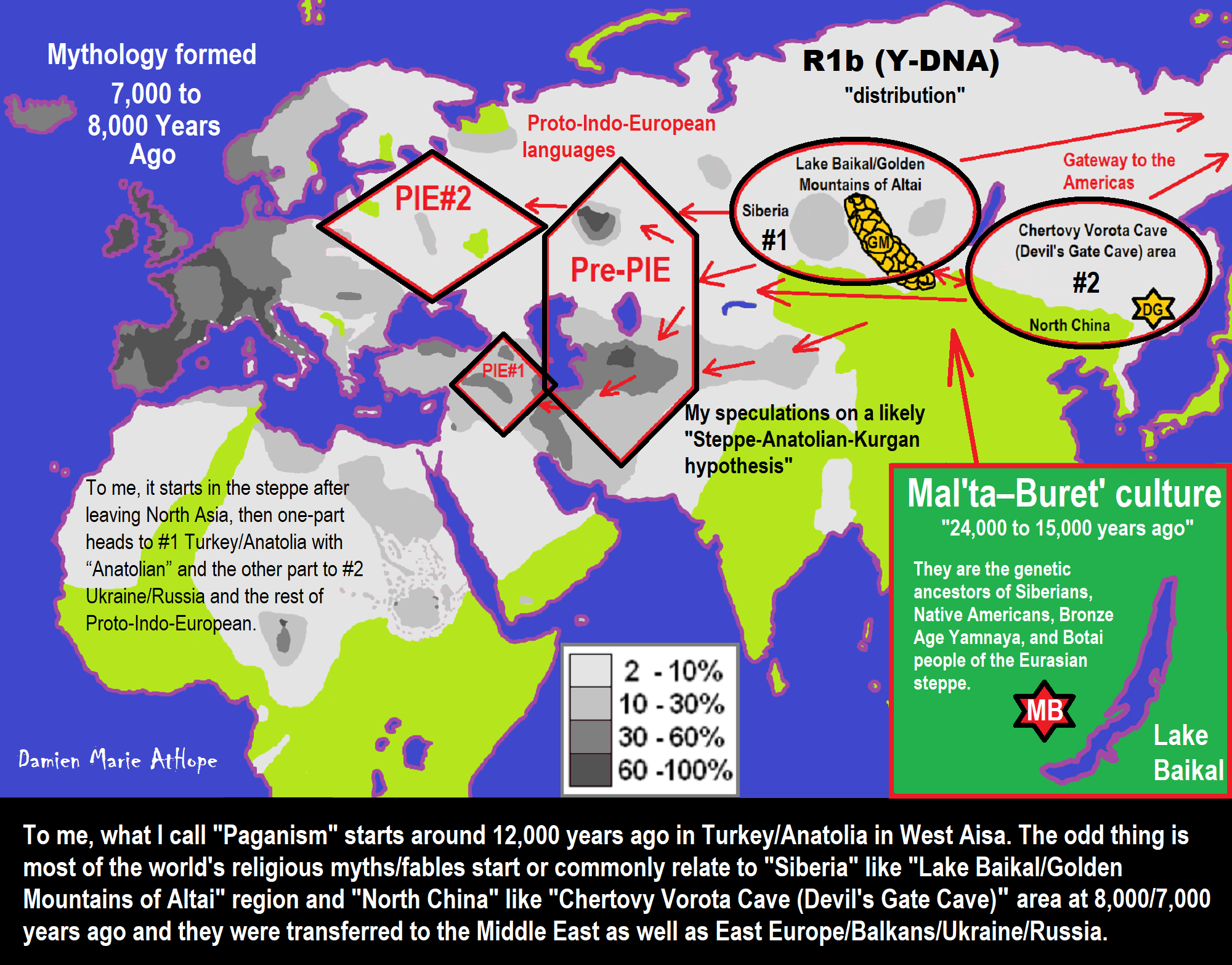
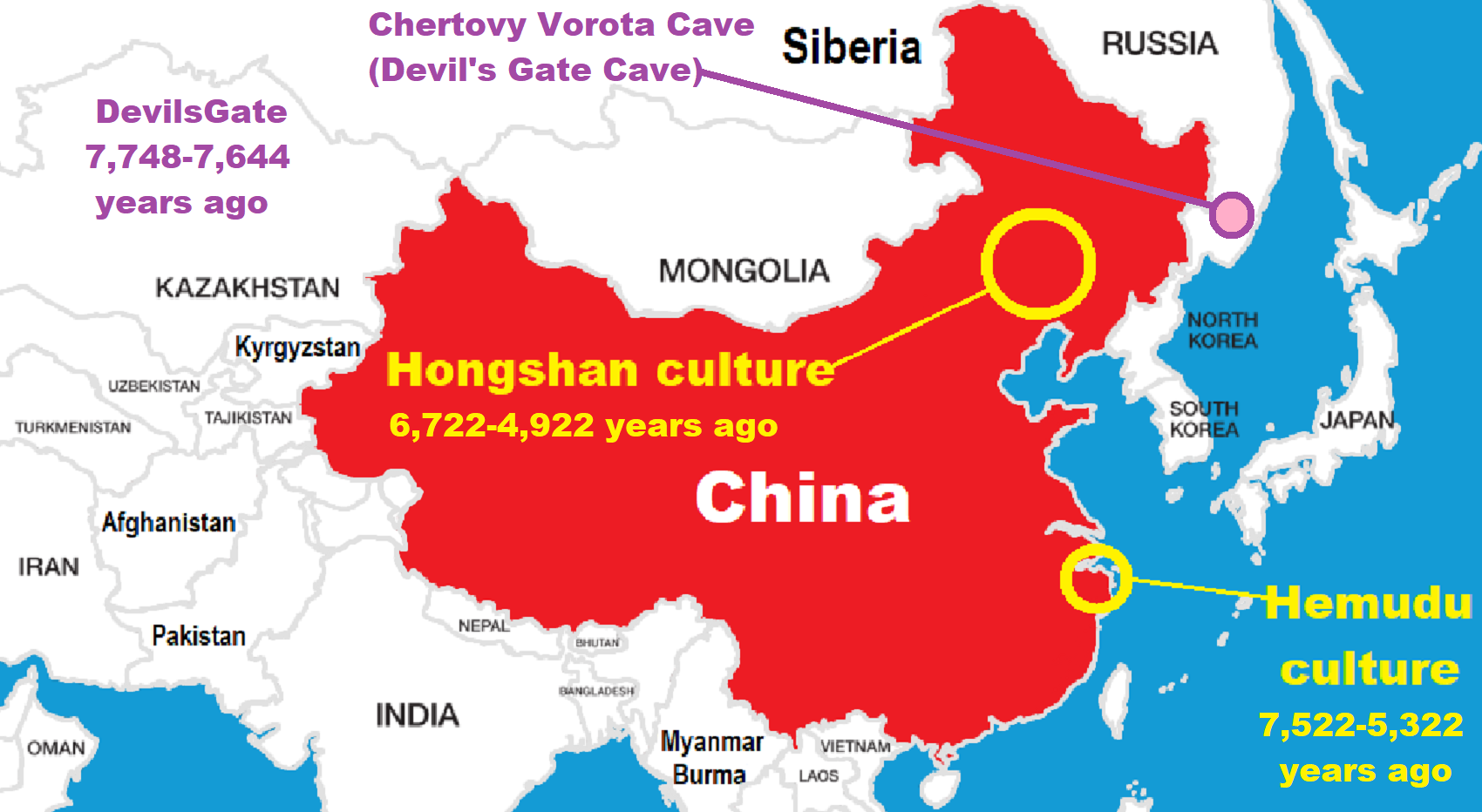
“Dené–Yeniseian language, Old Copper Complex, and Pre-Columbian Mound Builders?
Evolution of human skin color, white-skin is really under 10,000 years old?
Ideas, Technology and People from Turkey, Europe, to China and Back again 9,000 to 5,000 years ago?
White (light complexion skin) Bigotry and Sexism started 7,000 years ago?
Less Imperialism Worship in Prehistory/History, PLEASE
HISTORY OF CHINA relates to the History of Europe?
7,000 years of Class Conflict, Class War Struggle Ain’t Nothing New!
Sacred Mounds, Mountains, Kurgans, and Pyramids may hold deep connections?
Complex rituals for elite, seen from China to Egypt around 5,000 years ago
Horse Worship/Sacrifice: mythical union of Ruling Elite/Kingship and the Horse
Mythology, a Lunar Deity is a Goddess or God of the Moon
Myths and Folklore: “Trickster gods and goddesses”
Sacred Shit and Sacred Animals?
My “Steppe-Anatolian-Kurgan hypothesis”
My Thoughts on Possible Migrations of “R” DNA and Proto-Indo-European?
Trinity Evolution Started over 30,000 years ago, Maybe?
Sifting through the relation of Bird spirits/deities of the sky (20,000 to 5,000 years ago)
Are the Natufians of Israel around 15,000 to 11,500 years ago who you thought they were?
Crecganford @crecganford offers history & stories of the people, places, gods, & culture
I want to inspire all future leaders, we need you, and your wisdom. I am for equality, so if leading is needed, all skilled at leading positively should head the call of leading, whether intersex, trans, cis woman or man, all of us are of value, and we rise by helping each other.
“Paganism = belief in alternative gods that dont exist” – Commenter
My response, Actually, that sounds more like moralistic or monotheistic gods of the state. To me, such gods are a creation of power and control to benefit kings and elite and make slavery and way a religio-state issue as early god-king states did often. My point is both a kind of joke and a statement that to me, moralistic and monotheistic gods loving slavery and kings or war are not actual gods of paganism originally but reconceived or state created gods to support statism and kings right to rule, all added bullshit by masters.
Judge vs Value
Value “you”, then value others, you matter, and anyone not ok with that “seem” to not value your self-mastery, or your dignity to live, and express them. If this bothers others on our mattering and human rights, then one wonders if they are actually good in our lives. I strive to add my joy into the lives of others as joy is a feeling, not a place.
Reason is not a one-time doorway but a step further in our journey.
The door to “Reason” opens not once but many times. And “Reason” is a revolutionary process, as it requires a change to what is “Reason,” over what is desired by its user to work well.
My political thinking is humanity first, fighting for strong human rights, to stop all the wrongs.
“One Day”
One day we will be humanity, free of the shackles of separation. One day we will be free of the dark postcards of the past written in the suffering and hate of others. One day we will aspire past the strangling grip of bigotry, racism, sexism, homophobia, classism, xenophobia, ethnocentrism, and egocentrism that removes the humanism from the greatness available to humans. May I not be a silent watcher of such travesty but a champion of the possibility of change. May we all rise to the lofty goals of true human flourishing and live as one. I hold my heart high hoping for that one day when the love of unity will be who we are as humanity, free from the shackles of hate that now so easily separate and enslave us.
Realize value in life: Life is short but not as short as the times we smile or laugh, and even shorter are the times our heart smiles or we are filled with bliss, love, and joy. Good must have Bad? I was asked by a believer if I agreed that to value good we had to know or have bad. I reject this completely you don’t have to get punched to know the value of a hug. Nor would you add pain and suffering to a child to ensure that they valued love or joy.
Religion is a toxic substance to one’s self-mastery as it demands you rely on “it” as a subordinate, not to empower yourself.
I never read a book on logic but I am smarter even without them. I invent new thinking out of pure reason and experience. Reason is my only master. You want me to consider your ideas fairly, openly, and honestly. That is the only way, I strive to view everything. How about you? Is truth before your EGO?
Someone asked if I was a scientist due to the quality of my thinking, the same has been assumed before but for different skills, like a college professor, or classic trained philosopher, but no, my BA in college was for psychology, with some sociology.
I strive to stay open to the counsel of others, sometimes I agree with others’ ideas, sometimes I don’t, and always, truth-dependent beliefs are my goal.
I strive to attack ideas and not people as it is the people, themselves I aim to get on my side, so we together can fight their belief’s inaccuracies. Thus navigating truth claims accurately, understanding that which is worthy to call truth, is all that is championed or believed.
I know, almost it all, in a big picture way, religion is cultural stories, nothing more, is all false and I explain the evolution of it all in my art, videos, and blogs. I am the best on the evolution of religion in pre-history from at least from 100,000 to 5,000 years ago.
Humanity is harmed by class separations, we are all one! Stop seeing with eyes of difference/hate. Some are hardly bothered to care, showing clearly their entitlement to not be forced by life to have little choice but to care. How ego-driven are we, to not see the need of others?
And think others sometimes think I am bad for not knowing more about the Bible or another Holy book, and I think bad of others for not knowing that more than the Bible or another Holy book, when it comes to prehistoric religions… lol
Many others hope, it seems, for an “outer revolution” to happen to break capitalism but I know the break will first come mentally when one reaches self-mastery, an “inner revolution” happens and this, a WORLD of self-leadership, is what will help to break capitalism.
I have been homeless needing any handout. So, I feel compelled now to fight for them first, the ones dying right now, and are on the last hope. We rise by helping each other. I am real as shit. I actually was doing shitty inside, even feeling as if I was drowning and powerless. I see it is not power but purpose, passion, and compassion, this is our call to freedom. Our own self-mastery, a Mental Revolution.
I want to change the world leave it a better place than I found it as others do, the great thing is to me we all do because a movement is not a single person. Some look at their contribution and are disheartened believing they will not really matter. Your contribution matters!
Remember I was not always kind, it is a choice I make, to show the highest value of my honor. I am a high-functioning sociopath and am arrogant. I don’t doubt myself. It is more like I have to work to listen to others and care about others that deeply. I was experienced extreme child abuse and thus turned sociopath as a result. So a bad PTSD and its related type issues.
Many other philosophers are born of privilege, safety, and comfort. I had not one of these, I was unwanted, the hated, and the despised. I made my mind fast on the streets of southern California where I had to navigate gangs, police, and society at large displeased with my life.
I don’t value intelligence above kindness, because how smart can you be if kindness is something you are not wise enough to grasp, such as the deep value kindness holds to humanity, or how much its addition can change lives. I always think, of any mean people, how smart can they be, if they are not wise enough to see the beauty of kindness?
We often need to strive to stop demanding others think like us, explain it, thoughtfully as one to a friend. Then let truth win. And live in a way so different. so positive to humanity, others become interested to learn more, safety first, even in ideas, it seems for many people. Archaeology is our hope to a better future by exposing the past, if only we learn from it. Religion is provable as all Culture.
I see the hope in others as much as our faults. I will not let the world divide me. I am just gangbanging for humanity, a worrier of kindness. I am a proud anarchy theorist, I breathe the fire of the heathens, a thought revolutionary and mental freedom fighter. I am a humanist atheist who desires a better world for us all, one that is kinder, more just, and more rational in its pursuits.
If your socialism is so weak that voting to help in the here and now, threatens it, you don’t have my socialism, as no capitalism, no matter how gilded, threatens my socialism, as it shines strong with humanity, so bright all can see its hope. Humbly, I face the weight of my human limitations, and tell them to go to hell, do they not know who I am? I am mental dynamite, I thought you KNEW.
Why should we ever value people differently, simply because of what patch of earth they inhabit? What would make your value different as a human, simply due to an imaginary cultural construct of separation called national identity or borderlines imposed by states or countries?
I believe in your inner power, to rise strong, in your own self-mastery.
May we ALL unite AS ONE to smash capitalism and class society!
You, me, everyone is a needed part of the solution!
I don’t chat, so don’t send me messages to chat. I am only open to doing recorded videos and only on a time and date convent to me and only set up in advance and only with my show partner Cory @Skepticallefty joining in.
We have heroes who hunger for humanity and ghouls that gouge humanity, hungering for greed…
I strive to stand strong on the side of humanity with all I can, and ask You, “Where do you stand in this war of all humanity against greed, that needs economic justice for all?”
People need to realize that the end of capitalism will not be a one-time event, nor will the revolution be a one-time event. Keep doing what is needed, and inspire others. Solidarity to save the world!
All art by Damien Marie AtHope is shared for free, noncommercially, for education and teaching only.
I have been posting prehistory-themed art on my website for free from its conception, and it was meant to stay that way as I wanted to offer free education to help all people, including those of little means in the way of wealth and money. I do this for several reasons one, I am a revolutionary anarchist socialist and believe education should be free to enlighten others and aid in humanity’s emancipation. I once was ignorant and uninformed, and it was education that helped me free myself. Also, I enjoy helping others think more deeply thus, many of my prehistory art put different things or information together to aid in new thinking insights and learning. I want to inspire a revolution of new thinking about the past and use are to help in this endeavor. My art is sourced from several different places, and I try to provide the link to them as well.
I post art to aid in teaching and education or to inspire research. I believed all my art to be “fair use” and was before also planning on adding hundreds of my art to my book on prehistory (commercially), I have been working and reworking for years this book and had used both copyrighted and noncopyrighted pictures but was attempting to do so under what I believed was “fair use.” I strived to add links to provide fair attribution to the amount of original work used, but after reaching more into the subjective “fair use” in U.S. copyright law, I am unsure of how the status of my art would be received in some of it if used for commercial uses like in my prehistory book. A book I began researching for starting in 2006 as I often tried to stick close to the factual images or maps, wanting not just to make stuff up in relation to facts; when trying to teach prehistory, I am unsure if it is safe enough for use commercially.
Thus due to my not knowing if I did enough on some of my prehistory art, safe enough for use commercially, I will not be adding any of my art for commercial uses to my book as I would rather stay safe on more protected grounds of “fair use” just posting it in my blog or website for free as teaching, education, or to inspire research as I have non-commercially, and don’t want to be somehow sued for trying to use it commercially. So am just providing my art of others’ art, pictures, and maps non-commercially, I also strived to incorporate the copyrighted image into what I assume is a “transformative work” as well as “fair use” both because I am using it non-commercially and because I will not be using them for profit through my book commercially. It is a sad thing to feel I can not safely use this art commercially, but I have to try not to get into trouble with the law. If others feel I did enough to succeed at fair use, even if used commercially, I am sure some others may think differently, so I am trying to avoid the trouble by only sharing them free non-commercially with attribution.
I appreciate your interest in my art, and I hope it inspires new thinking in you and others. We rise by helping each other.
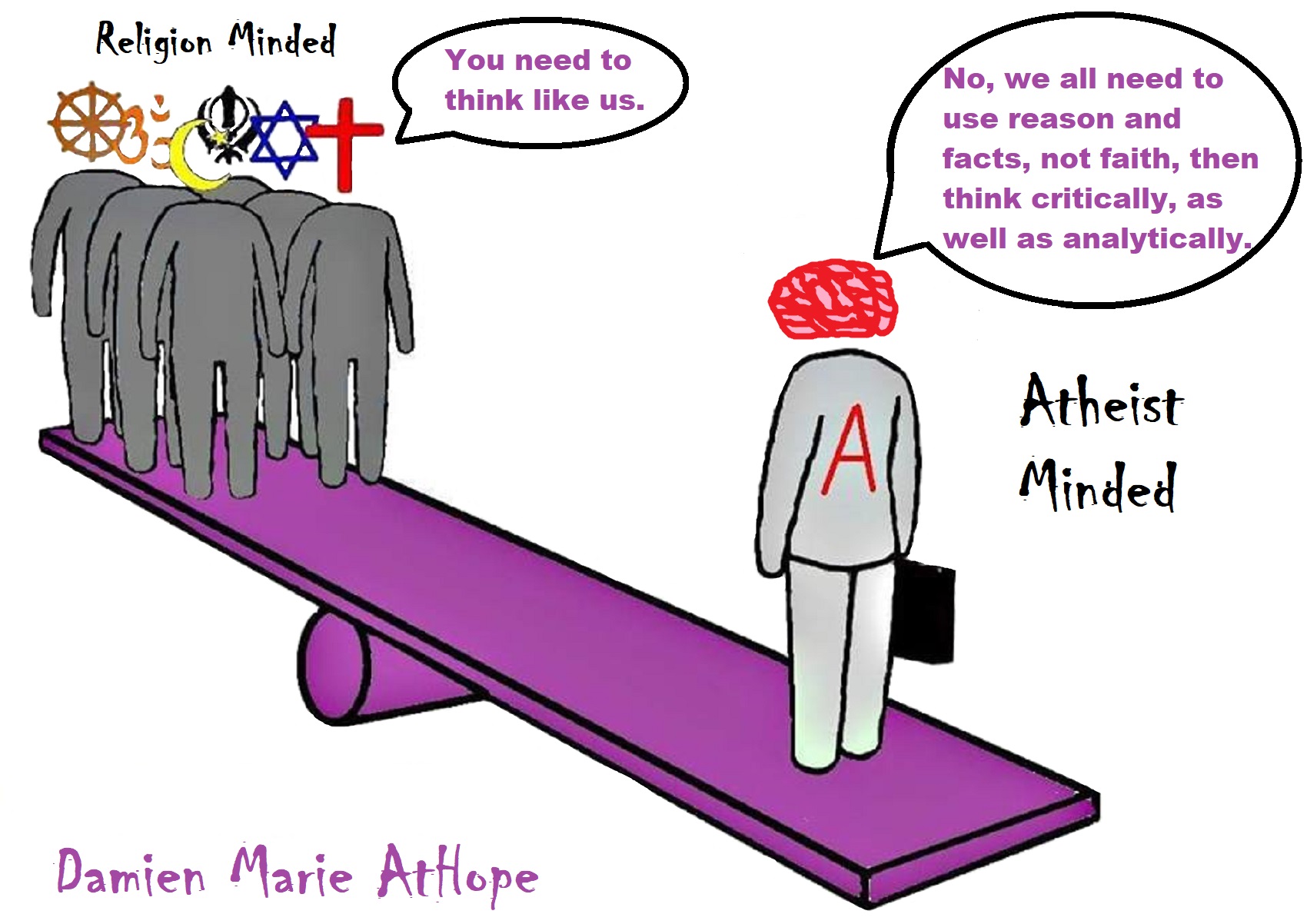

People don’t commonly teach religious history, even that of their own claimed religion. No, rather they teach a limited “pro their religion” history of their religion from a religious perspective favorable to the religion of choice.

Do you truly think “Religious Belief” is only a matter of some personal choice?
Do you not see how coercive one’s world of choice is limited to the obvious hereditary belief, in most religious choices available to the child of religious parents or caregivers? Religion is more commonly like a family, culture, society, etc. available belief that limits the belief choices of the child and that is when “Religious Belief” is not only a matter of some personal choice and when it becomes hereditary faith, not because of the quality of its alleged facts or proposed truths but because everyone else important to the child believes similarly so they do as well simply mimicking authority beliefs handed to them. Because children are raised in religion rather than being presented all possible choices but rather one limited dogmatic brand of “Religious Belief” where children only have a choice of following the belief as instructed, and then personally claim the faith hereditary belief seen in the confirming to the belief they have held themselves all their lives. This is obvious in statements asked and answered by children claiming a faith they barely understand but they do understand that their family believes “this or that” faith, so they feel obligated to believe it too. While I do agree that “Religious Belief” should only be a matter of some personal choice, it rarely is… End Hereditary Religion!

Animism: Respecting the Living World by Graham Harvey
“How have human cultures engaged with and thought about animals, plants, rocks, clouds, and other elements in their natural surroundings? Do animals and other natural objects have a spirit or soul? What is their relationship to humans? In this new study, Graham Harvey explores current and past animistic beliefs and practices of Native Americans, Maori, Aboriginal Australians, and eco-pagans. He considers the varieties of animism found in these cultures as well as their shared desire to live respectfully within larger natural communities. Drawing on his extensive casework, Harvey also considers the linguistic, performative, ecological, and activist implications of these different animisms.” ref

We are like believing machines we vacuum up ideas, like Velcro sticks to almost everything. We accumulate beliefs that we allow to negatively influence our lives, often without realizing it. Our willingness must be to alter skewed beliefs that impend our balance or reason, which allows us to achieve new positive thinking and accurate outcomes.

My thoughts on Religion Evolution with external links for more info:
- (Pre-Animism Africa mainly, but also Europe, and Asia at least 300,000 years ago), (Pre-Animism – Oxford Dictionaries)
- (Animism Africa around 100,000 years ago), (Animism – Britannica.com)
- (Totemism Europe around 50,000 years ago), (Totemism – Anthropology)
- (Shamanism Siberia around 30,000 years ago), (Shamanism – Britannica.com)
- (Paganism Turkey around 12,000 years ago), (Paganism – BBC Religion)
- (Progressed Organized Religion “Institutional Religion” Egypt around 5,000 years ago), (Ancient Egyptian Religion – Britannica.com)
- (CURRENT “World” RELIGIONS after 4,000 years ago) (Origin of Major Religions – Sacred Texts)
- (Early Atheistic Doubting at least by 2,600 years ago) (History of Atheism – Wikipedia)
“Religion is an Evolved Product” and Yes, Religion is Like Fear Given Wings…
Atheists talk about gods and religions for the same reason doctors talk about cancer, they are looking for a cure, or a firefighter talks about fires because they burn people and they care to stop them. We atheists too often feel a need to help the victims of mental slavery, held in the bondage that is the false beliefs of gods and the conspiracy theories of reality found in religions.
Understanding Religion Evolution:
- Pre-Animism (at least 300,000 years ago)
- Animism (Africa: 100,000 years ago)
- Totemism (Europe: 50,000 years ago)
- Shamanism (Siberia: 30,000 years ago)
- Paganism (Turkey: 12,000 years ago)
- Progressed organized religion (Egypt: 5,000 years ago), (Egypt, the First Dynasty 5,150 years ago)
- CURRENT “World” RELIGIONS (after 4,000 years ago)
- Early Atheistic Doubting (at least by 2,600 years ago)
“An Archaeological/Anthropological Understanding of Religion Evolution”
It seems ancient peoples had to survived amazing threats in a “dangerous universe (by superstition perceived as good and evil),” and human “immorality or imperfection of the soul” which was thought to affect the still living, leading to ancestor worship. This ancestor worship presumably led to the belief in supernatural beings, and then some of these were turned into the belief in gods. This feeble myth called gods were just a human conceived “made from nothing into something over and over, changing, again and again, taking on more as they evolve, all the while they are thought to be special,” but it is just supernatural animistic spirit-belief perceived as sacred.
Quick Evolution of Religion?
Pre-Animism (at least 300,000 years ago) pre-religion is a beginning that evolves into later Animism. So, Religion as we think of it, to me, all starts in a general way with Animism (Africa: 100,000 years ago) (theoretical belief in supernatural powers/spirits), then this is physically expressed in or with Totemism (Europe: 50,000 years ago) (theoretical belief in mythical relationship with powers/spirits through a totem item), which then enlists a full-time specific person to do this worship and believed interacting Shamanism (Siberia/Russia: 30,000 years ago) (theoretical belief in access and influence with spirits through ritual), and then there is the further employment of myths and gods added to all the above giving you Paganism (Turkey: 12,000 years ago) (often a lot more nature-based than most current top world religions, thus hinting to their close link to more ancient religious thinking it stems from). My hypothesis is expressed with an explanation of the building of a theatrical house (modern religions development). Progressed organized religion (Egypt: 5,000 years ago) with CURRENT “World” RELIGIONS (after 4,000 years ago).
Historically, in large city-state societies (such as Egypt or Iraq) starting around 5,000 years ago culminated to make religion something kind of new, a sociocultural-governmental-religious monarchy, where all or at least many of the people of such large city-state societies seem familiar with and committed to the existence of “religion” as the integrated life identity package of control dynamics with a fixed closed magical doctrine, but this juggernaut integrated religion identity package of Dogmatic-Propaganda certainly did not exist or if developed to an extent it was highly limited in most smaller prehistoric societies as they seem to lack most of the strong control dynamics with a fixed closed magical doctrine (magical beliefs could be at times be added or removed). Many people just want to see developed religious dynamics everywhere even if it is not. Instead, all that is found is largely fragments until the domestication of religion.
Religions, as we think of them today, are a new fad, even if they go back to around 6,000 years in the timeline of human existence, this amounts to almost nothing when seen in the long slow evolution of religion at least around 70,000 years ago with one of the oldest ritual worship. Stone Snake of South Africa: “first human worship” 70,000 years ago. This message of how religion and gods among them are clearly a man-made thing that was developed slowly as it was invented and then implemented peace by peace discrediting them all. Which seems to be a simple point some are just not grasping how devastating to any claims of truth when we can see the lie clearly in the archeological sites.
I wish people fought as hard for the actual values as they fight for the group/clan names political or otherwise they think support values. Every amount spent on war is theft to children in need of food or the homeless kept from shelter.
Here are several of my blog posts on history:
- To Find Truth You Must First Look
- (Magdalenian/Iberomaurusian) Connections to the First Paganists of the early Neolithic Near East Dating from around 17,000 to 12,000 Years Ago
- Natufians: an Ancient People at the Origins of Agriculture and Sedentary Life
- Possible Clan Leader/Special “MALE” Ancestor Totem Poles At Least 13,500 years ago?
- Jewish People with DNA at least 13,200 years old, Judaism, and the Origins of Some of its Ideas
- Baltic Reindeer Hunters: Swiderian, Lyngby, Ahrensburgian, and Krasnosillya cultures 12,020 to 11,020 years ago are evidence of powerful migratory waves during the last 13,000 years and a genetic link to Saami and the Finno-Ugric peoples.
- The Rise of Inequality: patriarchy and state hierarchy inequality
- Fertile Crescent 12,500 – 9,500 Years Ago: fertility and death cult belief system?
- 12,400 – 11,700 Years Ago – Kortik Tepe (Turkey) Pre/early-Agriculture Cultic Ritualism
- Ritualistic Bird Symbolism at Gobekli Tepe and its “Ancestor Cult”
- Male-Homosexual (female-like) / Trans-woman (female) Seated Figurine from Gobekli Tepe
- Could a 12,000-year-old Bull Geoglyph at Göbekli Tepe relate to older Bull and Female Art 25,000 years ago and Later Goddess and the Bull cults like Catal Huyuk?
- Sedentism and the Creation of goddesses around 12,000 years ago as well as male gods after 7,000 years ago.
- Alcohol, where Agriculture and Religion Become one? Such as Gobekli Tepe’s Ritualistic use of Grain as Food and Ritual Drink
- Neolithic Ritual Sites with T-Pillars and other Cultic Pillars
- Paganism: Goddesses around 12,000 years ago then Male Gods after 7,000 years ago
- First Patriarchy: Split of Women’s Status around 12,000 years ago & First Hierarchy: fall of Women’s Status around 5,000 years ago.
- Natufians: an Ancient People at the Origins of Agriculture and Sedentary Life
- J DNA and the Spread of Agricultural Religion (paganism)
- Paganism: an approximately 12,000-year-old belief system
- Paganism 12,000 years old: related to “Anarchism and Socialism” (Pre-Capitalism)
- Shaman burial in Israel 12,000 years ago and the Shamanism Phenomena
- Need to Mythicized: gods and goddesses
- 12,000 – 7,000 Years Ago – Paleo-Indian Culture (The Americas)
- 12,000 – 2,000 Years Ago – Indigenous-Scandinavians (Nordic)
- Norse did not wear helmets with horns?
- Pre-Pottery Neolithic Skull Cult around 11,500 to 8,400 Years Ago?
- 10,400 – 10,100 Years Ago, in Turkey the Nevail Cori Religious Settlement
- 9,000-6,500 Years Old Submerged Pre-Pottery/Pottery Neolithic Ritual Settlements off Israel’s Coast
- Catal Huyuk “first religious designed city” around 9,500 to 7,700 years ago (Turkey)
- Cultic Hunting at Catal Huyuk “first religious designed city”
- Special Items and Art as well as Special Elite Burials at Catal Huyuk
- New Rituals and Violence with the appearance of Pottery and People?
- Haplogroup N and its related Uralic Languages and Cultures
- Ainu people, Sámi people, Native Americans, the Ancient North Eurasians, and Paganistic-Shamanism with Totemism
- Ideas, Technology and People from Turkey, Europe, to China and Back again 9,000 to 5,000 years ago?
- First Pottery of Europe and the Related Cultures
- 9,000 years old Neolithic Artifacts Judean Desert and Hills Israel
- 9,000-7,000 years-old Sex and Death Rituals: Cult Sites in Israel, Jordan, and the Sinai
- 9,000-8500 year old Horned Female shaman Bad Dürrenberg Germany
- Neolithic Jewelry and the Spread of Farming in Europe Emerging out of West Turkey
- 8,600-year-old Tortoise Shells in Neolithic graves in central China have Early Writing and Shamanism
- Swing of the Mace: the rise of Elite, Forced Authority, and Inequality begin to Emerge 8,500 years ago?
- Migrations and Changing Europeans Beginning around 8,000 Years Ago
- My “Steppe-Anatolian-Kurgan hypothesis” 8,000/7,000 years ago
- Around 8,000-year-old Shared Idea of the Mistress of Animals, “Ritual” Motif
- Pre-Columbian Red-Paint (red ochre) Maritime Archaic Culture 8,000-3,000 years ago
- 7,522-6,522 years ago Linear Pottery culture which I think relates to Arcane Capitalism’s origins
- Arcane Capitalism: Primitive socialism, Primitive capital, Private ownership, Means of production, Market capitalism, Class discrimination, and Petite bourgeoisie (smaller capitalists)
- 7,500-4,750 years old Ritualistic Cucuteni-Trypillian culture of Moldova, Romania, and Ukraine
- Roots of a changing early society 7,200-6,700 years ago Jordan and Israel
- Agriculture religion (Paganism) with farming reached Britain between about 7,000 to 6,500 or so years ago and seemingly expressed in things like Western Europe’s Long Barrows
- My Thoughts on Possible Migrations of “R” DNA and Proto-Indo-European?
- “Millet” Spreading from China 7,022 years ago to Europe and related Language may have Spread with it leading to Proto-Indo-European
- Proto-Indo-European (PIE), ancestor of Indo-European languages: DNA, Society, Language, and Mythology
- The Dnieper–Donets culture and Asian varieties of Millet from China to the Black Sea region of Europe by 7,022 years ago
- Kurgan 6,000 years ago/dolmens 7,000 years ago: funeral, ritual, and other?
- 7,020 to 6,020-year-old Proto-Indo-European Homeland of Urheimat or proposed home of their Language and Religion
- Ancient Megaliths: Kurgan, Ziggurat, Pyramid, Menhir, Trilithon, Dolman, Kromlech, and Kromlech of Trilithons
- The Mytheme of Ancient North Eurasian Sacred-Dog belief and similar motifs are found in Indo-European, Native American, and Siberian comparative mythology
- Elite Power Accumulation: Ancient Trade, Tokens, Writing, Wealth, Merchants, and Priest-Kings
- Sacred Mounds, Mountains, Kurgans, and Pyramids may hold deep connections?
- Between 7,000-5,000 Years ago, rise of unequal hierarchy elite, leading to a “birth of the State” or worship of power, strong new sexism, oppression of non-elites, and the fall of Women’s equal status
- Paganism 7,000-5,000 years old: related to “Anarchism and Socialism” (Capitalism) (World War 0) Elite & their slaves
- Hell and Underworld mythologies starting maybe as far back as 7,000 to 5,000 years ago with the Proto-Indo-Europeans?
- The First Expression of the Male God around 7,000 years ago?
- White (light complexion skin) Bigotry and Sexism started 7,000 years ago?
- Around 7,000-year-old Shared Idea of the Divine Bird (Tutelary and/or Trickster spirit/deity), “Ritual” Motif
- Nekhbet an Ancient Egyptian Vulture Goddess and Tutelary Deity
- 6,720 to 4,920 years old Ritualistic Hongshan Culture of Inner Mongolia with 5,000-year-old Pyramid Mounds and Temples
- First proto-king in the Balkans, Varna culture around 6,500 years ago?
- 6,500–5,800 years ago in Israel Late Chalcolithic (Copper Age) Period in the Southern Levant Seems to Express Northern Levant Migrations, Cultural and Religious Transfer
- KING OF BEASTS: Master of Animals “Ritual” Motif, around 6,000 years old or older…
- Around 6000-year-old Shared Idea of the Solid Wheel & the Spoked Wheel-Shaped Ritual Motif
- “The Ghassulian Star,” a mysterious 6,000-year-old mural from Jordan; a Proto-Star of Ishtar, Star of Inanna or Star of Venus?
- Religious/Ritual Ideas, including goddesses and gods as well as ritual mounds or pyramids from Northeastern Asia at least 6,000 years old, seemingly filtering to Iran, Iraq, the Mediterranean, Europe, Egypt, and the Americas?
- Maykop (5,720–5,020 years ago) Caucasus region Bronze Age culture-related to Copper Age farmers from the south, influenced by the Ubaid period and Leyla-Tepe culture, as well as influencing the Kura-Araxes culture
- 5-600-year-old Tomb, Mummy, and First Bearded Male Figurine in a Grave
- Kura-Araxes Cultural 5,520 to 4,470 years old DNA traces to the Canaanites, Arabs, and Jews
- Minoan/Cretan (Keftiu) Civilization and Religion around 5,520 to 3,120 years ago
- Evolution Of Science at least by 5,500 years ago
- 5,500 Years old birth of the State, the rise of Hierarchy, and the fall of Women’s status
- “Jiroft culture” 5,100 – 4,200 years ago and the History of Iran
- Stonehenge: Paganistic Burial and Astrological Ritual Complex, England (5,100-3,600 years ago)
- Around 5,000-year-old Shared Idea of the “Tree of Life” Ritual Motif
- Complex rituals for elite, seen from China to Egypt, at least by 5,000 years ago
- Around 5,000 years ago: “Birth of the State” where Religion gets Military Power and Influence
- The Center of the World “Axis Mundi” and/or “Sacred Mountains” Mythology Could Relate to the Altai Mountains, Heart of the Steppe
- Progressed organized religion starts, an approximately 5,000-year-old belief system
- China’s Civilization between 5,000-3,000 years ago, was a time of war and class struggle, violent transition from free clans to a Slave or Elite society
- Origin of Logics is Naturalistic Observation at least by around 5,000 years ago.
- Paganism 5,000 years old: progressed organized religion and the state: related to “Anarchism and Socialism” (Kings and the Rise of the State)
- Ziggurats (multi-platform temples: 4,900 years old) to Pyramids (multi-platform tombs: 4,700 years old)
- Did a 4,520–4,420-year-old Volcano In Turkey Inspire the Bible God?
- Finland’s Horned Shaman and Pre-Horned-God at least 4,500 years ago?
- 4,000-year-Old Dolmens in Israel: A Connected Dolmen Religious Phenomenon?
- Creation myths: From chaos, Ex nihilo, Earth-diver, Emergence, World egg, and World parent
- Bronze Age “Ritual” connections of the Bell Beaker culture with the Corded Ware/Single Grave culture, which were related to the Yamnaya culture and Proto-Indo-European Languages/Religions
- Low Gods (Earth/ Tutelary deity), High Gods (Sky/Supreme deity), and Moralistic Gods (Deity enforcement/divine order)
- The exchange of people, ideas, and material-culture including, to me, the new god (Sky Father) and goddess (Earth Mother) religion between the Cucuteni-Trypillians and others which is then spread far and wide
- Koryaks: Indigenous People of the Russian Far East and Big Raven myths also found in Tlingit, Haida, Tsimshian, and other Indigenous People of North America
- 42 Principles Of Maat (Egyptian Goddess of the justice) around 4,400 years ago, 2000 Years Before Ten Commandments
- “Happy Easter” Well Happy Eostre/Ishter
- 4,320-3,820 years old “Shimao” (North China) site with Totemistic-Shamanistic Paganism and a Stepped Pyramid
- 4,250 to 3,400 Year old Stonehenge from Russia: Arkaim?
- 4,100-year-old beaker with medicinal & flowering plants in a grave of a woman in Scotland
- Early European Farmer ancestry, Kelif el Boroud people with the Cardial Ware culture, and the Bell Beaker culture Paganists too, spread into North Africa, then to the Canary Islands off West Africa
- Flood Accounts: Gilgamesh epic (4,100 years ago) Noah in Genesis (2,600 years ago)
- Paganism 4,000 years old: related to “Anarchism and Socialism” (First Moralistic gods, then the Origin time of Monotheism)
- When was the beginning: TIMELINE OF CURRENT RELIGIONS, which start around 4,000 years ago.
- Early Religions Thought to Express Proto-Monotheistic Systems around 4,000 years ago
- Kultepe? An archaeological site with a 4,000 years old women’s rights document.
- Single God Religions (Monotheism) = “Man-o-theism” started around 4,000 years ago with the Great Sky Spirit/God Tiān (天)?
- Confucianism’s Tiān (Shangdi god 4,000 years old): Supernaturalism, Pantheism or Theism?
- Yes, Your Male God is Ridiculous
- Mythology, a Lunar Deity is a Goddess or God of the Moon
- Sacred Land, Hills, and Mountains: Sami Mythology (Paganistic Shamanism)
- Horse Worship/Sacrifice: mythical union of Ruling Elite/Kingship and the Horse
- The Amorite/Amurru people’s God Amurru “Lord of the Steppe”, relates to the Origins of the Bible God?
- Bronze Age Exotic Trade Routes Spread Quite Far as well as Spread Religious Ideas with Them
- Sami and the Northern Indigenous Peoples Landscape, Language, and its Connection to Religion
- Prototype of Ancient Analemmatic Sundials around 3,900-3,150 years ago and a Possible Solar Connection to gods?
- Judaism is around 3,450 or 3,250 years old. (“Paleo-Hebrew” 3,000 years ago and Torah 2,500 years ago)
- The Weakening of Ancient Trade and the Strengthening of Religions around 3000 years ago?
- Are you aware that there are religions that worship women gods, explain now religion tears women down?
- Animistic, Totemistic, and Paganistic Superstition Origins of bible god and the bible’s Religion.
- Myths and Folklore: “Trickster gods and goddesses”
- Jews, Judaism, and the Origins of Some of its Ideas
- An Old Branch of Religion Still Giving Fruit: Sacred Trees
- Dating the BIBLE: naming names and telling times (written less than 3,000 years ago, provable to 2,200 years ago)
- Did a Volcano Inspire the bible god?
- Dené–Yeniseian language, Old Copper Complex, and Pre-Columbian Mound Builders?
- No “dinosaurs and humans didn’t exist together just because some think they are in the bible itself”
- Sacred Shit and Sacred Animals?
- Everyone Killed in the Bible Flood? “Nephilim” (giants)?
- Hey, Damien dude, I have a question for you regarding “the bible” Exodus.
- Archaeology Disproves the Bible
- Bible Battle, Just More, Bible Babble
- The Jericho Conquest lie?
- Canaanites and Israelites?
- Accurate Account on how did Christianity Began?
- Let’s talk about Christianity.
- So the 10 commandments isn’t anything to go by either right?
- Misinformed christian
- Debunking Jesus?
- Paulism vs Jesus
- Ok, you seem confused so let’s talk about Buddhism.
- Unacknowledged Buddhism: Gods, Savior, Demons, Rebirth, Heavens, Hells, and Terrorism
- His Foolishness The Dalai Lama
- Yin and Yang is sexist with an ORIGIN around 2,300 years ago?
- I Believe Archaeology, not Myths & Why Not, as the Religious Myths Already Violate Reason!
- Archaeological, Scientific, & Philosophic evidence shows the god myth is man-made nonsense.
- Aquatic Ape Theory/Hypothesis? As Always, Just Pseudoscience.
- Ancient Aliens Conspiracy Theorists are Pseudohistorians
- The Pseudohistoric and Pseudoscientific claims about “Bakoni Ruins” of South Africa
- Why do people think Religion is much more than supernaturalism and superstitionism?
- Religion is an Evolved Product
- Was the Value of Ancient Women Different?
- 1000 to 1100 CE, human sacrifice Cahokia Mounds a pre-Columbian Native American site
- Feminist atheists as far back as the 1800s?
- Promoting Religion as Real is Mentally Harmful to a Flourishing Humanity
- Screw All Religions and Their Toxic lies, they are all fraud
- Forget Religions’ Unfounded Myths, I Have Substantiated “Archaeology Facts.”
- Religion Dispersal throughout the World
- I Hate Religion Just as I Hate all Pseudoscience
- Exposing Scientology, Eckankar, Wicca and Other Nonsense?
- Main deity or religious belief systems
- Quit Trying to Invent Your God From the Scraps of Science.
- Archaeological, Scientific, & Philosophic evidence shows the god myth is man-made nonsense.
- Ancient Alien Conspiracy Theorists: Misunderstanding, Rhetoric, Misinformation, Fabrications, and Lies
- Misinformation, Distortion, and Pseudoscience in Talking with a Christian Creationist
- Judging the Lack of Goodness in Gods, Even the Norse God Odin
- Challenging the Belief in God-like Aliens and Gods in General
- A Challenge to Christian use of Torture Devices?
- Yes, Hinduism is a Religion
- Trump is One of the Most Reactionary Forces of Far-right Christian Extremism
- Was the Bull Head a Symbol of God? Yes!
- Primate Death Rituals
- Christian – “God and Christianity are objectively true”
- Australopithecus afarensis Death Ritual?
- You Claim Global Warming is a Hoax?
- Doubter of Science and Defamer of Atheists?
- I think that sounds like the Bible?
- History of the Antifa (“anti-fascist”) Movements
- Indianapolis Anti-Blasphemy Laws #Free Soheil Rally
- Damien, you repeat the golden rule in so many forms then you say religion is dogmatic?
- Science is a Trustable Methodology whereas Faith is not Trustable at all!
- Was I ever a believer, before I was an atheist?
- Atheists rise in reason
- Mistrust of science?
- Open to Talking About the Definition of ‘God’? But first, we address Faith.
- ‘United Monarchy’ full of splendor and power – Saul, David, and Solomon? Most likely not.
- Is there EXODUS ARCHAEOLOGY? The short answer is “no.”
- Lacking Proof of Bigfoots, Unicorns, and Gods is Just a Lack of Research?
- Religion and Politics: Faith Beliefs vs. Rational Thinking
- Hammer of Truth that lying pig RELIGION: challenged by an archaeologist
- “The Hammer of Truth” -ontology question- What do You Mean by That?
- Navigation of a bad argument: Ad Hominem vs. Attack
- Why is it Often Claimed that Gods have a Gender?
- Why are basically all monotheistic religions ones that have a male god?
- Shifting through the Claims in support of Faith
- Dear Mr. AtHope, The 20th Century is an Indictment of Secularism and a Failed Atheist Century
- An Understanding of the Worldwide Statistics and Dynamics of Terrorist Incidents and Suicide Attacks
- Intoxication and Evolution? Addressing and Assessing the “Stoned Ape” or “Drunken Monkey” Theories as Catalysts in Human Evolution
- Sacred Menstrual cloth? Inanna’s knot, Isis knot, and maybe Ma’at’s feather?
- Damien, why don’t the Hebrews accept the bible stories?
- Dealing with a Troll and Arguing Over Word Meaning
- Knowledge without Belief? Justified beliefs or disbeliefs worthy of Knowledge?
- Afrocentrism and African Religions
- Crecganford @crecganford offers history & stories of the people, places, gods, & culture
- Empiricism-Denier?
I am not an academic. I am a revolutionary that teaches in public, in places like social media, and in the streets. I am not a leader by some title given but from my commanding leadership style of simply to start teaching everywhere to everyone, all manner of positive education.



To me, Animism starts in Southern Africa, then to West Europe, and becomes Totemism. Another split goes near the Russia and Siberia border becoming Shamanism, which heads into Central Europe meeting up with Totemism, which also had moved there, mixing the two which then heads to Lake Baikal in Siberia. From there this Shamanism-Totemism heads to Turkey where it becomes Paganism.





Not all “Religions” or “Religious Persuasions” have a god(s) but
All can be said to believe in some imaginary beings or imaginary things like spirits, afterlives, etc.

Paganism 12,000-4,000 years old
12,000-7,000 years old: related to (Pre-Capitalism)
7,000-5,000 years old: related to (Capitalism) (World War 0) Elite and their slaves!
5,000 years old: related to (Kings and the Rise of the State)
4,000 years old: related to (First Moralistic gods, then the Origin time of Monotheism)

ref, ref, ref, ref, ref, ref, ref, ref, ref, ref, ref, ref, ref, ref, ref, ref, ref, ref, ref, ref, ref
Low Gods “Earth” or Tutelary deity and High Gods “Sky” or Supreme deity
“An Earth goddess is a deification of the Earth. Earth goddesses are often associated with the “chthonic” deities of the underworld. Ki and Ninhursag are Mesopotamian earth goddesses. In Greek mythology, the Earth is personified as Gaia, corresponding to Roman Terra, Indic Prithvi/Bhūmi, etc. traced to an “Earth Mother” complementary to the “Sky Father” in Proto-Indo-European religion. Egyptian mythology exceptionally has a sky goddess and an Earth god.” ref
“A mother goddess is a goddess who represents or is a personification of nature, motherhood, fertility, creation, destruction or who embodies the bounty of the Earth. When equated with the Earth or the natural world, such goddesses are sometimes referred to as Mother Earth or as the Earth Mother. In some religious traditions or movements, Heavenly Mother (also referred to as Mother in Heaven or Sky Mother) is the wife or feminine counterpart of the Sky father or God the Father.” ref
“Any masculine sky god is often also king of the gods, taking the position of patriarch within a pantheon. Such king gods are collectively categorized as “sky father” deities, with a polarity between sky and earth often being expressed by pairing a “sky father” god with an “earth mother” goddess (pairings of a sky mother with an earth father are less frequent). A main sky goddess is often the queen of the gods and may be an air/sky goddess in her own right, though she usually has other functions as well with “sky” not being her main. In antiquity, several sky goddesses in ancient Egypt, Mesopotamia, and the Near East were called Queen of Heaven. Neopagans often apply it with impunity to sky goddesses from other regions who were never associated with the term historically. The sky often has important religious significance. Many religions, both polytheistic and monotheistic, have deities associated with the sky.” ref
“In comparative mythology, sky father is a term for a recurring concept in polytheistic religions of a sky god who is addressed as a “father”, often the father of a pantheon and is often either a reigning or former King of the Gods. The concept of “sky father” may also be taken to include Sun gods with similar characteristics, such as Ra. The concept is complementary to an “earth mother“. “Sky Father” is a direct translation of the Vedic Dyaus Pita, etymologically descended from the same Proto-Indo-European deity name as the Greek Zeûs Pater and Roman Jupiter and Germanic Týr, Tir or Tiwaz, all of which are reflexes of the same Proto-Indo-European deity’s name, *Dyēus Ph₂tḗr. While there are numerous parallels adduced from outside of Indo-European mythology, there are exceptions (e.g. In Egyptian mythology, Nut is the sky mother and Geb is the earth father).” ref
Tutelary deity
“A tutelary (also tutelar) is a deity or spirit who is a guardian, patron, or protector of a particular place, geographic feature, person, lineage, nation, culture, or occupation. The etymology of “tutelary” expresses the concept of safety and thus of guardianship. In late Greek and Roman religion, one type of tutelary deity, the genius, functions as the personal deity or daimon of an individual from birth to death. Another form of personal tutelary spirit is the familiar spirit of European folklore.” ref
“A tutelary (also tutelar) in Korean shamanism, jangseung and sotdae were placed at the edge of villages to frighten off demons. They were also worshiped as deities. Seonangshin is the patron deity of the village in Korean tradition and was believed to embody the Seonangdang. In Philippine animism, Diwata or Lambana are deities or spirits that inhabit sacred places like mountains and mounds and serve as guardians. Such as: Maria Makiling is the deity who guards Mt. Makiling and Maria Cacao and Maria Sinukuan. In Shinto, the spirits, or kami, which give life to human bodies come from nature and return to it after death. Ancestors are therefore themselves tutelaries to be worshiped. And similarly, Native American beliefs such as Tonás, tutelary animal spirit among the Zapotec and Totems, familial or clan spirits among the Ojibwe, can be animals.” ref
“A tutelary (also tutelar) in Austronesian beliefs such as: Atua (gods and spirits of the Polynesian peoples such as the Māori or the Hawaiians), Hanitu (Bunun of Taiwan‘s term for spirit), Hyang (Kawi, Sundanese, Javanese, and Balinese Supreme Being, in ancient Java and Bali mythology and this spiritual entity, can be either divine or ancestral), Kaitiaki (New Zealand Māori term used for the concept of guardianship, for the sky, the sea, and the land), Kawas (mythology) (divided into 6 groups: gods, ancestors, souls of the living, spirits of living things, spirits of lifeless objects, and ghosts), Tiki (Māori mythology, Tiki is the first man created by either Tūmatauenga or Tāne and represents deified ancestors found in most Polynesian cultures). ” ref, ref, ref, ref, ref, ref, ref
Mesopotamian Tutelary Deities can be seen as ones related to City-States
“Historical city-states included Sumerian cities such as Uruk and Ur; Ancient Egyptian city-states, such as Thebes and Memphis; the Phoenician cities (such as Tyre and Sidon); the five Philistine city-states; the Berber city-states of the Garamantes; the city-states of ancient Greece (the poleis such as Athens, Sparta, Thebes, and Corinth); the Roman Republic (which grew from a city-state into a vast empire); the Italian city-states from the Middle Ages to the early modern period, such as Florence, Siena, Ferrara, Milan (which as they grew in power began to dominate neighboring cities) and Genoa and Venice, which became powerful thalassocracies; the Mayan and other cultures of pre-Columbian Mesoamerica (including cities such as Chichen Itza, Tikal, Copán and Monte Albán); the central Asian cities along the Silk Road; the city-states of the Swahili coast; Ragusa; states of the medieval Russian lands such as Novgorod and Pskov; and many others.” ref
“The Uruk period (ca. 4000 to 3100 BCE; also known as Protoliterate period) of Mesopotamia, named after the Sumerian city of Uruk, this period saw the emergence of urban life in Mesopotamia and the Sumerian civilization. City-States like Uruk and others had a patron tutelary City Deity along with a Priest-King.” ref
“Chinese folk religion, both past, and present, includes myriad tutelary deities. Exceptional individuals, highly cultivated sages, and prominent ancestors can be deified and honored after death. Lord Guan is the patron of military personnel and police, while Mazu is the patron of fishermen and sailors. Such as Tu Di Gong (Earth Deity) is the tutelary deity of a locality, and each individual locality has its own Earth Deity and Cheng Huang Gong (City God) is the guardian deity of an individual city, worshipped by local officials and locals since imperial times.” ref
“A tutelary (also tutelar) in Hinduism, personal tutelary deities are known as ishta-devata, while family tutelary deities are known as Kuladevata. Gramadevata are guardian deities of villages. Devas can also be seen as tutelary. Shiva is the patron of yogis and renunciants. City goddesses include: Mumbadevi (Mumbai), Sachchika (Osian); Kuladevis include: Ambika (Porwad), and Mahalakshmi. In NorthEast India Meitei mythology and religion (Sanamahism) of Manipur, there are various types of tutelary deities, among which Lam Lais are the most predominant ones. Tibetan Buddhism has Yidam as a tutelary deity. Dakini is the patron of those who seek knowledge.” ref
“A tutelary (also tutelar) The Greeks also thought deities guarded specific places: for instance, Athena was the patron goddess of the city of Athens. Socrates spoke of hearing the voice of his personal spirit or daimonion:
You have often heard me speak of an oracle or sign which comes to me … . This sign I have had ever since I was a child. The sign is a voice which comes to me and always forbids me to do something which I am going to do, but never commands me to do anything, and this is what stands in the way of my being a politician.” ref
“Tutelary deities who guard and preserve a place or a person are fundamental to ancient Roman religion. The tutelary deity of a man was his Genius, that of a woman her Juno. In the Imperial era, the Genius of the Emperor was a focus of Imperial cult. An emperor might also adopt a major deity as his personal patron or tutelary, as Augustus did Apollo. Precedents for claiming the personal protection of a deity were established in the Republican era, when for instance the Roman dictator Sulla advertised the goddess Victory as his tutelary by holding public games (ludi) in her honor.” ref
“Each town or city had one or more tutelary deities, whose protection was considered particularly vital in time of war and siege. Rome itself was protected by a goddess whose name was to be kept ritually secret on pain of death (for a supposed case, see Quintus Valerius Soranus). The Capitoline Triad of Juno, Jupiter, and Minerva were also tutelaries of Rome. The Italic towns had their own tutelary deities. Juno often had this function, as at the Latin town of Lanuvium and the Etruscan city of Veii, and was often housed in an especially grand temple on the arx (citadel) or other prominent or central location. The tutelary deity of Praeneste was Fortuna, whose oracle was renowned.” ref
“The Roman ritual of evocatio was premised on the belief that a town could be made vulnerable to military defeat if the power of its tutelary deity were diverted outside the city, perhaps by the offer of superior cult at Rome. The depiction of some goddesses such as the Magna Mater (Great Mother, or Cybele) as “tower-crowned” represents their capacity to preserve the city. A town in the provinces might adopt a deity from within the Roman religious sphere to serve as its guardian, or syncretize its own tutelary with such; for instance, a community within the civitas of the Remi in Gaul adopted Apollo as its tutelary, and at the capital of the Remi (present-day Rheims), the tutelary was Mars Camulus.” ref
Household deity (a kind of or related to a Tutelary deity)
“A household deity is a deity or spirit that protects the home, looking after the entire household or certain key members. It has been a common belief in paganism as well as in folklore across many parts of the world. Household deities fit into two types; firstly, a specific deity – typically a goddess – often referred to as a hearth goddess or domestic goddess who is associated with the home and hearth, such as the ancient Greek Hestia.” ref
“The second type of household deities are those that are not one singular deity, but a type, or species of animistic deity, who usually have lesser powers than major deities. This type was common in the religions of antiquity, such as the Lares of ancient Roman religion, the Gashin of Korean shamanism, and Cofgodas of Anglo-Saxon paganism. These survived Christianisation as fairy-like creatures existing in folklore, such as the Anglo-Scottish Brownie and Slavic Domovoy.” ref
“Household deities were usually worshipped not in temples but in the home, where they would be represented by small idols (such as the teraphim of the Bible, often translated as “household gods” in Genesis 31:19 for example), amulets, paintings, or reliefs. They could also be found on domestic objects, such as cosmetic articles in the case of Tawaret. The more prosperous houses might have a small shrine to the household god(s); the lararium served this purpose in the case of the Romans. The gods would be treated as members of the family and invited to join in meals, or be given offerings of food and drink.” ref
“In many religions, both ancient and modern, a god would preside over the home. Certain species, or types, of household deities, existed. An example of this was the Roman Lares. Many European cultures retained house spirits into the modern period. Some examples of these include:
- Brownie (Scotland and England) or Hob (England) / Kobold (Germany) / Goblin / Hobgoblin
- Domovoy (Slavic)
- Nisse (Norwegian or Danish) / Tomte (Swedish) / Tonttu (Finnish)
- Húsvættir (Norse)” ref
“Although the cosmic status of household deities was not as lofty as that of the Twelve Olympians or the Aesir, they were also jealous of their dignity and also had to be appeased with shrines and offerings, however humble. Because of their immediacy they had arguably more influence on the day-to-day affairs of men than the remote gods did. Vestiges of their worship persisted long after Christianity and other major religions extirpated nearly every trace of the major pagan pantheons. Elements of the practice can be seen even today, with Christian accretions, where statues to various saints (such as St. Francis) protect gardens and grottos. Even the gargoyles found on older churches, could be viewed as guardians partitioning a sacred space.” ref
“For centuries, Christianity fought a mop-up war against these lingering minor pagan deities, but they proved tenacious. For example, Martin Luther‘s Tischreden have numerous – quite serious – references to dealing with kobolds. Eventually, rationalism and the Industrial Revolution threatened to erase most of these minor deities, until the advent of romantic nationalism rehabilitated them and embellished them into objects of literary curiosity in the 19th century. Since the 20th century this literature has been mined for characters for role-playing games, video games, and other fantasy personae, not infrequently invested with invented traits and hierarchies somewhat different from their mythological and folkloric roots.” ref
“In contradistinction to both Herbert Spencer and Edward Burnett Tylor, who defended theories of animistic origins of ancestor worship, Émile Durkheim saw its origin in totemism. In reality, this distinction is somewhat academic, since totemism may be regarded as a particularized manifestation of animism, and something of a synthesis of the two positions was attempted by Sigmund Freud. In Freud’s Totem and Taboo, both totem and taboo are outward expressions or manifestations of the same psychological tendency, a concept which is complementary to, or which rather reconciles, the apparent conflict. Freud preferred to emphasize the psychoanalytic implications of the reification of metaphysical forces, but with particular emphasis on its familial nature. This emphasis underscores, rather than weakens, the ancestral component.” ref
“William Edward Hearn, a noted classicist, and jurist, traced the origin of domestic deities from the earliest stages as an expression of animism, a belief system thought to have existed also in the neolithic, and the forerunner of Indo-European religion. In his analysis of the Indo-European household, in Chapter II “The House Spirit”, Section 1, he states:
The belief which guided the conduct of our forefathers was … the spirit rule of dead ancestors.” ref
“In Section 2 he proceeds to elaborate:
It is thus certain that the worship of deceased ancestors is a vera causa, and not a mere hypothesis. …
In the other European nations, the Slavs, the Teutons, and the Kelts, the House Spirit appears with no less distinctness. … [T]he existence of that worship does not admit of doubt. … The House Spirits had a multitude of other names which it is needless here to enumerate, but all of which are more or less expressive of their friendly relations with man. … In [England] … [h]e is the Brownie. … In Scotland this same Brownie is well known. He is usually described as attached to particular families, with whom he has been known to reside for centuries, threshing the corn, cleaning the house, and performing similar household tasks. His favorite gratification was milk and honey.” ref

ref, ref, ref, ref, ref, ref, ref, ref, ref, ref, ref, ref, ref, ref, ref, ref, ref
“These ideas are my speculations from the evidence.”
I am still researching the “god‘s origins” all over the world. So you know, it is very complicated but I am smart and willing to look, DEEP, if necessary, which going very deep does seem to be needed here, when trying to actually understand the evolution of gods and goddesses. I am sure of a few things and less sure of others, but even in stuff I am not fully grasping I still am slowly figuring it out, to explain it to others. But as I research more I am understanding things a little better, though I am still working on understanding it all or something close and thus always figuring out more.
Sky Father/Sky God?
“Egyptian: (Nut) Sky Mother and (Geb) Earth Father” (Egypt is different but similar)
Turkic/Mongolic: (Tengri/Tenger Etseg) Sky Father and (Eje/Gazar Eej) Earth Mother *Transeurasian*
Hawaiian: (Wākea) Sky Father and (Papahānaumoku) Earth Mother *Austronesian*
New Zealand/ Māori: (Ranginui) Sky Father and (Papatūānuku) Earth Mother *Austronesian*
Proto-Indo-European: (Dyḗus/Dyḗus ph₂tḗr) Sky Father and (Dʰéǵʰōm/Pleth₂wih₁) Earth Mother
Indo-Aryan: (Dyaus Pita) Sky Father and (Prithvi Mata) Earth Mother *Indo-European*
Italic: (Jupiter) Sky Father and (Juno) Sky Mother *Indo-European*
Etruscan: (Tinia) Sky Father and (Uni) Sky Mother *Tyrsenian/Italy Pre–Indo-European*
Hellenic/Greek: (Zeus) Sky Father and (Hera) Sky Mother who started as an “Earth Goddess” *Indo-European*
Nordic: (Dagr) Sky Father and (Nótt) Sky Mother *Indo-European*
Slavic: (Perun) Sky Father and (Mokosh) Earth Mother *Indo-European*
Illyrian: (Deipaturos) Sky Father and (Messapic Damatura’s “earth-mother” maybe) Earth Mother *Indo-European*
Albanian: (Zojz) Sky Father and (?) *Indo-European*
Baltic: (Perkūnas) Sky Father and (Saulė) Sky Mother *Indo-European*
Germanic: (Týr) Sky Father and (?) *Indo-European*
Colombian-Muisca: (Bochica) Sky Father and (Huythaca) Sky Mother *Chibchan*
Aztec: (Quetzalcoatl) Sky Father and (Xochiquetzal) Sky Mother *Uto-Aztecan*
Incan: (Viracocha) Sky Father and (Mama Runtucaya) Sky Mother *Quechuan*
China: (Tian/Shangdi) Sky Father and (Dì) Earth Mother *Sino-Tibetan*
Sumerian, Assyrian and Babylonian: (An/Anu) Sky Father and (Ki) Earth Mother
Finnish: (Ukko) Sky Father and (Akka) Earth Mother *Finno-Ugric*
Sami: (Horagalles) Sky Father and (Ravdna) Earth Mother *Finno-Ugric*
Puebloan-Zuni: (Ápoyan Ta’chu) Sky Father and (Áwitelin Tsíta) Earth Mother
Puebloan-Hopi: (Tawa) Sky Father and (Kokyangwuti/Spider Woman/Grandmother) Earth Mother *Uto-Aztecan*
Puebloan-Navajo: (Tsohanoai) Sky Father and (Estsanatlehi) Earth Mother *Na-Dene*
ref, ref, ref, ref, ref, ref, ref, ref, ref, ref, ref, ref, ref, ref, ref, ref, ref, ref, ref, ref, ref, ref, ref, ref, ref, ref, ref

Hinduism around 3,700 to 3,500 years old. ref
Judaism around 3,450 or 3,250 years old. (The first writing in the bible was “Paleo-Hebrew” dated to around 3,000 years ago Khirbet Qeiyafa is the site of an ancient fortress city overlooking the Elah Valley. And many believe the religious Jewish texts were completed around 2,500) ref, ref
Judaism is around 3,450 or 3,250 years old. (“Paleo-Hebrew” 3,000 years ago and Torah 2,500 years ago)
“Judaism is an Abrahamic, its roots as an organized religion in the Middle East during the Bronze Age. Some scholars argue that modern Judaism evolved from Yahwism, the religion of ancient Israel and Judah, by the late 6th century BCE, and is thus considered to be one of the oldest monotheistic religions.” ref
“Yahwism is the name given by modern scholars to the religion of ancient Israel, essentially polytheistic, with a plethora of gods and goddesses. Heading the pantheon was Yahweh, the national god of the Israelite kingdoms of Israel and Judah, with his consort, the goddess Asherah; below them were second-tier gods and goddesses such as Baal, Shamash, Yarikh, Mot, and Astarte, all of whom had their own priests and prophets and numbered royalty among their devotees, and a third and fourth tier of minor divine beings, including the mal’ak, the messengers of the higher gods, who in later times became the angels of Judaism, Christianity and Islam. Yahweh, however, was not the ‘original’ god of Israel “Isra-El”; it is El, the head of the Canaanite pantheon, whose name forms the basis of the name “Israel”, and none of the Old Testament patriarchs, the tribes of Israel, the Judges, or the earliest monarchs, have a Yahwistic theophoric name (i.e., one incorporating the name of Yahweh).” ref
“El is a Northwest Semitic word meaning “god” or “deity“, or referring (as a proper name) to any one of multiple major ancient Near Eastern deities. A rarer form, ‘ila, represents the predicate form in Old Akkadian and in Amorite. The word is derived from the Proto-Semitic *ʔil-, meaning “god”. Specific deities known as ‘El or ‘Il include the supreme god of the ancient Canaanite religion and the supreme god of East Semitic speakers in Mesopotamia’s Early Dynastic Period. ʼĒl is listed at the head of many pantheons. In some Canaanite and Ugaritic sources, ʼĒl played a role as father of the gods, of creation, or both. For example, in the Ugaritic texts, ʾil mlk is understood to mean “ʼĒl the King” but ʾil hd as “the god Hadad“. The Semitic root ʾlh (Arabic ʾilāh, Aramaic ʾAlāh, ʾElāh, Hebrew ʾelōah) may be ʾl with a parasitic h, and ʾl may be an abbreviated form of ʾlh. In Ugaritic the plural form meaning “gods” is ʾilhm, equivalent to Hebrew ʾelōhîm “powers”. In the Hebrew texts this word is interpreted as being semantically singular for “god” by biblical commentators. However the documentary hypothesis for the Old Testament (corresponds to the Jewish Torah) developed originally in the 1870s, identifies these that different authors – the Jahwist, Elohist, Deuteronomist, and the Priestly source – were responsible for editing stories from a polytheistic religion into those of a monotheistic religion. Inconsistencies that arise between monotheism and polytheism in the texts are reflective of this hypothesis.” ref
Jainism around 2,599 – 2,527 years old. ref
Confucianism around 2,600 – 2,551 years old. ref
Buddhism around 2,563/2,480 – 2,483/2,400 years old. ref
Christianity around 2,o00 years old. ref
Shinto around 1,305 years old. ref
Islam around 1407–1385 years old. ref

Knowledge to Ponder:
Stars/Astrology:
- Possibly, around 30,000 years ago (in simpler form) to 6,000 years ago, Stars/Astrology are connected to Ancestors, Spirit Animals, and Deities.
- The star also seems to be a possible proto-star for Star of Ishtar, Star of Inanna, or Star of Venus.
- Around 7,000 to 6,000 years ago, Star Constellations/Astrology have connections to the “Kurgan phenomenon” of below-ground “mound” stone/wood burial structures and “Dolmen phenomenon” of above-ground stone burial structures.
- Around 6,500–5,800 years ago, The Northern Levant migrations into Jordon and Israel in the Southern Levant brought new cultural and religious transfer from Turkey and Iran.
- “The Ghassulian Star,” a mysterious 6,000-year-old mural from Jordan may have connections to the European paganstic kurgan/dolmens phenomenon.
“Astrology is a range of divinatory practices, recognized as pseudoscientific since the 18th century, that claim to discern information about human affairs and terrestrial events by studying the apparent positions of celestial objects. Different cultures have employed forms of astrology since at least the 2nd millennium BCE, these practices having originated in calendrical systems used to predict seasonal shifts and to interpret celestial cycles as signs of divine communications. Most, if not all, cultures have attached importance to what they observed in the sky, and some—such as the Hindus, Chinese, and the Maya—developed elaborate systems for predicting terrestrial events from celestial observations. Western astrology, one of the oldest astrological systems still in use, can trace its roots to 19th–17th century BCE Mesopotamia, from where it spread to Ancient Greece, Rome, the Islamicate world and eventually Central and Western Europe. Contemporary Western astrology is often associated with systems of horoscopes that purport to explain aspects of a person’s personality and predict significant events in their lives based on the positions of celestial objects; the majority of professional astrologers rely on such systems.” ref
Around 5,500 years ago, Science evolves, The first evidence of science was 5,500 years ago and was demonstrated by a body of empirical, theoretical, and practical knowledge about the natural world. ref
Around 5,000 years ago, Origin of Logics is a Naturalistic Observation (principles of valid reasoning, inference, & demonstration) ref
Around 4,150 to 4,000 years ago: The earliest surviving versions of the Sumerian Epic of Gilgamesh, which was originally titled “He who Saw the Deep” (Sha naqba īmuru) or “Surpassing All Other Kings” (Shūtur eli sharrī) were written. ref
Hinduism:
- 3,700 years ago or so, the oldest of the Hindu Vedas (scriptures), the Rig Veda was composed.
- 3,500 years ago or so, the Vedic Age began in India after the collapse of the Indus Valley Civilization.
Judaism:
- around 3,000 years ago, the first writing in the bible was “Paleo-Hebrew”
- around 2,500 years ago, many believe the religious Jewish texts were completed
Myths: The bible inspired religion is not just one religion or one myth but a grouping of several religions and myths
- Around 3,450 or 3,250 years ago, according to legend, is the traditionally accepted period in which the Israelite lawgiver, Moses, provided the Ten Commandments.
- Around 2,500 to 2,400 years ago, a collection of ancient religious writings by the Israelites based primarily upon the Hebrew Bible, Tanakh, or Old Testament is the first part of Christianity’s bible.
- Around 2,400 years ago, the most accepted hypothesis is that the canon was formed in stages, first the Pentateuch (Torah).
- Around 2,140 to 2,116 years ago, the Prophets was written during the Hasmonean dynasty, and finally the remaining books.
- Christians traditionally divide the Old Testament into four sections:
- The first five books or Pentateuch (Torah).
- The proposed history books telling the history of the Israelites from their conquest of Canaan to their defeat and exile in Babylon.
- The poetic and proposed “Wisdom books” dealing, in various forms, with questions of good and evil in the world.
- The books of the biblical prophets, warning of the consequences of turning away from God:
- Henotheism:
- Exodus 20:23 “You shall not make other gods besides Me (not saying there are no other gods just not to worship them); gods of silver or gods of gold, you shall not make for yourselves.”
- Polytheism:
- Judges 10:6 “Then the sons of Israel again did evil in the sight of the LORD, served the Baals and the Ashtaroth, the gods of Aram, the gods of Sidon, the gods of Moab, the gods of the sons of Ammon, and the gods of the Philistines; thus they forsook the LORD and did not serve Him.”
- 1 Corinthians 8:5 “For even if there are so-called gods whether in heaven or on earth, as indeed there are many gods and many lords.”
- Monotheism:
- Isaiah 43:10 “You are my witnesses,” declares the LORD, “and my servant whom I have chosen, so that you may know and believe me and understand that I am he. Before me no god was formed, nor will there be one after me.
Around 2,570 to 2,270 Years Ago, there is a confirmation of atheistic doubting as well as atheistic thinking, mainly by Greek philosophers. However, doubting gods is likely as old as the invention of gods and should destroy the thinking that belief in god(s) is the “default belief”. The Greek word is apistos (a “not” and pistos “faithful,”), thus not faithful or faithless because one is unpersuaded and unconvinced by a god(s) claim. Short Definition: unbelieving, unbeliever, or unbelief.

Expressions of Atheistic Thinking:
- Around 2,600 years ago, Ajita Kesakambali, ancient Indian philosopher, who is the first known proponent of Indian materialism. ref
- Around 2,535 to 2,475 years ago, Heraclitus, Greek pre-Socratic philosopher, a native of the Greek city Ephesus, Ionia, on the coast of Anatolia, also known as Asia Minor or modern Turkey. ref
- Around 2,500 to 2,400 years ago, according to The Story of Civilization book series certain African pygmy tribes have no identifiable gods, spirits, or religious beliefs or rituals, and even what burials accrue are without ceremony. ref
- Around 2,490 to 2,430 years ago, Empedocles, Greek pre-Socratic philosopher and a citizen of Agrigentum, a Greek city in Sicily. ref
- Around 2,460 to 2,370 years ago, Democritus, Greek pre-Socratic philosopher considered to be the “father of modern science” possibly had some disbelief amounting to atheism. ref
- Around 2,399 years ago or so, Socrates, a famous Greek philosopher was tried for sinfulness by teaching doubt of state gods. ref
- Around 2,341 to 2,270 years ago, Epicurus, a Greek philosopher known for composing atheistic critics and famously stated, “Is God willing to prevent evil, but not able? Then he is not omnipotent. Is he able, but not willing? Then he is malevolent. Is he both able and willing? Then whence cometh evil? Is he neither able nor willing? Then why call him god?” ref
This last expression by Epicurus, seems to be an expression of Axiological Atheism. To understand and utilize value or actually possess “Value Conscious/Consciousness” to both give a strong moral “axiological” argument (the problem of evil) as well as use it to fortify humanism and positive ethical persuasion of human helping and care responsibilities. Because value-blindness gives rise to sociopathic/psychopathic evil.

“Theists, there has to be a god, as something can not come from nothing.”
Well, thus something (unknown) happened and then there was something. This does not tell us what the something that may have been involved with something coming from nothing. A supposed first cause, thus something (unknown) happened and then there was something is not an open invitation to claim it as known, neither is it justified to call or label such an unknown as anything, especially an unsubstantiated magical thinking belief born of mythology and religious storytelling.


While hallucinogens are associated with shamanism, it is alcohol that is associated with paganism.
The Atheist-Humanist-Leftist Revolutionaries Shows in the prehistory series:
Show two: Pre-animism 300,000 years old and animism 100,000 years old: related to “Anarchism and Socialism”
Show tree: Totemism 50,000 years old: related to “Anarchism and Socialism”
Show four: Shamanism 30,000 years old: related to “Anarchism and Socialism”
Show five: Paganism 12,000 years old: related to “Anarchism and Socialism”
Show six: Emergence of hierarchy, sexism, slavery, and the new male god dominance: Paganism 7,000-5,000 years old: related to “Anarchism and Socialism” (Capitalism) (World War 0) Elite and their slaves!
Prehistory: related to “Anarchism and Socialism” the division of labor, power, rights, and recourses: VIDEO
Pre-animism 300,000 years old and animism 100,000 years old: related to “Anarchism and Socialism”: VIDEO
Totemism 50,000 years old: related to “Anarchism and Socialism”: VIDEO
Shamanism 30,000 years old: related to “Anarchism and Socialism”: VIDEO
Paganism 12,000 years old: related to “Anarchism and Socialism” (Pre-Capitalism): VIDEO
Paganism 7,000-5,000 years old: related to “Anarchism and Socialism” (Capitalism) (World War 0) Elite and their slaves: VIEDO
Paganism 5,000 years old: progressed organized religion and the state: related to “Anarchism and Socialism” (Kings and the Rise of the State): VIEDO
Paganism 4,000 years old: related to “Anarchism and Socialism” (First Moralistic gods, then the Origin time of Monotheism): VIEDO
I do not hate simply because I challenge and expose myths or lies any more than others being thought of as loving simply because of the protection and hiding from challenge their favored myths or lies.
The truth is best championed in the sunlight of challenge.
An archaeologist once said to me “Damien religion and culture are very different”
My response, So are you saying that was always that way, such as would you say Native Americans’ cultures are separate from their religions? And do you think it always was the way you believe?
I had said that religion was a cultural product. That is still how I see it and there are other archaeologists that think close to me as well. Gods too are the myths of cultures that did not understand science or the world around them, seeing magic/supernatural everywhere.
I personally think there is a goddess and not enough evidence to support a male god at Çatalhöyük but if there was both a male and female god and goddess then I know the kind of gods they were like Proto-Indo-European mythology.
This series idea was addressed in, Anarchist Teaching as Free Public Education or Free Education in the Public: VIDEO
Our 12 video series: Organized Oppression: Mesopotamian State Force and the Politics of power (9,000-4,000 years ago), is adapted from: The Complete and Concise History of the Sumerians and Early Bronze Age Mesopotamia (7000-2000 BC): https://www.youtube.com/watch?v=szFjxmY7jQA by “History with Cy“
Show #1: Mesopotamian State Force and the Politics of Power (Samarra, Halaf, Ubaid)
Show #2: Mesopotamian State Force and the Politics of Power (Eridu “Tell Abu Shahrain”)
Show #3: Mesopotamian State Force and the Politics of Power (Uruk and the First Cities)
Show #4: Mesopotamian State Force and the Politics of Power (First Kings)
Show #5: Mesopotamian State Force and the Politics of Power (Early Dynastic Period)
Show #6: Mesopotamian State Force and the Politics of Power (King/Ruler Lugalzagesi)
Show #7: Mesopotamian State Force and the Politics of Power (Sargon and Akkadian Rule)
Show #9: Mesopotamian State Force and the Politics of Power (Gudea of Lagash and Utu-hegal)
Show #12: Mesopotamian State Force and the Politics of Power (Aftermath and Legacy of Sumer)

The “Atheist-Humanist-Leftist Revolutionaries”
Cory Johnston ☭ Ⓐ Atheist Leftist @Skepticallefty & I (Damien Marie AtHope) @AthopeMarie (my YouTube & related blog) are working jointly in atheist, antitheist, antireligionist, antifascist, anarchist, socialist, and humanist endeavors in our videos together, generally, every other Saturday.
Why Does Power Bring Responsibility?
Think, how often is it the powerless that start wars, oppress others, or commit genocide? So, I guess the question is to us all, to ask, how can power not carry responsibility in a humanity concept? I know I see the deep ethical responsibility that if there is power their must be a humanistic responsibility of ethical and empathic stewardship of that power. Will I be brave enough to be kind? Will I possess enough courage to be compassionate? Will my valor reach its height of empathy? I as everyone, earns our justified respect by our actions, that are good, ethical, just, protecting, and kind. Do I have enough self-respect to put my love for humanity’s flushing, over being brought down by some of its bad actors? May we all be the ones doing good actions in the world, to help human flourishing.
I create the world I want to live in, striving for flourishing. Which is not a place but a positive potential involvement and promotion; a life of humanist goal precision. To master oneself, also means mastering positive prosocial behaviors needed for human flourishing. I may have lost a god myth as an atheist, but I am happy to tell you, my friend, it is exactly because of that, leaving the mental terrorizer, god belief, that I truly regained my connected ethical as well as kind humanity.
Cory and I will talk about prehistory and theism, addressing the relevance to atheism, anarchism, and socialism.
At the same time as the rise of the male god, 7,000 years ago, there was also the very time there was the rise of violence, war, and clans to kingdoms, then empires, then states. It is all connected back to 7,000 years ago, and it moved across the world.
Cory Johnston: https://damienmarieathope.com/2021/04/cory-johnston-mind-of-a-skeptical-leftist/?v=32aec8db952d
The Mind of a Skeptical Leftist (YouTube)
Cory Johnston: Mind of a Skeptical Leftist @Skepticallefty
The Mind of a Skeptical Leftist By Cory Johnston: “Promoting critical thinking, social justice, and left-wing politics by covering current events and talking to a variety of people. Cory Johnston has been thoughtfully talking to people and attempting to promote critical thinking, social justice, and left-wing politics.” http://anchor.fm/skepticalleft
Cory needs our support. We rise by helping each other.
Cory Johnston ☭ Ⓐ @Skepticallefty Evidence-based atheist leftist (he/him) Producer, host, and co-host of 4 podcasts @skeptarchy @skpoliticspod and @AthopeMarie
Damien Marie AtHope (“At Hope”) Axiological Atheist, Anti-theist, Anti-religionist, Secular Humanist. Rationalist, Writer, Artist, Poet, Philosopher, Advocate, Activist, Psychology, and Armchair Archaeology/Anthropology/Historian.
Damien is interested in: Freedom, Liberty, Justice, Equality, Ethics, Humanism, Science, Atheism, Antiteism, Antireligionism, Ignosticism, Left-Libertarianism, Anarchism, Socialism, Mutualism, Axiology, Metaphysics, LGBTQI, Philosophy, Advocacy, Activism, Mental Health, Psychology, Archaeology, Social Work, Sexual Rights, Marriage Rights, Woman’s Rights, Gender Rights, Child Rights, Secular Rights, Race Equality, Ageism/Disability Equality, Etc. And a far-leftist, “Anarcho-Humanist.”
I am not a good fit in the atheist movement that is mostly pro-capitalist, I am anti-capitalist. Mostly pro-skeptic, I am a rationalist not valuing skepticism. Mostly pro-agnostic, I am anti-agnostic. Mostly limited to anti-Abrahamic religions, I am an anti-religionist.
To me, the “male god” seems to have either emerged or become prominent around 7,000 years ago, whereas the now favored monotheism “male god” is more like 4,000 years ago or so. To me, the “female goddess” seems to have either emerged or become prominent around 11,000-10,000 years ago or so, losing the majority of its once prominence around 2,000 years ago due largely to the now favored monotheism “male god” that grow in prominence after 4,000 years ago or so.
My Thought on the Evolution of Gods?
Animal protector deities from old totems/spirit animal beliefs come first to me, 13,000/12,000 years ago, then women as deities 11,000/10,000 years ago, then male gods around 7,000/8,000 years ago. Moralistic gods around 5,000/4,000 years ago, and monotheistic gods around 4,000/3,000 years ago.
To me, animal gods were likely first related to totemism animals around 13,000 to 12,000 years ago or older. Female as goddesses was next to me, 11,000 to 10,000 years ago or so with the emergence of agriculture. Then male gods come about 8,000 to 7,000 years ago with clan wars. Many monotheism-themed religions started in henotheism, emerging out of polytheism/paganism.


Damien Marie AtHope (Said as “At” “Hope”)/(Autodidact Polymath but not good at math):
Axiological Atheist, Anti-theist, Anti-religionist, Secular Humanist, Rationalist, Writer, Artist, Jeweler, Poet, “autodidact” Philosopher, schooled in Psychology, and “autodidact” Armchair Archaeology/Anthropology/Pre-Historian (Knowledgeable in the range of: 1 million to 5,000/4,000 years ago). I am an anarchist socialist politically. Reasons for or Types of Atheism
My Website, My Blog, & Short-writing or Quotes, My YouTube, Twitter: @AthopeMarie, and My Email: damien.marie.athope@gmail.com

